MERCEDES AZPILICUETA
Cuerpos Pájaros

MUSEO DE ARTE MODERNO DE BUENOS AIRES
8

MUSEO DE ARTE M ODERNO DE BUENOS AIRES 2018
AUTORIDADES GOBIERNO DE LA CIUDAD DE BUENOS AIRES
HORACIO RODRÍGUEZ LARRETA
Jefe de Gobierno
FELIPE MIGUEL
Jefe de Gabinete de Ministros
ENRIQUE AVOGADRO
Ministro de Cultura
VIVIANA CANTONI
Subsecretaria de Gestión Cultural
JUAN VACAS
Director General de Patrimonio, Museos y Casco Histórico
VICTORIA NOORTHOORN
Directora
Museo de Arte Moderno de Buenos Aires
Museo de Arte Moderno de Buenos Aires
MERCEDES AZPILICUETA
Cuerpos Pájaros
Autores
Mercedes Azpilicueta
Mariano Blatt
Virginie Bobin
Laura Hakel
Noorthoorn, Victoria
Mercedes Azpilicueta: cuerpos pájaros / Victoria Noorthoorn; Laura Hakel; Mariano Blatt; editado por Gabriela Comte. - 1a edición bilingüe - Ciudad Autónoma de Buenos Aires: Ministerio de Cultura del Gobierno de la Ciudad Autónoma de Buenos Aires. Museo de Arte Moderno de Buenos Aires, 2018. 136 p. ; 24 x 20 cm.
ISBN 978-987-1358-57-1
1. Artes Visuales. I. Hakel, Laura II. Blatt, Mariano III. Comte, Gabriela, ed. IV. Título. CDD 708.982
Este libro fue publicado en ocasión de la exposición Mercedes Azpilicueta. Cuerpos Pájaros, inaugurada en el Museo de Arte Moderno de Buenos Aires en noviembre de 2018
Museo de Arte Moderno de Buenos Aires
Av. San Juan 350
(1147) Buenos Aires
Impreso en Argentina
Printed in Argentina
Akian Gráfica Editora
Clay 2972
Buenos Aires, Argentina
www.akiangrafica.com
Diseño
Eduardo Rey
Créditos de las imágenes / image credits:
Azul De Monte: pp. 43, 47, 48, 51.
Aratxa Boyero/Centro de Arte 2 de Mayo: p. 53.
Aad Hoogendoorn / TENT, Rotterdam: p. 54.
Juan Agustín Rojas / SlyZmud: pp. 56, 57.
Ohad Ben Shimon: pp. 58-59, 6061, 94-95, 96-97, 99.
Gert-Jan van Rooij / Rijksakademie van Beeldende Kunsten: pp. 63, 64-65, 66, 67.
Mathilde Assier: pp. 81, 83, 120-121.
Mercedes Azpilicueta y Alan Segal:
pp. 98, 100, 101, 103, 105, 106, 107, 108, 109, 110-111.
El resto de las imágenes y stills de video fueron tomados por [the remaining images and video stills belong to] Mercedes Azpilicueta.
CONTENIDOS
9. Agradecimientos / Acknowledgments
Victoria Noorthoorn
13. Yo hablo mi cuerpo / I speak my body
Laura Hakel
23. A nuestros solos deseos / To Our Sole Desires
Virginie Bobin
38. Cuerpo de obra
113. Las doscientas cosas que te dije / The two hundred things I told you
Mariano Blatt
123. Biografías / Biographies
127. Lista de obras / Exhibition checklist
8
Agradecimientos
Por Victoria Noorthoorn
Es una gran satisfacción para el Museo de Arte Moderno de Buenos Aires presentar la primera exposición de la artista argentina Mercedes Azpilicueta en un museo de nuestro país. En esta exposición, titulada Cuerpos Pájaros, hemos reunido una decena de trabajos realizados durante los últimos ocho años por la joven artista residente en Europa, a los que se suma la video-instalación de grandes dimensiones que le da el título a la muestra, un nuevo proyecto producido especialmente por el Moderno para esta ocasión.
Una de las preocupaciones centrales que guía nuestra gestión en esta casa del arte ha sido dar espacio y visibilidad a los artistas argentinos jóvenes y de mediana generación que desarrollan un trabajo potente tanto en la Argentina como en el exterior. En esta ocasión, desde el equipo curatorial del Museo, venimos siguiendo de cerca los pasos y la trayectoria de Azpilicueta, y nos enorgullece ser la primera institución argentina en presentar orgullosamente lo mejor de su trabajo para el público de Buenos Aires. Estamos impactados por la fuerza con que investiga las características afectivas, sociales y políticas de la voz y el cuerpo, que se despliegan en una obra performática visceral y experimental. Agradecemos enormemente la pasión y la dedicación con la que Mercedes se ha entregado a este proyecto, que incluye muchas obras nunca vistas en la Argentina. Esta exposición busca poner de relieve la enorme calidad estética y la radicalidad de su investigación artística, que consideramos un gran aporte a la historia del arte argentino y a nuestra escena contemporánea. También agradecemos a Laura Hakel, curadora del Moderno y de esta exposición, por su compromiso con el trabajo junto a Mercedes durante todo este tiempo.
Ha sido un enorme desafío pensar una publicación que no solo registrara el trabajo realizado en la exposición sino que también nos acercara al universo de una propuesta performática tan radical como la de Azpilicueta. Este libro ha buscado abrir el diálogo y generar nuevos sentidos, para lo cual, además de a la curadora, hemos invitado a dos jóvenes autores a participar: la escritora y curadora francesa Virginie Bobin, que aportó un osado texto
9
teatral en el que se sumerge en los múltiples temas, referencias e influencias del mundo de Azpilicueta, y el poeta y editor argentino Mariano Blatt, que escribió un texto literario en el que su propia escritura y estilo exponen en un juego lingüístico marcas de la oralidad, la época y las sensibilidades que también son algunos de los materiales de trabajo cruciales de la artista en su obra. A ambos les agradecemos su generosa escritura.
En el equipo del Moderno, deseo agradecer a Micaela Bendersky y Miriam Carbia Nagashima por su comprometido trabajo en el Departamento de Exposiciones. Desde el Departamento de Producción, Iván Rösler condujo el exquisito diseño de la exposición, junto con un gran equipo en el que se destacan Marina Gurman por su dedicada tarea como productora y por poner generosamente a disposición su enorme conocimiento técnico de video, y a Celina Eceiza y Gonzalo Silva por su dedicación en la asistencia de producción.
Deseo destacar el trabajo del Departamento Editorial, tanto el diseño de Eduardo Rey como la edición de Gabriela Comte, Martín Lojo y Julia Benseñor, las traducciones de Marcos Mayer y Daniel Tunnard, y el profesionalismo técnico de Guillermo Miguens y Daniel Maldonado, quienes con pasión por su tarea han hecho posible este libro.
Agradezco el importantísimo y generoso apoyo de Eloisa Haudenschild así como el apoyo a la exposición y a este libro de la institución holandesa Mondriaan Fonds, que por segunda vez acompaña al museo con un importante respaldo.
Por su incondicional y constante apoyo al Museo de Arte Moderno, a sus exposiciones y publicaciones, quiero agradecer muy especialmente al Gobierno de la Ciudad de Buenos Aires: a Horacio Rodríguez Larreta, Jefe de Gobierno de la Ciudad de Buenos Aires, a Felipe Miguel, Jefe de Gabinete de Ministros, a Enrique Avogadro, Ministro de Cultura, a Viviana Cantoni, Subsecretaria de Patrimonio Cultural, así como a sus respectivos equipos, por su renovado y cuidadoso seguimiento de la gestión pública del Moderno que garantiza que cada uno de nuestros proyectos llegue a buen puerto siguiendo los estándares de excelencia de esta casa del arte argentino.
Vaya también mi agradecimiento a las empresas y personas que nos acompañan a cada paso; especialmente al Banco Supervielle —nuestro aliado estratégico anual— y a sus directivos, que con entusiasmo nos alientan en cada acción.
Y, por último, agradezco la pasión y curiosidad de cada uno de nuestros visitantes y de cada uno de nuestros lectores. Ahora los invito a recorrer estas páginas.
10
Aknowledgments
By Victoria Noorthoorn
It is an enormous satisfaction for the Museo de Arte Moderno de Buenos Aires to present Argentine artist Mercedes Azpilicueta’s first exhibition in an Argentine museum. Titled Cuerpos Pájaros [Body-Birds], the exhibition brings together a dozen of the works produced in the last eight years by this young artist resident in Europe, with the addition of the large-scale video installation whose title lends the exhibition its name, a new project produced especially for the Moderno exhibition.
One of our priorities in running this art museum is that we should give space and visibility to young Argentine artists and those of the middle generation producing powerful work both in Argentina and abroad. In this case, we in the Museum’s curatorial team have been closely following Azpilicueta’s career and we are proud to be the first Argentine institution to present the best of her work for a Buenos Aires audience. We are overwhelmed by the force with which she researches the affective, social and political characteristics of the voice and the body, all very much in evidence in this visceral, experimental performative work. We are enormously thankful to Mercedes for the passion and dedication she has given this project, which includes works never before seen in Argentina. This exhibition seeks to show the enormous aesthetic quality and the radicalization of her artistic research, which we consider a great contribution to the history of Argentine art and the contemporary scene. Thank you also to Laura Hakel, curator at the Moderno including this exhibition, for her commitment to her work with Mercedes during all this time.
It was a huge challenge to come up with a publication that would not only put down on paper the work produced at the exhibition but would also bring us closer to the universe of a performative approach as radical as Azpilicueta’s. This book seeks to open up a dialogue and generate new meanings. For this, Hakel was joined by two young authors: the French writer and curator Virginie Bobin, who contributed a daring theatrical text, immersing herself in the multiple themes, references and influences of Azpilicueta’s world; and the Argentine poet and publisher Mariano Blatt, who wrote a literary text in which his writing and style play linguistically with the orality, period and sensibilities crucial to Azpilicueta’s work. We are grateful to both for their generous writing.
On the Modern team, I wish to thank Micaela Bendersky and Miriam Carbia Nagashima for their committed work in the Exhibitions Department. Iván Rösler in the Production Department led the exquisite exhibition design, along with a great team featuring Marina Gurman, who worked devotedly as producer, sharing her enormous theoretical video knowledge, and Celina Eceiza and Gonzalo Silva, who gave dedicated production assistance.
I would like to highlight the work of the Editorial Department, including Eduardo Rey’s design and editing by Gabriela Comte, Martín Lojo and Julia Benseñor, the translations of Marcos Mayer and Daniel Tunnard, and the technical professionalism of Guillermo Miguens and Daniel Maldonado, whose passion for their work made this book possible.
11
Thank you to the extremely important and generous support of Eloisa Haudenschild, and the Dutch institution Mondriaan Fonds’s support for the exhibition and this book, giving the museum their vital backing for a second time.
For its unconditional and constant support for the Museo de Arte Moderno, its exhibitions and its publications, I would especially like to thank the Government of the City of Buenos Aires: Horacio Rodríguez Larreta, Mayor of Buenos Aires, Felipe Miguel, Cabinet Chief, Enrique Avogadro, Minister of Culture, Viviana Cantoni, Sub-secretary of Cultural Heritage, and their respective teams, for their constant and careful monitoring of
the public management of the Moderno, ensuring that every one of our projects is produced according to the standards of excellence of this Argentine house of art.
My thanks also to the companies and individuals who are with us every step of the way: especially Banco Supervielle—our annual strategic ally—and its directors, who enthusiastically encourage our every action. And, finally, I am grateful for the passion and curiosity of each one of our visitors and every one of our readers, whom I now invite to explore these pages.
12
Yo hablo mi cuerpo
Por Laura Hakel
J. A. Jiménez
I.
Cuando Mercedes Azpilicueta se mudó a Holanda, en el año 2011, algo cambió en su producción. Como si la distancia transoceánica de la Argentina hubiera afinado su oído y dado una nueva urgencia al habla, abandonó la poca materialidad que quedaba en su obra (en Buenos Aires ya había estado anteponiendo la escritura y las sesiones de lectura de poesía a la pintura y el trabajo de taller) y fijó su interés en el lenguaje: principalmente en la oralidad, las faltas de ortografía, los errores de traducción, las palabras inventadas y todo lo “sucio” de la comunicación. Esa parte blanda, sonora, viva y usada de lo que decimos, que escapa a la normatividad de cómo “debemos” decirlo y que refleja maneras personales y locales de expresarse.
“You know? It’s all about affection”, le escribió a su hermana en la carta Dear Sister (2011), una de las primeras obras que Azpilicueta realizó al llegar a Rotterdam y que se presenta en el Museo de
Arte Moderno, dentro del conjunto de obras que componen su primera exposición panorámica, como una instalación de video donde las palabras aparecen, como en un karaoke mudo, para que el espectador reproduzca la voz en su mente. Con complicidad y nostalgia, la artista relata a su hermana situaciones banales de su nueva vida cotidiana —la disposición de su cuarto, la vista de su ventana, la sensación profunda de soledad, pero también la de estar siendo observada—, mezcladas con reflexiones y recuerdos de ambas en Buenos Aires (“Remember when we went to the delta?”). Es un relato íntimo que explora la subjetividad del “yo” como lugar de enunciación y la distancia inherente al género epistolar. En la carta, la voz íntima funde la memoria personal y la compartida, y construye un espacio de conexión entre las dos ciudades y las dos hermanas. El texto también es una forma de habitar otra lengua. Paradójicamente escrito en inglés, en él la artista valora los errores de ortografía como si fuesen la puerta a una nueva acepción de las palabras, menos correcta pero más subjetiva y significativa.
La afectividad que es capaz de transmitir la palabra también es una clave en Volver a casa expandiendo la voz (2012). Se trata de una de las primeras piezas performáticas realizadas por la artista, en la que
13
Si te acuerdas de mí No me menciones Porque vas a sentir Amor del bueno.
recita un guión creado a partir de los mensajes de texto acumulados en su celular a lo largo de un año, combinados con poemas: “te quiero Chau/ ¿cómo estás Pum?/ ¿recuperada?/ si están por la zona/ estoy en el cafecito de pasteur y corrientes/ besos cuchufru/ Pum me llamó gato/ diluvia y no vuelve”. El discurso se compone de momentos de encuentro y desencuentro con el otro que nos llevan desde la sensación de una enorme cercanía hasta la imposibilidad de comunicarse: ese momento en que el lenguaje gira en falso, convertido en una máquina casi automática y frustrante de saludos y monólogos.
En sus siguientes obras, Azpilicueta comenzó a pedir prestadas voces ajenas. Para construir los guiones de las performances La Calculadora Bien Templada (2013), CARNE (2013) y POW! (2014) se apropió, entre otras, de las frases de una madre obsesiva, una profesora de yoga autoritaria, un rematador de obras de arte y un profesor en un examen de idioma.
Pascal Quignard dice que, a diferencia de lo que ocurre con la vista y los párpados, en los oídos no hay nada que limite la información del exterior.1 Lo que oímos, voluntaria o involuntariamente, nos une a los demás y al lugar en el que estamos. En la videoinstalación Bailarina Geométrica No Cree en el Amor, Encuentra Aspiración y Éxtasis en Espirales (2015), la artista transformó su voz en un colectivo social y en un territorio. Reconstruyó con su voz el paisaje sonoro de Rotterdam, poniendo en carne propia lo que se escucha en los mercados, en el puerto y en la calle. Sentada, de piernas cruzadas en posición de flor de loto, como si fuese una pitonisa o una médium en trance, reproduce las ofertas de los vendedores ambulantes al grito de “eeen eurroooo, een euroo”,
los cantos de los estadios deportivos y toda la trama sonora socio-económica, popular y precaria de la ciudad, que circula a través de ella en un idioma que no necesariamente entiende. El título de la obra evoca la figura de la poetisa italiana Valentine de Saint-Point, autora del Manifiesto de la mujer futurista A partir de ella, la artista imagina la conversión en energía femenina de la decadencia y la virilidad de esta ciudad reconstruida luego de la guerra; al igual que la poesía convierte las palabras y su sonoridad en una nueva energía. El poeta entrerriano Juan L. Ortiz afirmaba que en el paisaje veía "todas las dimensiones de lo que trasciende”, la vida secreta que lo abisma.2 Mercedes Azpilicueta transmuta la cotidianeidad urbana en algo sustancial, una trascendencia encarnada en un coro pronunciado por una sola voz.
De este conjunto de obras se desprende su interés por la afectividad que vehiculiza el lenguaje, pero también por el control y la violencia ejercidos a través de él. Utilizando su oído como un gran radar, la artista investigó lo que se trasmite en lo que decimos y escuchamos, y que transporta, como una cadena invisible de ADN, nuestra identidad. Todo lo que oyó lo exorcizó en sus performances. Se valió de la elasticidad de la palabra utilizando en sus guiones recursos poéticos de Marguerite Duras, Clarice Lispector, Susana Thénon y Alejandra Pizarnik —de quien toma su nombre este texto: Yo hablo mi cuerpo—, y de la capacidad del tono y el timbre de la voz para desbordar el sentido del lenguaje.
II.
A la voz como canal de encuentro entre el adentro y el afuera, le siguió la pregunta sobre el lugar del cuerpo en este circuito recalentado de comunicación.
En el 2015, si alguien entraba en su taller de la Rijksakademie en Ámsterdam podía encontrarla
14
1 Pascal Quignard, El odio a la música, Buenos Aires, El cuenco de plata, 2012, p. 67.
2 AA. VV., Una poesía del futuro: conversaciones con Juan L. Ortiz, Buenos Aires, Mansalva, 2008, p. 21.
imitando, hasta la deformación facial, el estudio de expresiones y emociones de Charles Le Brun con el libro abierto,3 pronunciando palabras como mantras y sonidos guturales. Un Mundo Raro es el resultado de esta experimentación, que unió la mirada holística de cuerpo y alma de Spinoza, referente de performances históricas de artistas como Bruce Nauman, Lygia Pape y Lygia Clark, y el despecho emocional de un bolero de la mexicana Chavela Vargas. Enfundada en una armadura Adidas, Azpilicueta se retuerce, gesticula, habla sola, canta y explora todas las formas sonoras físicamente posibles de su voz. Investiga la caja de resonancia que es el cuerpo y busca expandirla con respiraciones exigentes del yoga y ejercicios físicos, para que pueda albergar más; como una carpa que se infla en un festival para que entre una multitud. En la antigua Grecia, el atletismo era un culto al cuerpo y, a través de él, a la belleza y a la verdad. En Un Mundo Raro, Azpilicueta es una atleta que en el acto de expandir su cuerpo imagina que podríamos ser más flexibles para escuchar quiénes somos y cómo somos con los otros.
En El género en disputa, 4 Judith Butler propone pensar el habla como un acto performático, donde se unen el cuerpo y el lenguaje, y donde operan convenciones y normativas que determinan nuestro modo de ser y nuestro comportamiento. Desde esta óptica, la performance en la obra de la artista es un motor en vivo de investigación: una herramienta de deconstrucción de estructuras significantes y comportamientos corporales heredados a través del lenguaje.
En este sentido, Molecular Love [Amor molecular] (2016) es un proyecto guiado por el interés de incluir en la práctica artística otro tipo de conocimiento a través de la performance, algo que Marie Bardet llama pensar con mover,5 un conocimiento no necesariamente racional, sino cercano a lo instintivo. Molecular Love es el resultado de un trabajo experimental en el que Azpilicueta convocó a coreógrafas y bailarinas de distintas disciplinas de danza y teatro para interpretar un guión de acciones, ideas, frases y movimientos propuestos por la artista, pero que mutaban al absorber el trabajo del grupo. La obra, constituida como un organismo vivo, se compone de una performance —que en su primera presentación duró ocho horas— una serie de dibujos, el video Molecular Love (2016) y mnemónicas visuales, apuntes escritos en un código personal que combina palabras y dibujos utilizados para memorizar y ensayar sus performances. El foco de la obra está puesto en pensar el deseo femenino como el centro del acto creativo y artístico. Propone un ritmo de trabajo desacelerado y no conclusivo, con resultados no necesariamente visuales ni objetuales. Es un ensayo sobre la información que se encuentra en el cuerpo y sobre la posibilidad de discutir el dominio de la materialidad y de la mirada por sobre el resto de los sentidos, tanto en el arte como en la vida (en su Manifiesto de la mujer futurista, Valentine de SaintPoint decía: “Mujeres, durante demasiado tiempo pervertidas por la moral y los prejuicios, volved a vuestro sublime instinto”).6 En la performance, dos cuerpos femeninos se corresponden en un diálogo no verbal. Es una relación en la que hay algo de hermandad y de aprendizaje por medio de la reversión de movimientos y, sobre todo, del reconocimiento del cuerpo propio a través del otro. La palabra aparece como un juego de cantitos, a veces algo inocentes o
15
3 Jennifer Montagu, The Expression of the Passions: The Origin and Influence of Charles Le Brun`s “Conference sur l`expression generale et particuliere”, Yale University Press, 1a edición, 1994.
4 Judith Butler, El género en disputa, Buenos Aires, Paidós, 2018.
5 Marie Bardet, Pensar con mover. Un encuentro entre danza y filosofía, Buenos Aires, Cactus, 2012.
6 Valentine de Saint-Point, Manifiesto de la mujer futurista, 1912.
ingenuos (“Beeso, beso besito, besooo, besito...” o “Renata trabaja todala, todala semana Renata”), que componen momentos corales a lo largo de la obra.
Pero, a diferencia de un coro formal, donde la composición y la normativa a seguir son necesarias para conformar esa sola “voz” que no debe evadirse, en las obras de Mercedes Azpilicueta lo polifónico y lo corporal responden más a la idea de intoxicación Así se expresa en su diario de viaje a París: “i feel intoxicated. we feel intoxicated. our bodies feel intoxicated”,7 para describir la reacción en cadena de escalofríos que siente al escuchar a un cantante callejero en un subte parisino; y también: “i also feel touched. suddenly we all feel touched. we understand we might have very little in common. still, at least we are feeling something together. for sure this music is making sensible something that is real in all our bodies”.8 El texto forma parte de la obra Bestiario de Lengüitas, un proyecto iniciado en 2017 en la residencia Villa Vassillief, en París, que reflexiona, entre otras cosas, sobre la intoxicación como algo tan positivo como inevitable. La obra, de carácter procesual y concebida como una investigación en el largo plazo, está compuesta de distintas partes, entre ellas un manual de ejercicios de supervivencia con Armaduras suaves, realizadas en materiales orgánicos, porosos y reciclados que cuidan a la multitud de cuerpos blandos y migrantes que somos.
La polifonía de voces también comenzó a transformarse en una polifonía de referencias. Con los años se conformó una corriente subterránea de obras,
7 “me siento intoxicada, nos sentimos intoxicadxs, nuestros cuerpos se sienten intoxicados”. Mercedes Azpilicueta, about hell, smells & shame, París, 2017-18.
8 “también me conmueve. de repente, todxs estamos conmovidxs. entendemos que tal vez tengamos muy poco en común. aunque aun así, al menos estamos sintiendo algo juntxs. esta música seguro está haciendo sensible algo que es real en todos nuestros cuerpos». Idem.
artistas y escritores, contemporáneos e históricos, que atraviesan sus proyectos y que confluyen en una manera de realizar investigaciones artísticas transversal y a contrapelo de las convenciones. “Investigaciones deshonestas”, como las llama. En Bestiario de Lengüitas (2017-en curso), más que filiaciones conceptuales o vínculos históricos, Azpilicueta imagina afinidades afectivas entre Lea Lublin, la artista argentina feminista radicada en París en los años sesenta, la poesía “neobarrosa porteña” de Néstor Perlongher, el reguetón chileno de Tomasa del Real y el tapiz medieval La dama y el unicorno, un conjunto enigmático de seis piezas dedicadas a los sentidos donde, en la última, la dama sostiene un cofre bajo la leyenda A mon seul désir, que para Azpilicueta permite pensar en el deseo femenino, algo ausente y negado históricamente, como un tesoro. La “investigación deshonesta” de la artista es un modo de hacer que revuelve la historia del arte canónica y patriarcal, planteando vínculos no ortodoxos y transhistóricos que reescriben el pasado y nuestro presente.
Su último proyecto, Cuerpos Pájaros (2018), producido especialmente para esta exposición, plantea la pregunta sobre dónde comienza y dónde termina el cuerpo, este cuerpo intoxicado que imagina como colectivo. Un cuerpo formado por muchas partes, diverso y desmitificado; más guarro y afectado que ideal y convencionalmente atractivo o domesticado, sujeto a normas de belleza tradicionales y represivas. La obra es una instalación de video con un guion que se compone de tres voces o discursos (uno personal, uno histórico y uno teórico) que entretejen reflexiones sobre la escritura y la descripción como un acto emancipador, sobre las deformaciones de la figura humana en el arte manierista, y relatan las impresiones de una espectadora frente a la gestualidad de la obra barroca Judith decapitando a Holofernes, de Artemisa Gentileschi. Estas narrativas,
16
combinadas con un sonido de bajos profundos que atraviesan al espectador, se superponen sobre una colección de planos cortos de imágenes recolectadas por la artista en largas recorridas por Buenos Aires durante el verano de 2018, que muestran detalles de rodillas, cuellos, torsos, pelos, labios y brazos. Son fragmentos que, en lugar de reducirse a abstracciones o mostrar el cuerpo como un objeto, presentan rasgos, gestos y poses personales imposibles de adaptar al corsé normativo de un “ideal” físico.
La escritura de guiones y la producción de mnemónicas visuales son actividades importantes en la obra de Azpilicueta. En sus primeros proyectos, las mnemónicas eran pequeños papeles que entraban en su mano y que podía transportar de un lado a otro. Con el tiempo, comenzó a realizar con ellos grandes telas bordadas y patchworks trabajados a mano, recuperando la factura manual y las tradicionales prácticas artísticas catalogadas como femeninas. Las mnemónicas forman parte de su proceso de trabajo y de pensamiento sobre la performance. Son objetos que llevan condensada la acción, que le otorgan materialidad a la memoria de la obra y que articulan y dividen el espacio de la sala guiando los movimientos del visitante.
Por otro lado, existe un interés radical por lo performático, vinculado a la posibilidad de pensar la obra como un sistema abierto y procesual, con investigaciones extensivas que se enriquecen en el largo plazo. Algunos de sus trabajos tienen la lógica de una enciclopedia abierta, como es el caso de yeguayeta-yuta (iniciada en 2015), donde un listado de más de cuatrocientos insultos a mujeres en lunfardo sigue creciendo con el correr del tiempo. Otros constituyen constelaciones que reúnen un guion textual, una mnemónica, el trabajo performático y, a veces, un video realizado en base al trabajo en vivo, como
son los casos de Bailarina Geométrica... o Molecular Love. Es difícil determinar cuándo empiezan, cuándo terminan y qué partes conforman las obras de Mercedes Azpilicueta. Esta apertura se debe a su interés por no orientar la producción artística hacia la búsqueda de un resultado cerrado, sino por reinstalar el valor del proceso de la investigación, desacelerarla, derivando de cada momento piezas, repensando la materialidad de la obra y sus componentes.
III.
Las obras de Mercedes Azplicueta tienen la potencia de una carta de amor encontrada en un placard, un mensaje de texto deseado en el medio de la noche, el recuerdo añorado de las palabras de un familiar. Tratan sobre emociones personales que todos reconocemos. Un llamado a distancia, un mail que llega justo a tiempo, un corazón que late como cuando corremos el colectivo que nos espera para subir. El fade-out del reguetón del flete que arranca en un semáforo, el “mamita”, la “curita”, la “ballenita” y todos los cantitos de venta callejera. Su obra investiga en el lenguaje, en el cuerpo y en lo que oímos; aquello que tomamos de afuera y que sedimenta en nosotros convirtiéndose en algo personal, pero que nos conecta entre todos. Su voz es la que escucha atenta lo que pasó a través de nosotros en la vida cotidiana y nos asegura: “creeme, sister, esas palabras tienen un efecto, aun hoy”.9
17
9 Extracto de Dear Sister (2011)
I speak my body
By Laura Hakel
If you remember me
J. A. Jiménez
I.
When Mercedes Azpilicueta moved to the Netherlands in 2011, something changed in her work. As if the transoceanic distance from Argentina had tuned her ear and given a new urgency to her speech, she abandoned what little materiality remained in it (in Buenos Aires she had already been putting more of an emphasis on the exercise of writing and poetry reading sessions over painting and studio work) and affirmed her interest in language, primarily in orality, spelling mistakes, mistranslations, made-up words and everything that is “dirty” in communication, that soft part—sonic, living, used—of what we say, the bits that dodge the rules of how we “ought” to speak, reflecting personal and local forms of expression.
“You know? It’s all about affection,” she wrote to her sister in the letter Dear Sister (2011), one of Azpilicueta’s first works on arriving in Rotterdam, presented now at the Museo de Arte Moderno as part of the works that make up her first panoramic exhibition, as a video installation where the words appear as in a silent karaoke, so that spectators reproduce the voice in their minds. Knowingly, nostalgically, the artist tells her sister banal details of her new day-to-day—the layout of her room, the view from her window, the profound sense of loneliness, but also the sensation of bring observed, mixed with reflections and memories of them both in Buenos
Aires (“Remember when we went to the delta?”). It is an intimate account that explores the subjectivity of the self as a place of enunciation and the distance inherent in the epistolary genre. In the letter, the intimate voice merges personal and shared memory, constructing a space of connection between the two cities and the two sisters. The text is also a way of inhabiting another language. Paradoxically written in English, in the text Azpilicueta finds value in the spelling mistakes, as if they were the gateway to new meanings for the words, less correct but more subjective and significant.
That affectivity that can transmit the word is also a key part of Volver a casa expandiendo la voz [Back Home Expanding the Voice] (2012). This was one of Azpilicueta’s first performative pieces, a recital of a script created from text messages accumulated on her mobile phone over the course of a year, combined with poems: “te quiero Chau/ ¿cómo estás pum?/ ¿recuperada?/ si están por la zona/ estoy en el cafecito de pasteur y corrientes/ besos cuchufru/ pum me llamó gato/ diluvia y no vuelve” [love you Bye/how are you pum?/ feeling better?/ if you’re in the area/ I’m in the little café on Pasteur and Corrientes/ kisses cuchufru/ pum cat called me/ it’s pouring and he’s not coming back]. The discourse is made up of moments, meet-ups and missed encounters, leading us from a sensation of enormous closeness to the impossibility of communication: that moment when the language takes a false turn, becoming a near automatic, frustrating machine of greetings and monologues.
In her subsequent works, Azpilicueta began to borrow other voices. To construct the scripts of the perfor-
18
Don’t mention me
Because you’re going to feel A good kind of love.
mances La calculadora bien templada [The Well-Tempered Calculator], (2013), CARNE [Flesh] (2013) and POW! (2014) she appropriated the words of such characters as an obsessive mother, an authoritarian yoga teacher, an art auctioneer, and a teacher in a language exam.
Pascal Quignard says that unlike what happens with our sight and eyelids, in our ears there is nothing to limit the information from the outside.1 What we hear, voluntarily or involuntarily, joins us to others and the place where we are. In the video installation Bailarina Geométrica No Cree en el Amor, Encuentra Aspiración y Éxtasis en Espirales [Geometric Ballerina Doesn’t Believe in Love, Finds Aspiration and Ecstasy in Spirals] (2015), Azpilicueta transformed her voice into a social collective and a territory. She reconstructed the soundscape of Rotterdam with her voice, embodying what she heard in the markets, the port, and the street. Sitting cross-legged in the lotus position, like a fortune teller or a medium in a trance, she reproduced the offers of the street traders with the cry of “eeen eurroooo, een euro”, the chants of sport stadiums and the city’s whole socioeconomic soundscape—working-class, precarious—moving through her in a language she doesn’t necessarily understand. The title of the work evokes the figure of the French poet Valentine de Saint-Point, author of the Manifesto of Futurist Woman. Working from this, the artist imagines the decadence and virility of this city, reconstructed after the war, converted into feminine energy, just as poetry turns words and their sonority into a new energy. Entre Ríos poet Juan L. Ortiz claimed that the landscape saw “all the dimensions from which it transcends”, the secret life that casts it down.2 Mercedes Azpilicueta transmutes the urban routine into something substantial, a transcendence embodied in a chorus uttered by a single voice. One notable aspect in this group of works is Azpilicue-
ta’s interest in the affectivity that is channeled through language, but also in the control and violence exerted through it. Using her ears as a great radar, the artist investigated what is transmitted in what we say and hear, which transport our identity, like an invisible DNA chain. In her performances she exorcized all that she heard, availing herself of the elasticity of the word, using in her scripts poetic resources by Marguerite Duras, Clarice Lispector, Susana Thénon and Alejandra Pizarnik—from whom the name of this text, Yo hablo mi cuerpo [I speak my body], is taken—and the capacity of the tone and timbre of the voice to go beyond the meaning of language.
II.
The voice as a channel where inside and outside meet was followed by the question of the place of the body in this overheating circuit of communication. In 2015, if anyone entered her workshop in the Rijksakademie in Amsterdam they would find her imitating, to the point of facial deformation, the expressions and emotions of Charles Le Brun with the book open,3 uttering words like mantras and guttural sounds. Un Mundo Raro [A Rare World] is the result of that experimentation, connecting the Spinozan holistic gaze of body and soul, a point of reference for historical performances by such artists as Bruce Nauman, Lygia Pape and Lygia Clark, and the emotional spite of a bolero by the Mexican Chavela Vargas. Swathed in Adidas armor, Azpilicueta writhes, gesticulates, speaks to herself, sings and explores all the physical sound forms her voice can produce. She investigates the sounding board of the body and seeks to expand it with demanding yoga breathing and physical exercises, so that it might accommodate more, like a tent inflated at a festival to house a multitude. In Ancient Greece, athleticism was body worship and, through it, the worship of beauty and truth. In Un Mundo Raro, Azpilicueta is an athlete who in the act of
19
1 Pascal Quignard, El odio a la música, Buenos Aires, El cuenco de plata, 2012, p. 67.
2 AA. VV., Una poesía del futuro: conversaciones con Juan L. Ortiz, Buenos Aires, Mansalva, 2008, p. 21.
3 Jennifer Montagu, The Expression of the Passions: The Origin and Influence of Charles Le Brun`s “Conference sur l`expression generale et particuliere”, Yale University Press, first edition, 1994.
expanding her body imagines that we could be more flexible, to listen to who we are and how we are with others.
In Gender Trouble,4 Judith Butler proposes thinking of speech as a performative act, where body and language come together, and where conventions and norms operate that determine how we are and the way we behave. From this perspective, performance in Azpilicueta’s work is a live driving force for investigation: a tool of deconstruction of significant structures and bodily behaviours inherited through language.
In this respect, Molecular Love (2016) is a project guided by an interest in including in the artistic practice another kind of knowledge through performance, something that Marie Bardet calls thinking with moving,5 a knowledge that isn’t necessarily rational, but rather closer to instinct. Molecular Love is the result of an experimental work in which Azpilicueta brought together choreographers and dancers from different disciplines of dance and theater to perform a script of actions, ideas, phrases and movements proposed by the artist, but which mutated when absorbing the group’s work. Set up as a living organism, the work consists of a performance—lasting eight hours in the first presentation—a series of drawings, the video Molecular Love (2016) and visual mnemonics, notes written in a personal code combining words and drawings used to memorize and rehearse the performances. The focus of the work is placed on thinking of female desire as the center of the creative and artistic act. It proposes a decelerated, non-conclusive work rate, with results that are not necessarily visual or objectual. It is an essay on the information that can be found in the body, and on the possibility of discussing the authority of materiality and the gaze over the rest of the senses, both in art and in life (in her Manifesto of Futurist Woman, Valentine de Saint-
Point said: “Women, for too long perverted by morals and prejudices, return to your sublime instinct.”).6 In the performance, two female bodies communicate in a non-verbal dialogue. It is a relation in which there is something of sisterhood and learning through the reversal of movements and, above all, the recognition of one’s own body through the other. The word appears as a singing game, at times rather innocent or naïf (“Beeso, beso besito, besooo, besito...” or “Renata trabaja todala, todala semana Renata),7 forming choral moments throughout the work.
But unlike a formal chorus, where the composition and the rules to be followed are necessary to form that single “voice” that must not be strayed from, in Mercedes Azpilicueta’s works the polyphonic and the corporal respond more to the idea of intoxication. This is expressed in her Paris travel diary: “i feel intoxicated. we feel intoxicated. our bodies feel intoxicated,”8 to describe the chain reaction of shivers she feels on hearing a busker on the Paris Metro; and also “i also feel touched. suddenly we all feel touched. we understand we might have very little in common. still, at least we are feeling something together. for sure this music is making sensible something that is real in all our bodies”.9 The text is part of the work Bestiario de Lengüitas [Bestiare of Tonguelets], a project started in 2017 at the Villa Vassilieff residence in Paris, reflecting on intoxication as something as positive as it is inevitable. The work, of a procedural character and conceived as a long-term investigation, is composed of different parts, including a manual of survival exercises with Armaduras suaves [Soft Armor], made from organic, porous, recycled materials that take care of the multitude of soft, migrating bodies that we are.
9 Ibid.
20
4 Judith Butler, Gender Trouble, New York, Routledge, 1990.
5 Marie Bardet, Pensar con mover. Un encuentro entre danza y filosofía, Buenos Aires, Cactus, 2012.
6 Valentine de Saint-Point, Manifesto of Futurist Woman, 1912.
7 “Kiiss, kiss kissy, kisss, kissy…” or “Renata works allthe, allthe week Renata.”
8 Mercedes Azpilicueta, about hell, smells & shame, Paris, 2017-18. (in English in the original)
The polyphony of voices has also started to turn into a polyphony of references. Over the years an underground stream has formed of works, artists and writers, contemporary and historical, running through Azpilicueta’s projects and flowing together in her way of making transversal artistic investigations, against the grain of convention. “Dishonest investigations”, as she calls them. In Bestiario de Lengüitas (2017-ongoing), more than conceptual affiliations or historical ties, Azpilicueta imagines affective affinities between Lea Lublin, the Argentine feminist artist who settled in Paris in the 1960s, the “neobarrosa porteña” poetry of Néstor Perlongher,10 the Chilean reggaeton of Tomasa del Real, and the medieval tapestry The Lady and the Unicorn—an enigmatic group of six pieces dedicated to the senses in which, in the last one, the lady holds a chest under the legend a mon seul désir, which for Azpilicueta suggests female desire, something absent and historically denied, like a treasure. Azpilicueta’s “dishonest investigation” is a way of doing that turns the canonical and patriarchal history of art on its head, suggesting unorthodox, transhistorical connections that rewrite the past and our present.
Azpilicueta’s latest project, Cuerpos Pájaros [BodyBirds] (2018), produced especially for this exhibition, asks where the body begins and ends, this intoxicated body she imagines as collective. A body made up of many parts, diverse and demystified; filthy and affected rather than ideally and conventionally attractive or domesticated, subject to traditional, repressive beauty rules. The work is a video installation with a script made up of three voices or discourses (one personal, one historical, one theoretical) that interweave reflections on writing and description as an emancipating act, on the deformations of the human figure in mannerist art, and narrate the impressions of the spectator faced with the body language of the baroque work Judith Beheading
Holofernes by Artemisa Gentileschi. These narratives, combined with a low bass sound that goes through the spectator, are superimposed on a collection of closeups of images compiled by the artist on long walks around Buenos Aires in the summer of 2018, showing details of knees, necks, torsos, hairs, lips, and arms. They are fragments that instead of reducing to abstractions or showing the body as an object, present features, gestures and personal poses impossible to adapt to the prescriptive straitjacket of a physical “ideal.”
The writing of scripts and the production of visual mnemonics are important activities in Azpilicueta’s work. In her first projects, the mnemonics were small papers that fit in her hand and which she could move from one place to another. In time, she started to make embroidered fabrics and handmade patchworks from them, recovering the manual work and artistic practices traditionally classed as female. Mnemonics are part of her work process and of her thinking about performance. They are objects that carry with them the action in condensed form, giving materiality to the memory of the work, articulating and dividing the space of the room, guiding the visitor’s movements.
Furthermore, there is a radical interest in the performative, connected to the possibility of thinking of the work as an open, evolving system, with extensive investigations that are enhanced in the long term. Some of her works have the logic of an open encyclopaedia, such is the case of yegua-yeta-yuta [mare-jinx-pig] (started in 2015), in which a list of over four hundred insults for women in lunfardo (Buenos Aires slang) continues to grow with the passing of time. Others form constellations that join together a textual script, and mnemonic, performative work and, sometimes, a video based on the live work, such as the case of Bailarina Geométrica and Molecular Love. It is hard to work out where Azpilicueta’s works begin and end and which parts make them up. This open-endedness is down to her interest in not directing artistic production towards
21
10 Neobarrosa is a pun of Perlongher’s on “neobaroque” and barro, referring to the mud of the River Plate. (TN.)
a search for a closed result, but rather reappraising the value of the research process, decelerating it, deriving pieces from each moment, rethinking the materiality of the work and its components.
III.
Mercedes Azpilicueta’s works have the potency of a love letter found in a wardrobe, a text wished for in the middle of the night, the yearning memory of a relative’s words. They deal with personal emotions familiar to us all. A long-distance call, an email that arrives just in time, a heart that beats like when we run for a bus that waits for us to catch up. The fade-out of the reggaeton of the van pulling away from the traffic light, the street
trader’s words and catchphrases and singsong calls. Her work investigates—through language, the body and what we hear—all that we take from the outside and all that settles in us, becoming something personal, but also something that connects us. Her voice is the one that listens attentively to what has passed through us in everyday life and reassures us: “trust me sister, those words have to do something, even now.” 11
22
11 Extract from Dear Sister (2011)
A nuestros solos deseos
Por Virgine Bobin
ACTO 1: A NUESTROS SOLOS DESEOS
La escena ocurre durante el verano de 2018 en el salón de té de un baño turco parisino, no lejos del Sena. ARTEMISIA G. y LEA L. están acostadas en divanes, en bata de baño, con sus largos cabellos mojados envueltos en toallas. Al momento de este encuentro, ARTEMISIA parece tener 27 años, la edad en la que pintó su segunda versión de Judith decapitando a Holofernes (1620), conservada en la Galería Uffizi de Florencia. LEA, que parece estar en los cincuenta, ya ha realizado Le Milieu du Tableau [El medio del cuadro], una serie de cuatro pinturas acompañadas de un texto, Espace perspectif et désirs interdits d’Artemisia G. [Espacio perspectivo y deseos prohibidos de Artemisia G.], que datan de 1979.
A pesar de la ligera humedad que hay en el aire, las paredes están cubiertas de un empapelado color carne, adornado con motivos dibujados a mano: cuerpos deformes, fragmentados, descompuestos, tóxicos; cuerpos antropófagos, cyborgs, protectores, húmedos, deseantes. También hay dibujos de plantas, de cigarrillos, una cofia con forma de cabeza de lobo de piel verdadera; un repertorio completo de brujas, benévolas o no, y de esos ingredientes prohibidos por las normas de seguridad internacional y que solemos ver representados con logotipos negros y rayas rojas antes de quitarnos los zapatos y colocar los dispositivos electrónicos en las bandejas de plástico del área de seguridad del aeropuerto. No hay ventanas. Un reloj asombroso, cuya aguja gira y baila en todas las direcciones, da el siglo en lugar de la hora. Se ven tres vasos de té humeantes sobre una pequeña mesa ratona para tomar café.
ARTEMISIA: Se toma su tiempo, ¿no? Sin embargo, acaba de pasar cuatro años en restauración.
LEA: Debes entenderla, todos estos viajes por Asia la han agotado. Ya no es tan joven.
ARTEMISIA: Hablando de mujeres trotamundos, ¿has visto a Mercedes recientemente?
23
LEA: Fue a visitar a mi hijo el invierno pasado. Hablaron de mí. Le pidió a un curador barbudo del Museo de Arte Moderno de Buenos Aires que reactivara mi performance Dissolution dans l’eau, Point Marie [Disolución en el agua, Pont Marie]. Tengo el video, te lo enviaré.
ARTEMISIA, riéndose: ¡No le falta humor a esta niña! También vino a verme; en realidad vino a ver a Judith en la Galería Uffizi. Vi su reflejo en los ojos de Holofernes y en la hoja de la espada. Se sentó por un largo rato frente a la pintura, atónita, como una joven enamorada ante un primer y muy esperado encuentro. Yo tenía un fuerte calambre en el brazo derecho, pero logré mirarla por el rabillo del ojo. Parecía irradiar una emoción que era tanto física como intelectual...
LEA: Me gustan estos momentos de gracia, cuando de este deseo tanto sensual como cognitivo nace una nueva intensidad de conocimiento…
LA DAMA DEL UNICORNIO, con una toalla de felpa enrollada en la cabeza hace su entrada, espejo en mano, con un estruendo de oro y flores.
ARTEMISIA: ¿Y cómo va el tratamiento con plantas medievales?
LA DAMA, sentándose graciosamente en un diván: Divino. Siento que he perdido cuatro siglos. ¿Hablaban de deseo? Soy toda oídos.
LEA, acariciándole la mano como gesto de bienvenida: My Dear Sister... Estábamos hablando de la reunión entre Mercedes y Artemisia, en Florencia. ¿Sabías que llegó a ese cuadro gracias a mí?
ARTEMISIA: Sí, eso es lo que explica en la banda sonora de su próxima exposición en Buenos Aires. Me dejó leer el guion en Google Drive y me conmovió. Me gusta la forma en que comparte sus referencias, sus notas, sus obsesiones, que reaparecen de un trabajo a otro, irrigándolos. Yo también traté de reflexionar sobre el trabajo de la pintura en mis cuadros. Me refiero a pintar como trabajo, al esfuerzo de todo el cuerpo, no solo al de La Mano. Bajo el brillo de las sedas, en la vibración de la carne y en la tensión de los músculos, quiero mostrar la economía del cuerpo productivo, la potencia del cuerpo de las mujeres, de mi cuerpo de artista femenina aliada al cuerpo de la mujer sirvienta en un trabajo compartido. Creo que Mercedes logró comprenderlo. Si tuviera su edad en este siglo, yo también haría mis performances envuelta en una armadura de Adidas. Hubiera aprendido técnicas de autodefensa feminista para aplastar a Holofernes, en lugar de haberme pescado una tendinitis con esa enorme espada. Claro que habría corrido menos tinta de los intérpretes sobre el simbolismo sexual de la pintura...
LA DAMA, hastiada: No me hables de eso... No todas tuvimos la oportunidad de ser visitadas por Linda Nochlin. Sin embargo, las artes del tapiz y el bordado se consideran esencialmente femeninas; ella misma lo escribe.1 Me recuerda una escena de un documental reciente sobre “el mejor artista de Sudáfrica”. Este hombre, blanco, imponente, firma tapices hechos por
24
1 Linda Nochlin, “Why Have There Been No Great Women Artists?”, en ARTnews, enero de 1971
trabajadoras exclusivamente negras en el taller del que es dueño y que es dirigido por una mujer blanca. Ite, missa est... En resumen, cada vez que un nuevo aspirante a medievalista se acerca a mis tapices y mira mi mano mientras acaricia el cuerno de esta pobre bestia, mis hilos se opacan por la aprensión. Sueño con ser irrepresentable. No es porque me haya reencarnado, como tú, en novelas, pinturas, películas, y por haber recorrido los departamentos de historia del arte o los estudios de género en todo el mundo desde la invención de la universidad, borroneando las pistas, multiplicando la madeja de lecturas posibles, sembrando enigmas y juegos de espejos... Afortunadamente, los artistas de hoy, como nuestra pequeña Mercedes, se dedican a investigar y releen la historia del arte con absoluta irreverencia. Es sumamente rejuvenecedor.
LEA: “En la cuestión del cuadro, quiero hablar de la pantalla, plantear la cuestión de la pantalla de proyección, sus rastros, las imágenes que proyectan, que registran, que congelan la imagen, las imágenes que nos cuentan historias, los lugares donde se llevan a cabo las historias, que imprimen las figuras que nos paralizan. [...] Se supone que el espectador debe estar al lado de la cama de la víctima, al otro lado de un muro invisible donde se encierra la representación de la escena. Pared invisible que funciona como un espejo colocado entre el espectador y la pintura, en el lugar del viajero cómplice, que disfruta del acto representado, visto como un reflejo en un espejo al otro lado del cuadro [...]. Los deseos y los continuos procesos inconscientes desencadenados, el castigo, el complejo de castración, la culpa, el asesinato, transgreden el espacio de lo prohibido para dejar ver el transcurrir del deseo y los límites de un espacio simbólico que lo vela, que lo viola, que lo borra”.2
ARTEMISIA: Siempre me he preguntado si habría una errata en tu texto. ¿El “viajero cómplice” no sería más bien un “voyeur cómplice”?
LA DAMA: A riesgo de parecer pedante, te recuerdo que la etimología latina de la palabra deseo, de-siderare, significa “dejar de contemplar (las estrellas)”. Luego entramos en el reino de la fantasía, como tú, Lea, cuando rediseñas a Holofernes en el parto, devolviendo nuestra mirada al mismo tiempo que devuelves su cuerpo y su sexo. En las fantasías de Mercedes, somos mujeres heroicas, resistentes, madres, amantes, musas, pero especialmente amigas. Como verdaderas amigas, ignoramos el tiempo, la historia y las verdades convencionales. Tomamos cuerpo y voz a través de los cuerpos y las voces que ella convoca, dibuja, filma y con los cuales colabora. Estamos afectadas para siempre, al igual que su trabajo se ve afectado, y así contaminamos la mirada y los cuerpos de los espectadores de este siglo.
LEA: Por cierto, he invitado a Alejandra a unirse a nosotros, pero ella pasa su tiempo entre la Argentina y los Países Bajos en este momento, para aparecérsele a Mercedes en los preparativos de su exposición. Cuando supo que estábamos en el baño turco, me envió este poema:
25
2 Lea Lublin, Espace perspectif et désirs interdits d’Artemisia G., Le carnet, 1979.
L’obscurité des eaux
Escucho resonar el agua que cae en mi sueño. Las palabras caen, como el agua yo caigo. Dibujo en mis ojos la forma de mis ojos, nado en mis aguas, me digo mis silencios. Toda la noche espero que mi lenguaje logre configurarme. Y pienso en el viento que viene a mí, permanece en mí. Toda la noche he caminado bajo la lluvia desconocida. A mí me han dado un silencio pleno de formas y visiones (dices). Y corres desolada como el único pájaro en el viento.3
ARTEMISIA, levantando su vaso de té: ¡Por Alejandra!
LEA, levantando el suyo: ¡Por los cuerpos-pájaros!
LA DAMA, sonriendo: À nos seuls désirs!4
Fundido a negro.
ACTO 2: EL SUEÑO DE MERCEDES
La escena está sumida en la oscuridad. Aparece una pantalla sobre la que desfilan imágenes borrosas, temblorosas, sin que se pueda distinguir que haya una cronología clara entre ellas. Se ve la silueta con interferencias de Mercedes, de espaldas, a través de diferentes espacios, entre los cuales creemos reconocer los pasillos del metro de París, las calles de Buenos Aires, las de Rotterdam y una serie de habitaciones, ascensores y escaleras que podrían ser los de la Galería Uffizi en Florencia. Espacio de tránsito, lugares ambivalentes que se rigen por reglas explícitas o tácitas muy particulares y destinadas a facilitar la convivencia y la circulación de los cuerpos. Las imágenes pululan entre cuerpos que se aferran a sus prótesis-tabletas luminosas que los conectan con otros espacios, con otras temporalidades, a través de las cuales Mercedes salta como un pequeño personaje de videojuegos, aspirando los aromas, los sonidos, los gestos de deseo o de agresión, las posturas, las emociones que agitan a todos estos cuerpos, humanos o no. Hay cuerpos pintados en lujosos claroscuros, cuerpos fragmentados, pies encerrados en
4 Esta frase, cuya traducción constituye el título del texto y del primer acto, hace referencia a una serie de seis tapices de fines del siglo XV conocidos como La Dame à la Licorne [La dama y el unicornio], que se encuentran en el Musée National du Moyen Âge de París. Se suele considerar que los primeros cinco tapices corresponden a una representación de los cinco sentidos. La interpretación del sexto, en cambio, fue motivo de largas discusiones entre especialistas. A la dama noble, el león y el unicornio que aparecen en todas las piezas, el sexto tapiz le suma un cofre cerrado y una tienda en cuyo frontispicio puede leerse la polisémica frase à mon seul désir [a mi solo deseo]. Esa frase puede interpretarse, entre otras variantes, como una dedicatoria al ser amado o al propio deseo, e incluso como una declaración de soberanía y poder del deseo, que en ese caso podría parafrasearse como “según mi voluntad”. Este último tapiz, que aparece reproducido en la página 94, es una referencia importante en el trabajo de Mercedes Azpilicueta, como puede cotejarse en el ensayo de Laura Hakel publicado en este mismo libro. (N. del E.)
26
3 Alejandra Pizarnik, El infierno musical. Buenos Aires, Siglo XXI, 1971. El título original es en francés (L’enfer musical).
provocadores zapatos de cuero, torsos femeninos envueltos en redecillas negras, e incluso las huellas impresas de manos azules y negras en la pared de una cueva... Una extendida danza de cuerpos-multitud, cuerpos-fragmento atrapados en una red sinestésica y transhistórica. Mercedes sueña con esculturas de látex, cuero, tul, tejidos iridiscentes, donde estos cuerpos y espacios encuentran refugio, logran imprimirse, traducirse. Algunos arqueólogos afirman que las voces de los antiguos ceramistas estarían registradas en las ranuras de terracota. En este sueño, las obras de Mercedes son como pedazos de tierra, que acarrean voces llegadas de épocas y lugares de otro modo irreconciliables.
Una banda sonora también acompaña a las imágenes. Es la voz de Marguerite Duras. En el sueño de Mercedes, Marguerite habla español con acento argentino. Lee un extracto del guion de la propia Mercedes con un tono ligeramente sentencioso:
una escritora es un país extranjero donde hay historias imposibles ilegibles o prohibidas y aunque se ordene las ideas de la manera más calculada siempre surge lo incontable o lo irrepresentable
Cuando la película se termina, invade el escenario un fuerte olor a tomates, ajo y sardinas. Otra anomalía espacio-temporal. La autora de esta pieza escribe en la mesa de la cocina de una familia franco-marroquí, la víspera de Eid-el-kebir. Mercedes acaba de enviarle un mensaje por whatsapp: “¡Eid Mubarak!”
Fundido a negro.
ACTO 3: EL MONÓLOGO DE LA TUMOR
El escenario está vacío, a excepción de una gran cortina rosa brillante bordada y un micrófono de pie. Entra LA TUMOR. Lleva un traje de látex arrugado, del color de la carne descompuesta. Su cuerpo hinchado, enorme, apenas deja asomar sus brazos y piernas, la cabeza cubierta con una máscara. Sus movimientos son dificultosos; sus ojos están ciegos. Lleva una larga cola de caballo rubia hecha con cabello sintético y habla con la voz de Chavela Vargas, “the rough voice of tenderness”.5
LA TUMOR toma el micrófono y se dirige a la audiencia: No te veo, pero sé que estás aquí. No te preocupes, no te lastimaré. “Déjame contarte una historia. Porque eso es todo lo que tengo, una historia. Una historia transmitida de generación en generación, llamada Alegría. Contada
5 “la voz áspera de la ternura”, en inglés en el original (N. del T.).
27
para la alegría que le produce a la persona que la cuenta y a la persona que la escucha. La alegría inherente al proceso que consiste en contar una historia. Cualquiera que entienda esto también entiende que una historia, sin importar cuán abrumadora sea su alegría, nunca le quita nada a nadie. Recuérdenlo, se llama Alegría. Su doble, Llanto Miedo Mayor”. Estas son las primeras fases de un texto de Trinh T. Minh-ha, Grandma’s Story. ¡Sí, soy una tumor culta, además de ser maligna, ja, ja! Me gustan las citas. Me gusta reír. Me encanta contar historias que sobrevivirán a los cuerpos, o que se escaparán de ellos para unirse a otros cuerpos. ¡Historias sin pie ni cabeza, ja, ja! Es una forma de cuidar el cuerpo: perpetuar sus historias, incluso distorsionarlas, traicionarlas. Contaminan al mismo tiempo que se expanden.
Podría contarles la historia de cinco mujeres, incluida nuestra Mercedes, que se encuentran en un taller para niños, pero no llegarán niños porque el horario fue mal programado. De todos modos, deciden hacer la clase. Gritan como animales, se rascan, se menean. Cantan al unísono, con la cabeza apoyada en la espalda o en el hueco del hombro de sus acompañantes. Estallan en carcajadas. Almas errantes las observan a través de la puerta abierta, pero no les importa. Estas mujeres están aquí como Programadora, Curadora Invitada, Artista Invitada, Coreógrafa Invitada... Se espera de ellas una Contribución. Pero ahora lanzan gritos de elefante y son como monos aullando. Se escapan de la Invitación para convertirse en Alegría. Podría contarles la historia de una casa-mujer,6 cuyo vientre sería el taller. Pero Mercedes la contará mejor que yo, basta solo con mirar sus dibujos. A veces estoy cansada. No piensen que es tan fácil ser una Tumor. Primero, es mucho trabajo. Se necesita astucia, sin dudas, pero también una gran fuerza física y una enorme voluntad, una aguda comprensión del arte del mantenimiento. Es un trabajo muy íntimo también, cargado de afectos, un poco como el de una auxiliar de enfermería, una enfermera, una partera... Todas esas llamadas profesiones femeninas. Tengo problemas para separar la vida privada de la vida profesional. ¡Y no cuento mis horas, créanme! Muchos me consideran una freak, aunque me haya reconciliado con la idea desde que leí ese libro de Renate Lorenz. Por ejemplo, soy muy sensible a lo que escribe sobre el drag, pues me presento aquí frente a ustedes en atuendo de drag, no me digan que no se dieron cuenta: “el drag puede referirse a las relaciones productivas de lo natural y lo artificial, lo animado y lo inanimado, la ropa, las radios, el cabello, las piernas, aquello que tiende ante todo a generar relaciones con los otros y con las otras cosas más que ocuparse de representarlas. Lo que se hace visible en este drag no son las personas, los individuos, los sujetos o las identidades, sino conjuntos que no funcionan para ‘crear género / sexualidad / raza’, sino más bien para ‘deshacer’ estas categorías. Si ‘yo’, como escribió Judith Butler, sigo constituyéndome a través de normas que no produje, entonces el drag es una forma de entender esta constitución y reconstruirla en su propio cuerpo. Pero, al mismo tiempo, el drag es una manera de organizar un conjunto de métodos
28
6 Alusión a la obra de Louise Bourgeois (N. del E.).
efectivos, laboriosos, a medias amigables y agresivos para producir una cierta distancia en relación a estas normas [...]”. 7 Bueno, fue una cita muy larga, lo siento. Pero ya ven adónde voy, ¿verdad? Es por eso que me identifico bastante con lo que Mercedes califica como “investigador indigno”, dishonest researcher, 8 perdón por mi acento. En esta deshonestidad que ella reivindica veo una forma de drag, así como en el vestuario que usa y en la forma en la que atavía a sus colaboradores. En conclusión, me gustaría asegurarme de que se comprenda algo muy importante. Se habla mucho de “(re)dar voz”: a artistas mujeres injustamente olvidadas, por ejemplo. ¿Pero eso no sería asumir una posición de autoridad, desde arriba, como que sé de qué hablo cuando digo lo que ustedes hacen desde este escenario, ja, ja? Lo que realmente importa es aprender a es-cu-char. Debemos volver a aprender el potencial político de una escucha. Mi monólogo se compone de voces múltiples, entrelazadas con profundos silencios. Shhh... Escuchen... “
Fundido a negro.
ACTO 4: REGUETÓN EN EL METRO
ARTEMISIA, LEA y LA DAMA formaron un grupo de reguetón chileno. Cantan ilegalmente en el metro de París; un poco, por diversión; otro poco, por dinero; a veces, para crear conciencia en los usuarios:
“we feel intoxicated. our bodies feel intoxicated. our parisian bodies, tourist bodies, homeless bodies, european bodies, african bodies, foreign bodies, digital bodies, latino bodies, heteronormative bodies, old bodies, soft bodies, hard bodies, young bodies, queer bodies, worked-out bodies, fancy bodies, dirty bodies, sweaty bodies, all these different and individual bodies feel intoxicated. we start to vibrate. maybe not all of them do, but i want to imagine that all of them do. and they do. all kinds of different bodies down here are being shaken at the same time.”9
POLICÍAS DE CIVIL intentan detenerlas: ¡Sus papeles por favor!
7 Renate Lorenz, Queer Art. A Freak Theory. Citas del texto original en francés tomadas de la traducción publicada en B42, París, 2018, p. 38.
8 En inglés en el original (N. del T.).
9 “nos sentimos envenenadas, nuestros cuerpos se sienten envenenados, nuestros cuerpos parisinos, nuestros cuerpos turistas, cuerpos homeless, cuerpos europeos, cuerpos africanos, cuerpos extranjeros, cuerpos digitales, cuerpos latinos, cuerpos heteronormativos, cuerpos viejos, cuerpos amables, cuerpos tensos, cuerpos jóvenes, cuerpos queer; cuerpos trabajados, cuerpos elegantes, cuerpos sucios, cuerpos transpirados, todos esos cuerpos diferentes e individuales se sienten intoxicados. empezamos a vibrar. quizá no todos, pero quiero imaginar que todos lo hacen, y lo hacen, que todas las clases diferentes de cuerpos que se encuentran aquí se sacuden a un mismo tiempo”. Fragmento del diario de Mercedes Azpilicueta, about hells, smells and shame, París, abril de 2017. (En inglés en el original, N. del T.).
29
Pero es demasiado tarde. Todo el metro entra en una especie de trance. ARTEMISIA, LEA y LA DAMA lanzan insultos en fonética argentina: ¡ye-gua-ye-ta-yu-taaaa!
PASAJEROS: ¡ye-gua-ye-ta-yu-taaaa!
Todos los cuerpos se mezclan en un gran magma fluido. Las tres cantantes se alejan. Solo Mercedes permanece sentada en un asiento plegable. Ha grabado todo. Pero en el atelier se da cuenta de que la tarjeta de memoria estaba llena. Tendremos que creer en su palabra.
30
Agosto de 2018
To Our Sole Desires
By Virginie Bobin
ACT 1: TO OUR SOLE DESIRES
The scene takes place in the summer of 2018, in the tearoom of a Parisian hammam, close to the Seine. ARTEMISIA G. and LEA L. are lounging on divans, in dressing gowns, their long, damp hair wrapped in towels. At the time of this meeting, ARTEMISIA appears to be 27, the age at which she painted her second version of Judith Beheading Holofernes (1620), kept in the Uffizi Gallery in Florence. LEA, for her part, looks fifty-something, and has already completed Le Milieu du Tableau [The Center of the Painting], a series of four line drawings accompanied by a text, Espace perspectif et désirs interdits d’Artemisia G. [Perspectival Space and the Forbidden Desires of Artemisia G.], dated 1979.
Despite the slight moisture in the air, the walls are covered in a flesh-colored wallpaper with hand-drawn motifs: deformed, fragmented, decomposed, toxic bodies; cannibalistic bodies, cyborg bodies, protective, wet, desiring bodies. There are also drawings of plants, of cigarettes, a headdress in the form of a wolf’s head with real fur: a whole repertory of witches, benevolent or not, of those items forbidden by international security norms, which one usually sees in the shape of black signs with red lines crossing through them, before one removes one’s shoes and places one’s electronic devices in the plastic trays at airport security.
There are no windows. An astonishing clock, whose hand jumps and dances in all directions, marks the century instead of the hour. Three steaming tea glasses rest on a small coffee table.
ARTEMISIA: She takes her time, doesn’t she? And yet, she’s spent the last four years under restoration.
LEA: You have to understand, she’s exhausted from all those travels in Asia. She’s no spring chicken.
ARTEMISIA: Speaking of globetrotting women, have you seen Mercedes lately?
LEA: She went to see my son last winter. They talked about me. She asked a bearded curator at the Buenos Aires Museum of Modern Art to do a revival of my performance Dissolution dans l’eau, Point Marie [Dissolution in Water, Pont Marie]. I’ve got the video, I’ll send it to you.
ARTEMISIA, laughing: She’s got a sense of humor, this kid! She came to see me too, or rather, see Judith, at the Uffizi. I saw her reflection in Holofernes’ eyes and in the blade of the sword. She spent a long time sitting in front of the painting, blown away, like a young bashful lover on a long-awaited first date. I had a right old cramp in my right arm but I watched her out of the corner of my eye, she seemed to radiate physical and intellectual excitement…
LEA: I like these moments of grace, when a new intensity of knowledge is born from this sensual, cognitive desire…
THE LADY AND THE UNICORN, a terrycloth towel in her hair, makes her entrance in a riot of gold and flowers, a mirror in her hand.
ARTEMISIA: So, how’s the treatment with medieval plants?
THE LADY, settling gracefully on a divan: Wonderful. I feel like it’s taken four centuries off me. You were talking about desire? I’m all ears.
LEA, stroking her hand to welcome her: My Dear Sister… We were talking about the encounter between Mercedes and Artemisia, in Florence. Did you know she came across that painting thanks to me?
ARTEMISIA: Yes, she explains as much in the soundtrack to her forthcoming exhibition in Buenos Aires. She let me read the script in Google Drive, it was quite moving. I like the way she shares the source of her references, her notes, her obsessions, which reappear from
31
one work to another, irrigating them. I too have tried to embody a reflection on the painting process in my artworks. What I mean is: painting as work, the effort of the whole body, not just The Hand. Under the shimmering of the silk, in the quivering flesh and tensing muscles, I want to show the economy of the productive body, the power to act in women’s bodies, my body as a woman artist allied to the body of the servant woman in a shared labor. I believe Mercedes has grasped that. If I was her age in this century, I would do performances kitted out in Adidas armor too. I would have learned feminist self-defense techniques to kill Holofernes, instead of giving myself tendonitis with that enormous sword. Mind you, less might then have been written about the painting’s sexual symbolism.
THE LADY, blasé: Don’t say another word… We haven’t all been lucky enough to receive a visit from Linda Nochlin. Furthermore, the arts of tapestry and embroidery are considered essentially feminine, she said so herself.1 This reminds me of a scene in a recent documentary on “the greatest artist in South Africa.” This imposing white man signs tapestries made exclusively by black women workers in the workshop he owns, managed by a white woman. Ite, missa est… In short, whenever a new aspiring medievalist approaches my tapestries and leers at my hand caressing the horn of this poor animal, my threads grow pale with apprehension. I dream of becoming unrepresentable. It isn’t because I’ve been reincarnated, as you have, in novels, in paintings, in films, and having skimmed the history of art and gender studies departments around the world since the invention of the university. Covering my tracks, multiplying the skein of possible readings, sowing riddles and games of mirrors… Fortunately today’s artists, like our young Mercedes, embrace research and reread the history of art with such irreverence. It’s most rejuvenating.
LEA: “As regards the painting, I want to talk about the
screen, to raise the question of the projection screen, the traces, the images projected, inscribed, that freeze the image, the images that tell us stories, places where stories take place, which print the figures that freeze us. […]. The viewer is supposed to be at the bedside of the victim on the other side of an invisible wall that contains the stage of representation. It is an invisible wall in a oneway mirror placed between the viewer and the painting, in the place of the complicit voyager on the stage, enjoying the act performed, perceived as the reflection in the mirror on the other side of the painting […]. Desires and the rest of the unconscious processes triggered: punishment, castration complex, guilt, killing, transgressing the forbidden space, through the laying bare of a body to show the course of desire and the limits of a symbolic space that veils it, violates it, erases it.” 2
ARTEMISIA: I still wonder whether there was a misprint in your text: “Complicit voyager”, shouldn’t that actually be “complicit voyeur”?
THE LADY: At the risk of sounding pedantic, I must remind you that the Latin etymology of the word desire, de-siderare, means “to cease contemplating (the stars.)” Then we enter the realm of fantasy, like you Lea when you redraw Holofernes in childbirth, returning our attention while at the same time returning his body and his sex. In Mercedes’s fantasies, we are heroic women, resilient, mothers, lovers, muses, but above all, friends. As true friends we disregard time, history and truths. We take body and voice through the bodies and voices that she summons, draws, films or collaborates with. We are affected forever, just as her work is affected, and thus we contaminate the gaze and the bodies of this century’s viewers.
LEA: By the way, I asked Alejandra to join us, but she divides her time between Argentina and the Netherlands at the moment, to haunt Mercedes during the preparations for her exhibition. When she found out we were meeting at the hammam, she sent me this poem:
32
1 Linda Nochlin, “Why Have There Been No Great Women Artists?,” ARTnews, January 1971.
2 Lea Lublin, Espace perspectif et désirs interdits d'Artemisia G., Le carnet, 1979
L’obscurité des eaux
I hear the sound of the water falling in my sleep. The words fall like water as I myself fall. I draw in my eyes the shape of my eyes, I swim in my waters, I tell myself my silences. All night I wait for my language to configure me. And I think of the wind that comes to me, that dwells in me. All night, I walked in the unknown rain. I was given a silence full of forms and visions (you say.) And you run disconsolate like the only bird in the wind. 3
ARTEMISIA, raising her glass of tea: To Alejandra!
LEA, raising her glass: To the body-birds!
THE LADY, smiling: À nos seuls désirs!4 Blackout.
ACT 2: MERCEDES’S DREAM
The stage is plunged into darkness. A screen appears, on which vague, wobbly images scroll past, with no clear chronology. We see the blurred outline of Mercedes, her back to us, moving through different spaces, among which we may recognize the corridors of the Paris Metro, the streets of Buenos Aires or Rotterdam, and a series of rooms, lifts and staircases that could be those of the Uffizi Gallery in Florence. Spaces of transit, ambivalent
3 Alejandra Pizarnik, in L’enfer musical, Ypsilon éditeur, 2012, p.49. Original title in French.
4 This phrase, the translation of which is the title of the text and the first act, is a reference to a series of six tapestries from the late fifteenth century known as La Dame à la Licorne [The Lady and the Unicorn] which can be found in the Musée National du Moyen Âge in Paris. It is usually considered that the first five tapestries correspond to representations of the five senses. The interpretation of the sixth, in contrast, has been cause for much debate among specialists. As well as the noble woman, the lion and the unicorn who appear in all the pieces, in the sixth tapestry there is the addition of a chest and a tent, on the frontispiece of which can be read the polysemous phrase à mon seul désir [to my sole desire]. This phrase can be interpreted, among other variants, as a dedication to a loved one or to desire itself, and even as a declaration of sovereignty and power of desire, which in that case could be paraphrased as “according to my will.” This last tapestry, reproduced on page 94, is an important reference in Mercedes Azpilicueta’s work, as can be seen in Laura Hakel’s essay published in this book. (Editor’s Note.)
places, governed by official rules or very specific unspoken ones to make it easier for bodies to live together and move together. The images swarm with bodies clinging on to their luminous tablet-prosthetics binding them to other spaces, other temporalities, through which Mercedes leaps like a little video game character, breathing in the steam, the sounds, the gestures of desire or aggression, the postures, the emotions that shake all these human or non-human bodies. There are bodies painted in luxurious chiaroscuro, fragmented bodies, feet squeezed into provocative leather pumps, female torsos larded with black fishnets, and even the memory of blue and black handprints on the walls of a cave… A great dance of crowd-bodies, piece-bodies, caught in the snares of synesthetic, trans-historical gazes. Mercedes dreams of sculptures, of latex, of leather, of tulle, of iridescent fabrics where these bodies and these spaces might find refuge, be imprinted, be translated. Certain archaeologists claim that the voices of ancient potters may be recorded in the grooves of terracotta. In this dream, Mercedes’s works are like shards of earth, carrying the promise of voices from otherwise irreconcilable eras and places. A soundtrack accompanies the images elsewhere. It is the voice of Marguerite Duras. In Mercedes’s dream, Marguerite speaks Spanish with an Argentine accent. She reads an extract from Mercedes’s own script, in a slightly sententious tone:
una escritora es un país extranjero donde hay historias imposibles ilegibles o prohibidas y aunque se ordene las ideas de la manera más calculada siempre surge lo incontable o lo irrepresentable5
Then the film goes off, a strong smell of tomatoes, garlic and sardines invades the stage. Another anomaly of space and time. The author of this play writes in fact at
5 “a writer is a foreign country/ where there are impossible stories/ illegible or forbidden/ and although the ideas are ordered/ in the most calculated manner/ there always emerges the unsayable/ or the unrepresentable.”
33
the kitchen table of a French-Moroccan family, the night before Aïd-el-kebir. On WhatsApp, Mercedes has just sent her a message: “Eid Mubarak!”
Blackout.
ACT 3: THE TUMOR’S MONOLOGUE
The stage is empty, apart from a large, embroidered, glossy pink curtain and a microphone on a stand. Enter THE TUMOR. She is wearing a crumpled latex costume, the color of decomposed flesh. Her body is enormous and bloated, her arms and legs barely peeking out, her head covered in a mask. Her movements are hindered, her eyes blinded. She wears a long blonde ponytail made from synthetic hair and speaks with the voice of Chavela Vargas, “the rough voice of tenderness.”
THE TUMOR takes the mike and addresses the audience: I can’t see you, but I know you’re there. Don’t be afraid, I won’t do you any harm. “Let me tell you a story. Because that’s all I have, a story. Story passed on from generation to generation, named Joy. Told for the joy it gives the storyteller and the listener. Joy inherent in the process of storytelling. Whoever understands it also understands that a story, as overwhelming as it can be in its joy, never takes anything away from anybody. Its name, remember, is Joy. Its double, Woe Sorrow Show.” These are the first lines from Trinh T. Minh-ha’s Grandma’s Story. Yes, I’m one cultured tumor, as well as malignant, ha ha! I love quotations. I love to laugh. I love telling stories that survived their bodies, or which slipped away to join other bodies. Histories without heads or tails, ha ha! It’s a way of taking care of bodies: perpetuating their stories, even distorting them, betraying them. As long as they spread out, as long as they contaminate.
I could tell you the story of five women, our Mercedes among them, who meet in a workshop for children, but
no children have come because of bad scheduling. They decide to go ahead with the class anyway. They make animal noises, scratch each other, wriggle about. They sing in unison, their heads resting on their companions’ backs, the hollows of their shoulders. They burst out laughing. Some wandering souls watch them through the open door but they do not care. These women are here in the capacity of Programmer, Guest Curator, Guest Artist, Guest Choreographer… A Contribution is expected of them. But now they are trumpeting like elephants, shrieking like monkeys. Now they wriggle out of the Invitation to become Joy.
I could tell you the story of a woman-house,6 where the womb would be the workshop. But Mercedes will be able to tell you better than I, one need only look at her drawings. Besides, I get tired sometimes. Don’t think it’s easy being a Tumor. It’s a lot of work, for starters. You need cunning, sure, but also great physical strength, and willpower, an acute sense of maintenance art. It’s very intimate work, too, full of emotions, a bit like the work of a care assistant, a nurse, a midwife… All these so-called female professions. I’ve found it hard to keep private life and professional life apart. And I don’t count my hours, believe me! Many consider me a freak, although I’m reconciled to the idea ever since I read Renate Lorenz’s book.
For instance, I’m very sensitive to what she writes about drag, when I’m standing here before you in drag, don’t tell me you didn’t notice: “‘drag’ may refer to the productive connections of natural and artificial, animate and inanimate, to clothes, radios, hair, legs, all that which tends more to produce connections to others and to other things than to represent them. What becomes visible in this drag is not people, individuals, subjects or identities, but rather assemblages; indeed, those that do not work at any ‘doing gender/sexuality/race’ but instead at an ‘undoing.’ If ‘I’, as Judith Butler has written, am always constituted through norms that I myself
6 Reference to the work of Louise Bourgeois. (Editor’s Note)
34
have not produced, then drag is a way to understand how this constitution occurs, and to reconstruct it on one’s own body. But at the same time, drag is a way to organize a set of effective, laborious, partially friendly and partially aggressive methods to produce distance to these norms.” 7
OK, that was a very long quotation, sorry. But you can see what I’m getting at, right? This is why I find myself in the way that Mercedes describes as or “dishonest researcher,” or chercheuse indigne, pardon my accent. This dishonesty that she vindicates, I see that as a form of drag, exactly like the costumes she decks herself out in and attires her collaborators in.
To conclude, I would like to make sure that you have all understood one very important thing. We talk a lot about “giving a voice (back).” To unfairly unrecognized female artists, for example. But this would be to adopt once again a position of authority, from above, I know what I’m talking about, facing you right now from this stage, ha ha! What really matters is learning to lis-ten. We have to relearn the political potential of listening. My monologue is made up of multiple voices, interlaced with deep silences. Shh! Listen…”
Blackout.
ACT 4: RAGGAETON METRO
ARTEMISIA, LEA and THE LADY have formed a Chilean Reggaeton group. They busk illegally on the Paris Metro, a little for pleasure, a little for money, and a little to awaken the consciousness of the other Metro users:
“we feel intoxicated. our bodies feel intoxicated. our parisian bodies, tourist bodies, homeless bodies, european bodies, african bodies, foreign bodies, digital bodies, latino bodies, heter-
onormative bodies, old bodies, soft bodies, hard bodies, young bodies, queer bodies, worked-out bodies, fancy bodies, dirty bodies, sweaty bodies, all these different and individual bodies feel intoxicated. we start to vibrate. maybe not all of them do, but i want to imagine that all of them do. and they do. all kinds of different bodies down here are being shaken at the same time.”8
SOME PLAIN CLOTHES POLICEMEN try to arrest them: Your documents, please!
But it’s too late. The whole Metro is in a kind of trance. ARTEMISIA, LEA and THE LADY shout insults in phonetic Argentine Spanish: ye-gua-ye-ta-yu-taaaa!9
THE PASSENGERS: ye-gua-ye-ta-yu-taaaa!
All the bodies blend into a great, fluid magma. The three singers dissolve. There only remains Mercedes, sitting on a fold-up seat. She has filmed everything. But when she gets back to her studio, she realizes the memory card was full. We’ll have to take her word for it.
August, 2018
8 Extract from Mercedes Azpilicueta’s diary, about hells, smells and shame, Paris, April 2017.
9 Literally “mare” (in the sense of an insult aimed at a woman), “jinx” (someone who brings bad luck) and “pig” (in the sense of an insult aimed at the police). (Translator’s Note.)
35
7 Renate Lorenz, Queer Art. A Freak Theory. French text quotes from translation published by B42, Paris, 2018, p. 38.
Dear Sister / Querida hermana / 2011

pp. 38-41: Texto y video-instalación [Text and video installation]
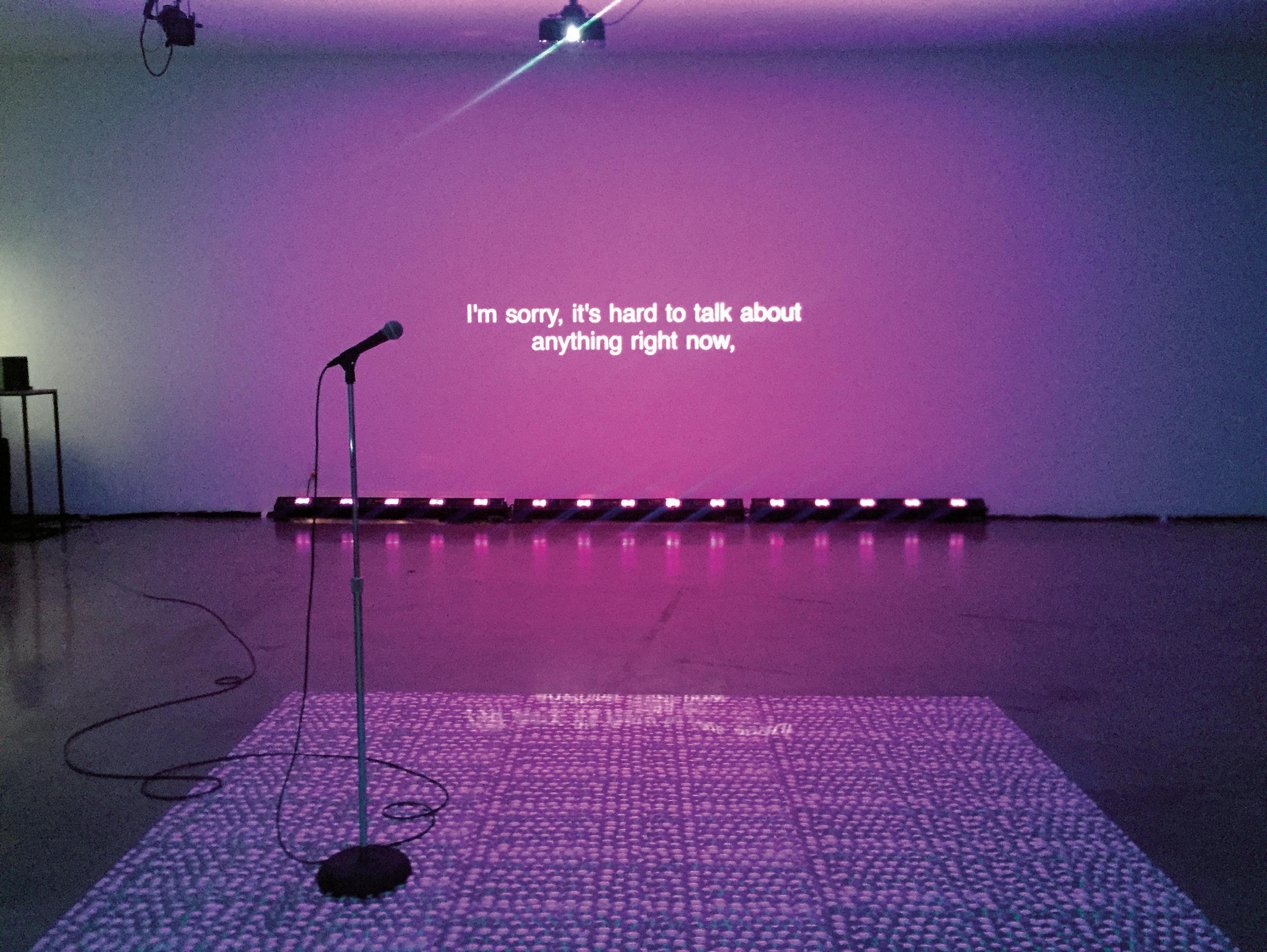
39
I never used, just looked at; and two regular chairs. I´m sorry, it´s hard to talk about anything right now, I´d rather tell you about simple and ordinary things that happen to me everyday. That it’s life the way it’s lived. You know how I am, always trying to stick to the border of things. Since everytime I think less and less. Because I only think about the edge of the things I think about. Just the fare enough no to look as an idiot. But the rest of the time I don´t think that much, only at the edge of the things I think about.
You know? It´s all about affection. I´m trying to place in front of you the true likeness of that which is beloved. And that´s why I´m writing now, since I cannot skype nor listen to your voice anymore. Leaving home has been quite a shock, mainly leaving you. Yes, I know. I think to myself, Mercedes take your time; try not to see bleak things bleakly. But that´s not easy. You know how I am.


Remember when we went to the delta? I turned thirty and wanted to be far away from everything. So we rented that house sorrounded by water. Raúl, the landlord, was already in his late seventies and gave me that map that he drew himself with a green pen. Remember that map? Drawn with love and sordidness, it was a messy map and had many corrections. The plant was an irregular grid, divided into eight squares and said: grill, counters, kitchen, written with c, tools written with one o, bathroom, terrace written with s and a single r, room written with one o, room written again, written with one o, again. I liked those missppellings. They made me value genuine expression above correct language and technical perfection. In fact, I brought that map from Buenos Aires to keep it as something special, as it would keep some misterious explanations about how to planify things. You know, It´s all about metaphor. It´s all about everything that exist beyond the rational self. To me, those words had to do something; trust me sister, those words have to do something, even now.
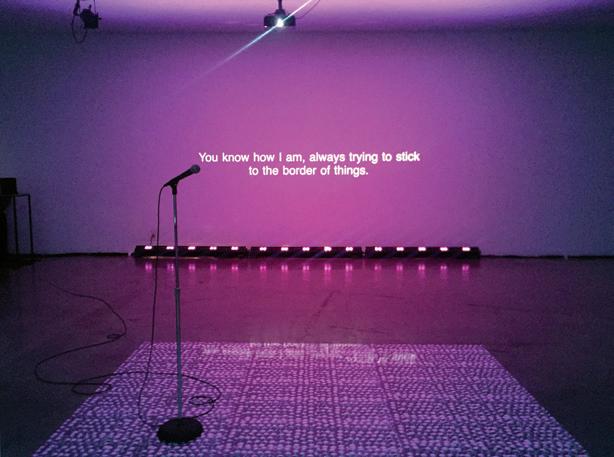
40
Sí, con vos acá sería mejor. No sabés cuánto te extraño. Estoy viviendo en un exconvento acá en Rotterdam. Es un lugar tranquilo, con una atmósfera especial, parecido a los retiros que solíamos hacer en casa cuando íbamos al colegio. ¿Te acordás de aquellos días? Pasábamos largos fines de semana solitarios, casi sin hablarnos. Acá también he pasado la mayor parte del tiempo casi sin hablar, solo escribiendo y mirando por la ventana. ¿Sabés? Mi espacio, aparentemente tan particular e íntimo, parece no tener ni centro ni límite. Un espacio sin tiempo que fluye y alberga un sinfín de pensamientos.
El cuarto tiene alrededor de 30 m2 y dos grandes ventanas que dan a la calle. Tengo una vista hermosa a una iglesia, rodeada de árboles. Los primeros días siempre pensaba que había alguien dentro de la iglesia, mirándome; porque podía ver, a la distancia, una figura con una vela o lucecita. En algún punto hasta pensé que era una alucinación. Pero después me di cuenta de que no se movía y que era una figura religiosa, probablemente una escultura decadente de fines del siglo XIX. Además, dependiendo del momento del día, se veía a varias personas junto a esa escultura frente a mis ventanas. Muchas veces me imaginé que me estaban mirando, especialmente cuando me duchaba y después andaba desnuda por el cuarto. Entonces cerraba las cortinas grises para resguardarme un poco de esas miradas. Vos me conocés. Aún no me he liberado de la paranoia con la que vivimos en Buenos Aires. Esas cortinas grises me recordaban la frase de un pintor alemán que decía: “Es imposible pintar la miseria de la vida, excepto quizás de gris, para taparla”. Sí, lo sé, sigo dándole forma a un espacio mental para lidiar con una sensación confusa que deja la vida.
Volviendo al cuarto, tiene una cama grande, dos placares —en realidad tres, el tercero está lleno de cosas y tiene una llave que no cierra—, dos mesas: una al lado de la cama; la otra, donde trabajo con la computadora, y esa sí que es una mesa desordenada. Es saludable tener una
mesa desordenada. Además está el sillón rojo; una silla blanca y cómoda que nunca usé, solo he estado mirando; y dos sillas comunes. Disculpame, me cuesta hablar en estos momentos, prefiero contarte las cosas comunes y corrientes que me pasan todos los días. La vida tal como se la va viviendo. Sabés cómo soy, siempre tratando de mantenerme en la superficie de las cosas, ya que cada vez pienso menos y menos. Es que solo pienso en el borde de las cosas en las que pienso. Apenas lo suficiente para no parecer una idiota. Pero el resto del tiempo no pienso mucho, solo en el borde de las cosas en las que pienso.
¿Sabés una cosa? Todo pasa por el afecto. Sí, intento poner frente a vos la imagen auténtica de lo que uno ama. Y es por eso que te estoy escribiendo, porque no puedo contactarte por skype ni volver a oír tu voz. Fue duro irme de casa, y sobre todo dejarte. Sí, ya sé. Me digo: “tomate tu tiempo, tratá de no ver con tristeza las cosas tristes. Pero eso no es fácil. Sabés cómo soy”.
¿Te acordás cuando fuimos al delta? Cumplía treinta y quería estar lejos de todo. Entonces alquilé esa casa rodeada de agua. Raúl, el dueño de casi ochenta años, me dio aquel plano que dibujó él mismo con un lápiz verde. ¿Te acordás de aquel plano? Tenía muchas correcciones, dibujadas con afecto y sordidez. Ese sí que era un plano desordenado. La planta era irregular, estaba dividida en seis cuadrados y decía: parrilla, mesadas, cocina escrito con s, herramientas escrito sin h, baño, terraza escrito con s, habitación escrito sin h, habitación, otra vez escrito sin h. Me gustaron esas faltas de ortografía. Me hicieron valorar la expresión genuina por sobre el lenguaje correcto y la perfección técnica. De hecho, me traje de Buenos Aires ese plano para conservarlo como algo especial, como si encerrara explicaciones misteriosas sobre cómo planificar las cosas. ¿Sabés? Todo es una metáfora. Se trata de todo lo que existe más allá del yo racional. Para mí, esas palabras tuvieron un efecto; creéme, sister, esas palabras tienen un efecto, aún hoy.
41
Volver a casa expandiendo la voz / Back Home Expanding the Voice / 2012 / 2018
¿dónde estás? en el borde, al lado del escenario ¿te paso a buscar?
where are you?
on the shore, by the stage shall i pick you up?
Fragmentos del guion y still de video-animación
[Fragments from script, and video animation still]
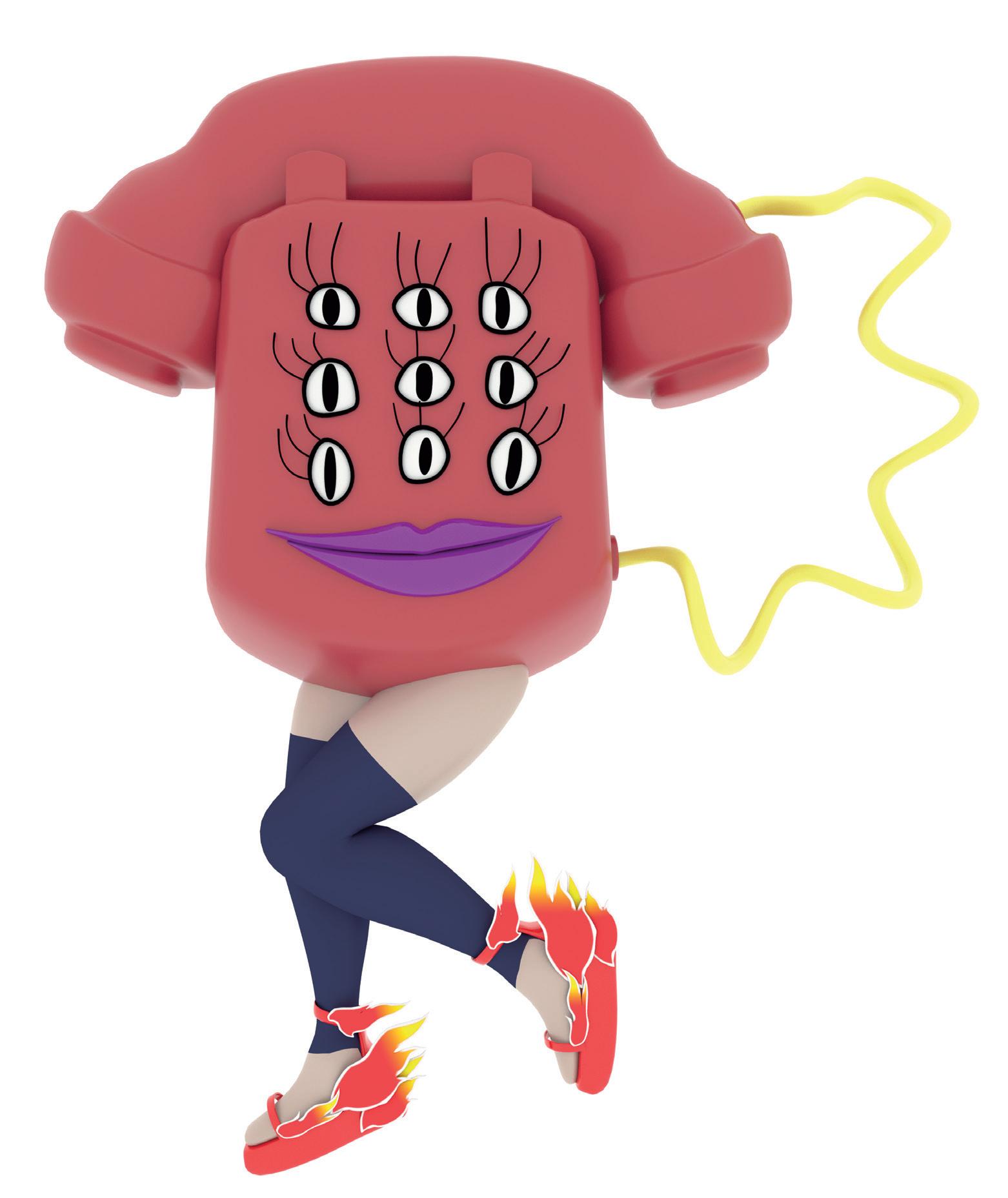
43
Fragmentos del guion y boceto de mnemónica visual [Fragments from script, and sketch of visual mnemonics]
44
¡Che! hay un montón de gente yendo a comprar arenque a las dos de la tarde you and me the companions of fear

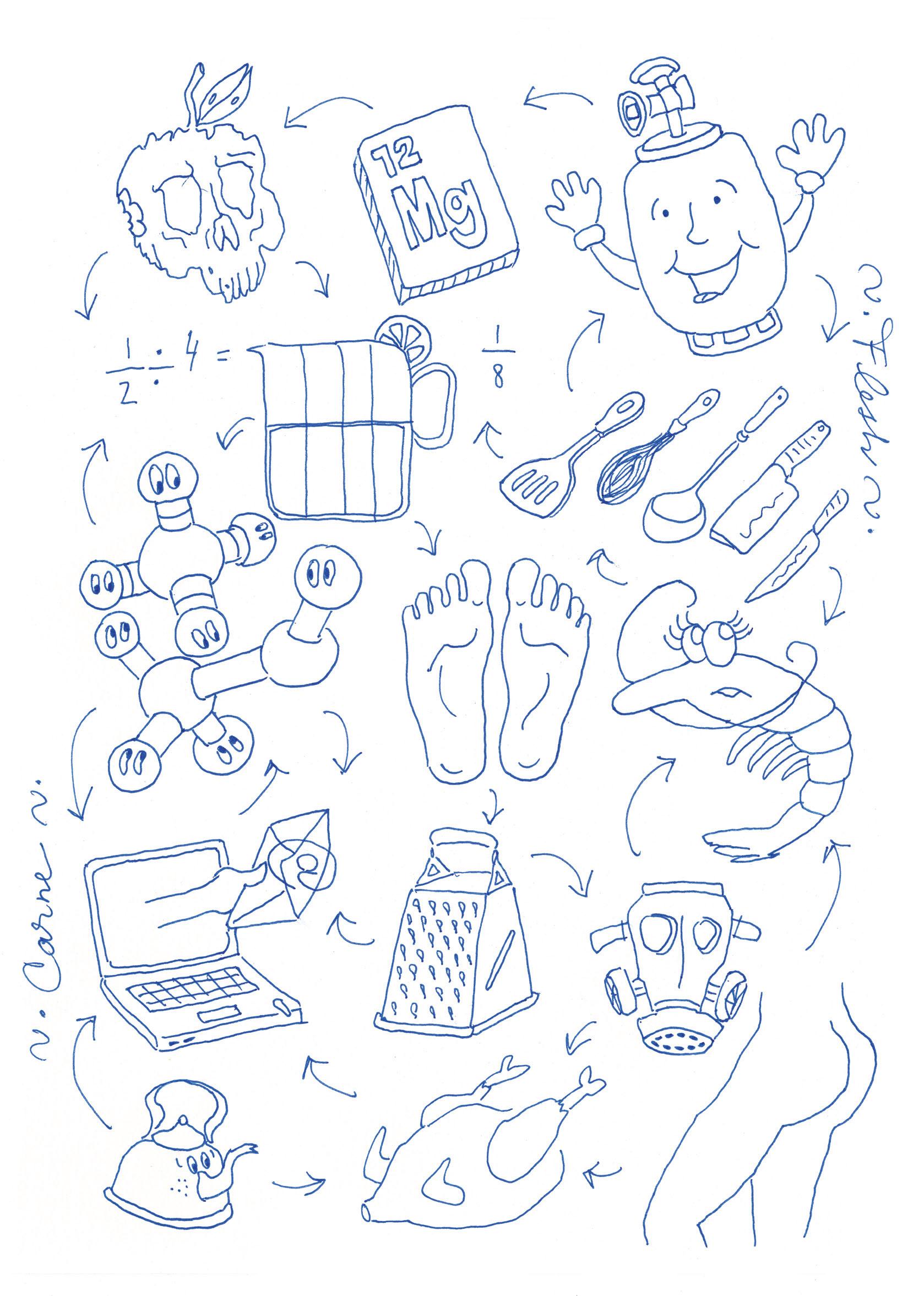
46 C arne / F lesh / 2013 / 2018
la langosta
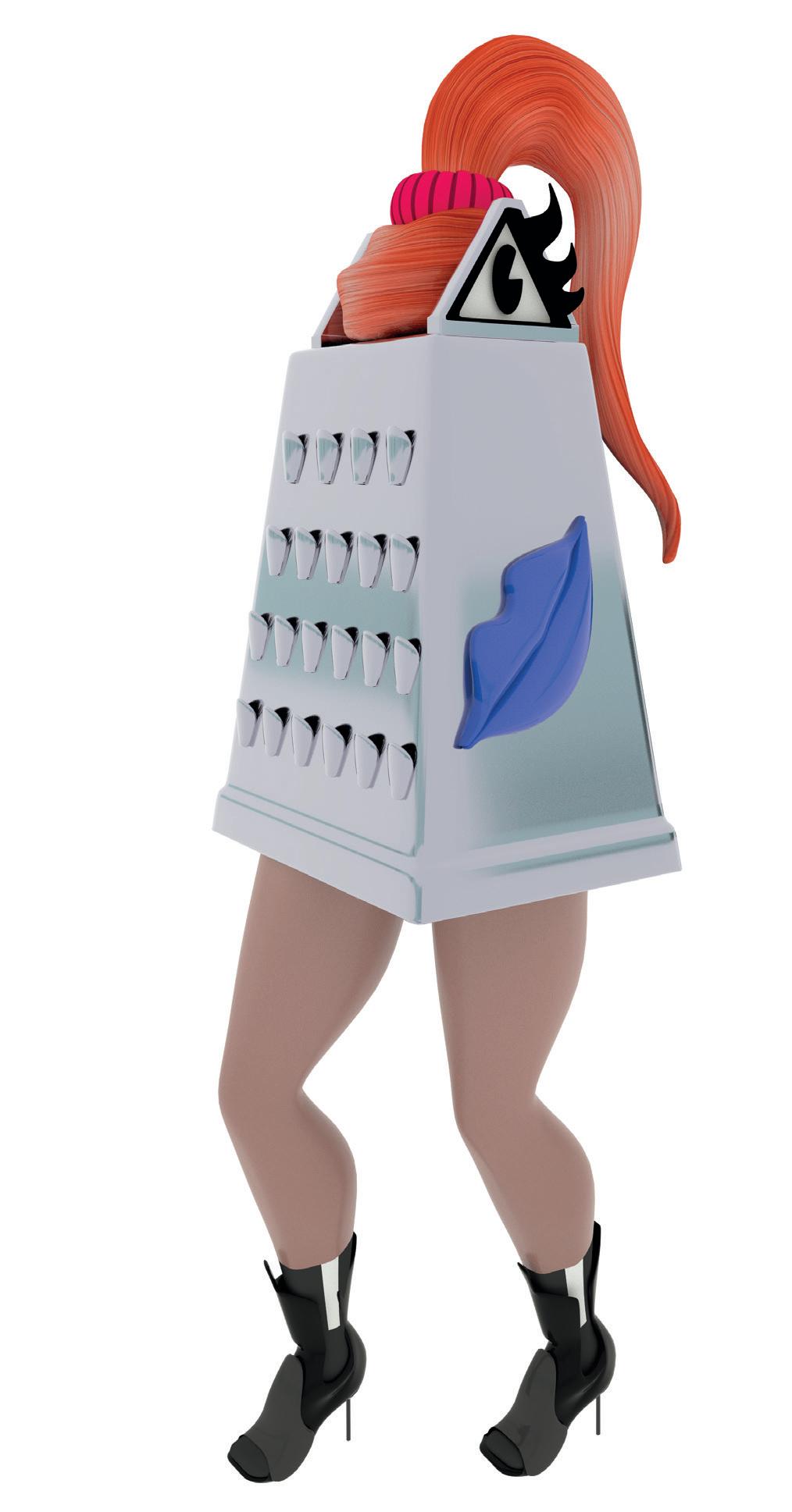
el camarón
las almejas la espátula el batidor de huevos las uñas la lengua el pelo ¡gracias!
con toda mi amistad
Boceto de mnemónica visual, fragmentos del guion y still de video-animación [Sketch of visual mnemonics, fragments of script, and video animation still]
47
La Calculadora Bien Templada / The Well-Tempered Calculator / 2013 / 2018
ella sueña despierta ella tiene poco autocontrol
ella siempre parece tener prisa ella puede ser olvidadiza
Fragmentos del guion, still de video-animación y boceto de mnemónica visual [Fragments of script, video animation still, and sketch of visual mnemonics]

48
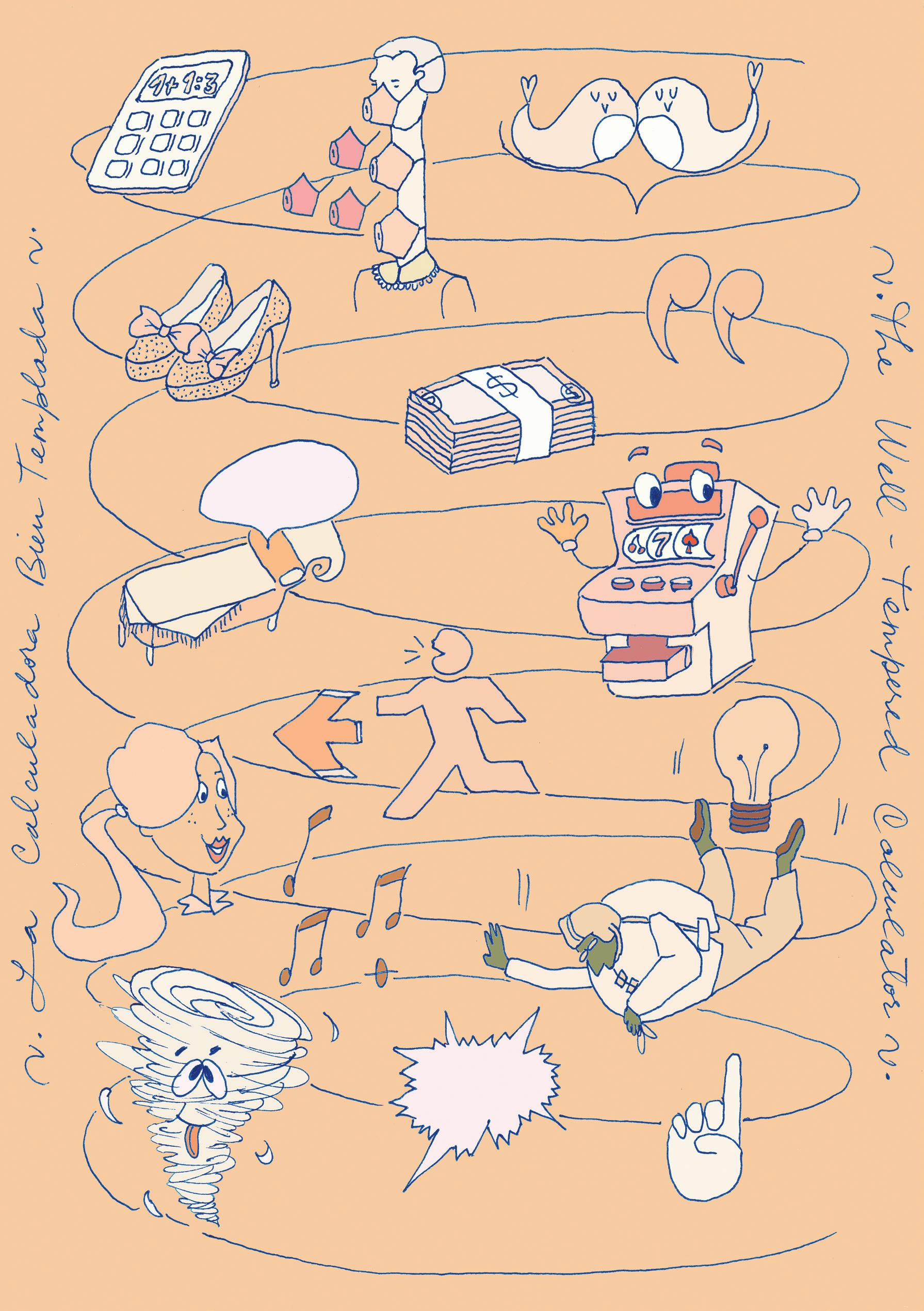

50 POW ! / 2014 / 2018
Boceto de mnemónica visual, fragmentos del guion y still de video-animación [Sketch of visual mnemonic, fragments of script, and video animation still]

51
ahí está el chuco ahí está el chuco metela metela metela metela metela metela metela metela metela metela
yegua-yeta-yuta / mare-jinx-pig / 2015-en curso [ongoing]
Boceto mnemónicas visuales y registro fotográfico de la performance presentada en CA2M, Madrid, 2018 [Sketch of visual mnemonics, and photographic record of performance presented at CA2M, Madrid, 2018]

52
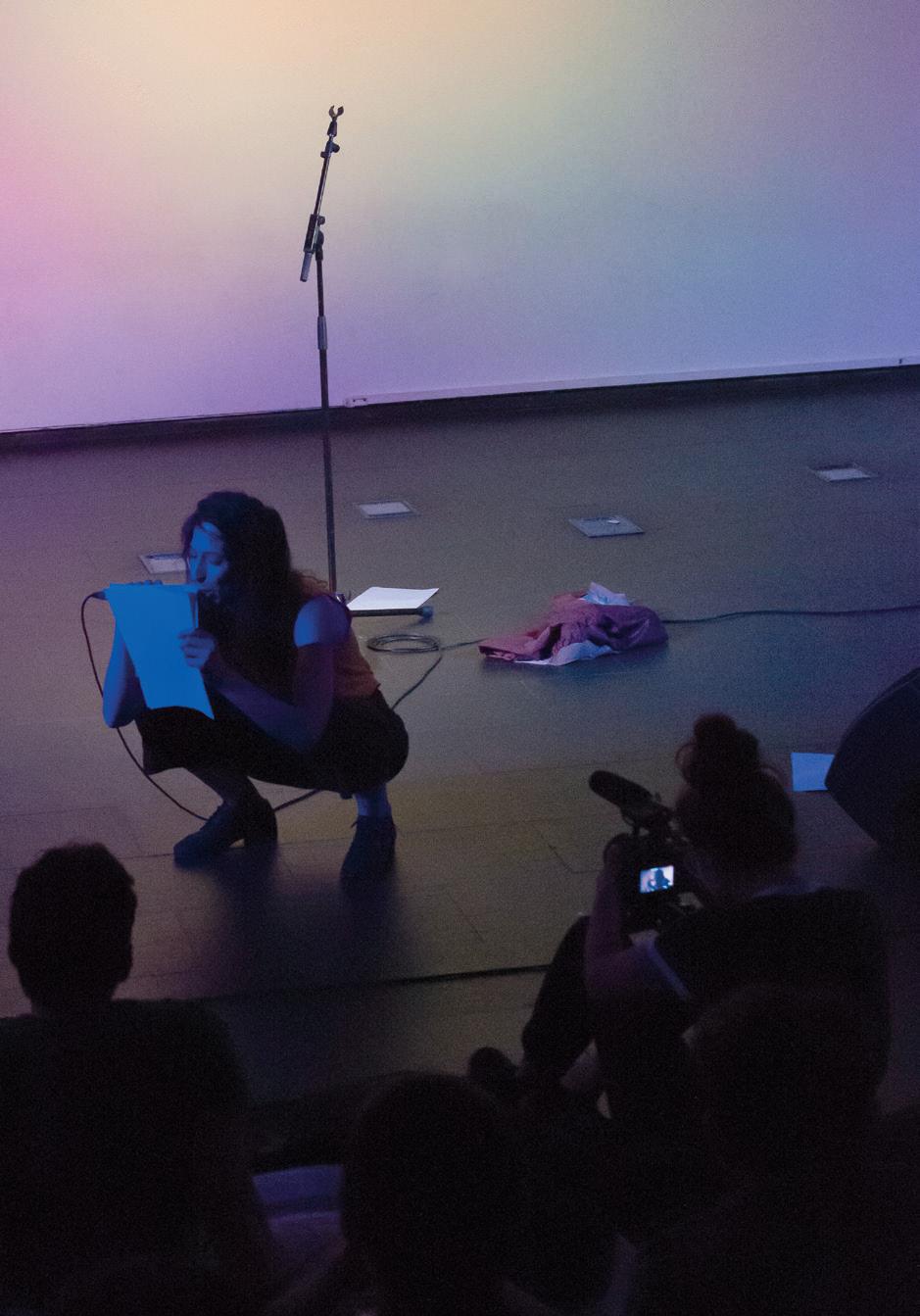
53
Bailarina Geométrica No Cree en el Amor, Encuentra Aspiración y Éxtasis en Espirales / Geometric Dancer Doesn’t Believe in Love, Finds
Aspiration and Ecstasy in Spirals / 2015
Instalación [Installation]
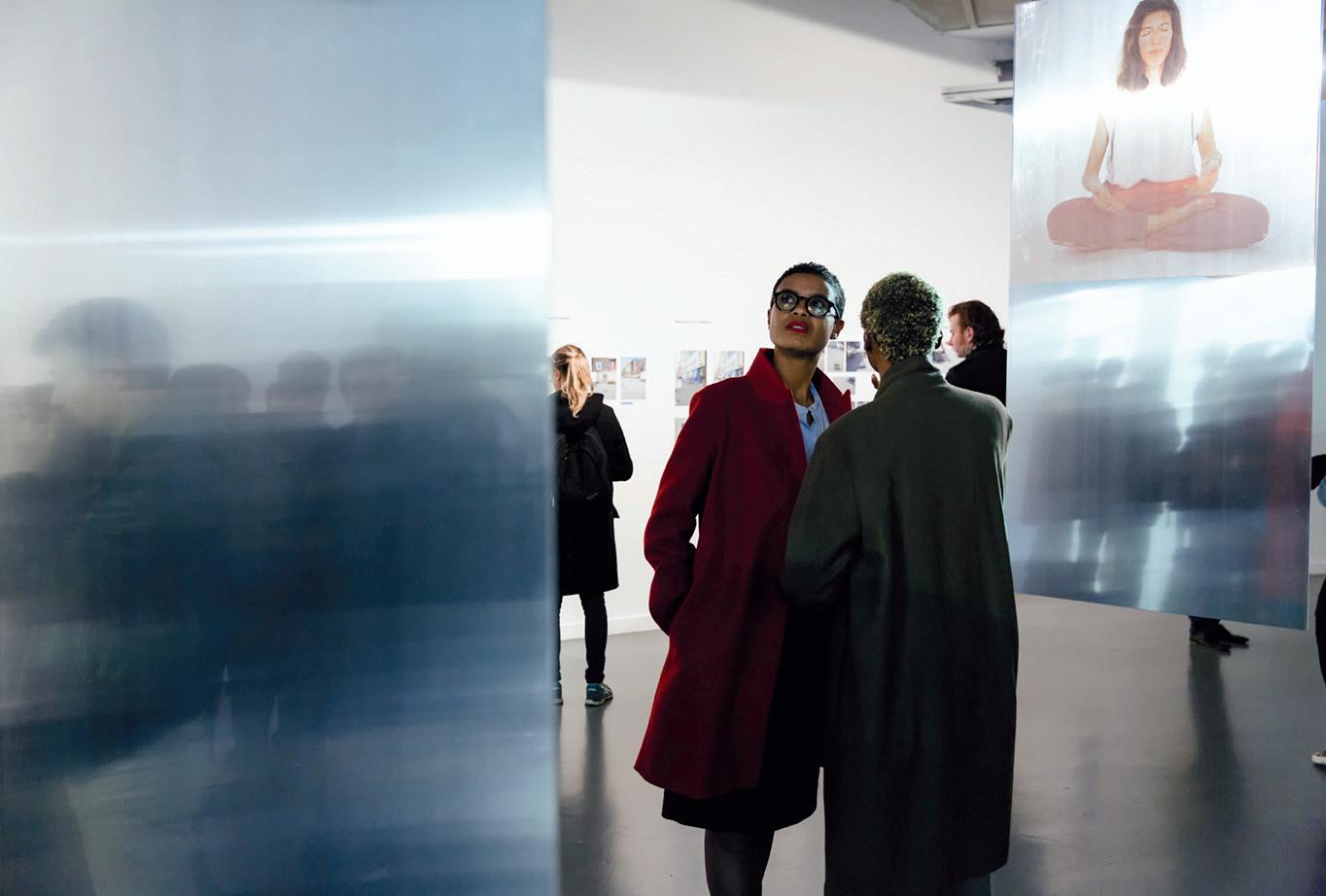
Dos proyecciones de video HD sincronizadas sobre hojas de aluminio [Two synchronized HD video-projections on aluminum sheets]
Derecha / Right: Impresión giclée sobre papel [Giclée print on paper]
84 × 60 cm
54
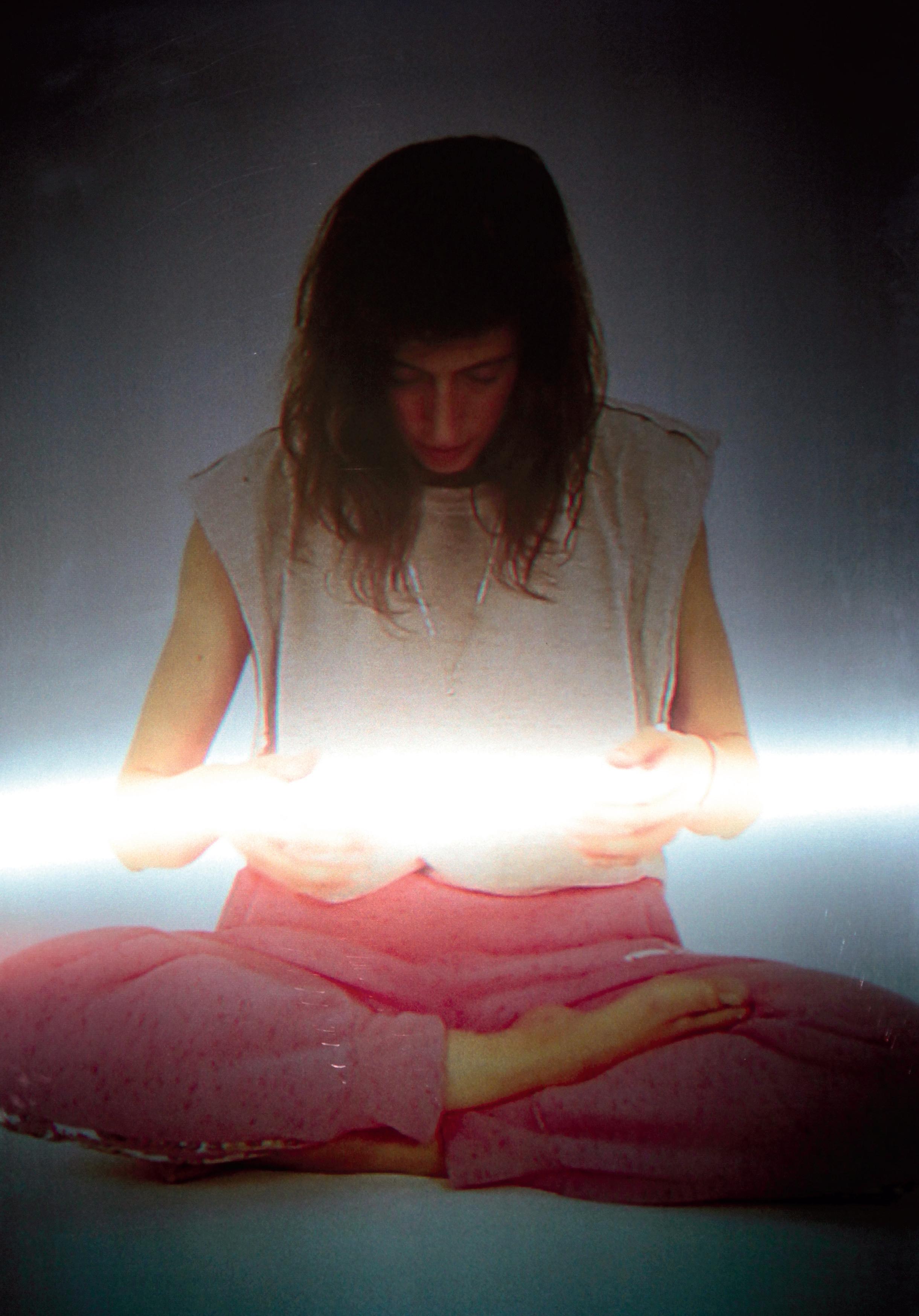

56
Valentine de Saint Point, 2016 Fotograbado sobre papel [Photo etching on paper] 30 × 21 cm
Derecha / Right: Mnemónica visual [Visual mnemonics], 2016 Impresión giclée y técnica mixta sobre tela [Giclée print and mixed media on canvas] 113 × 83 cm
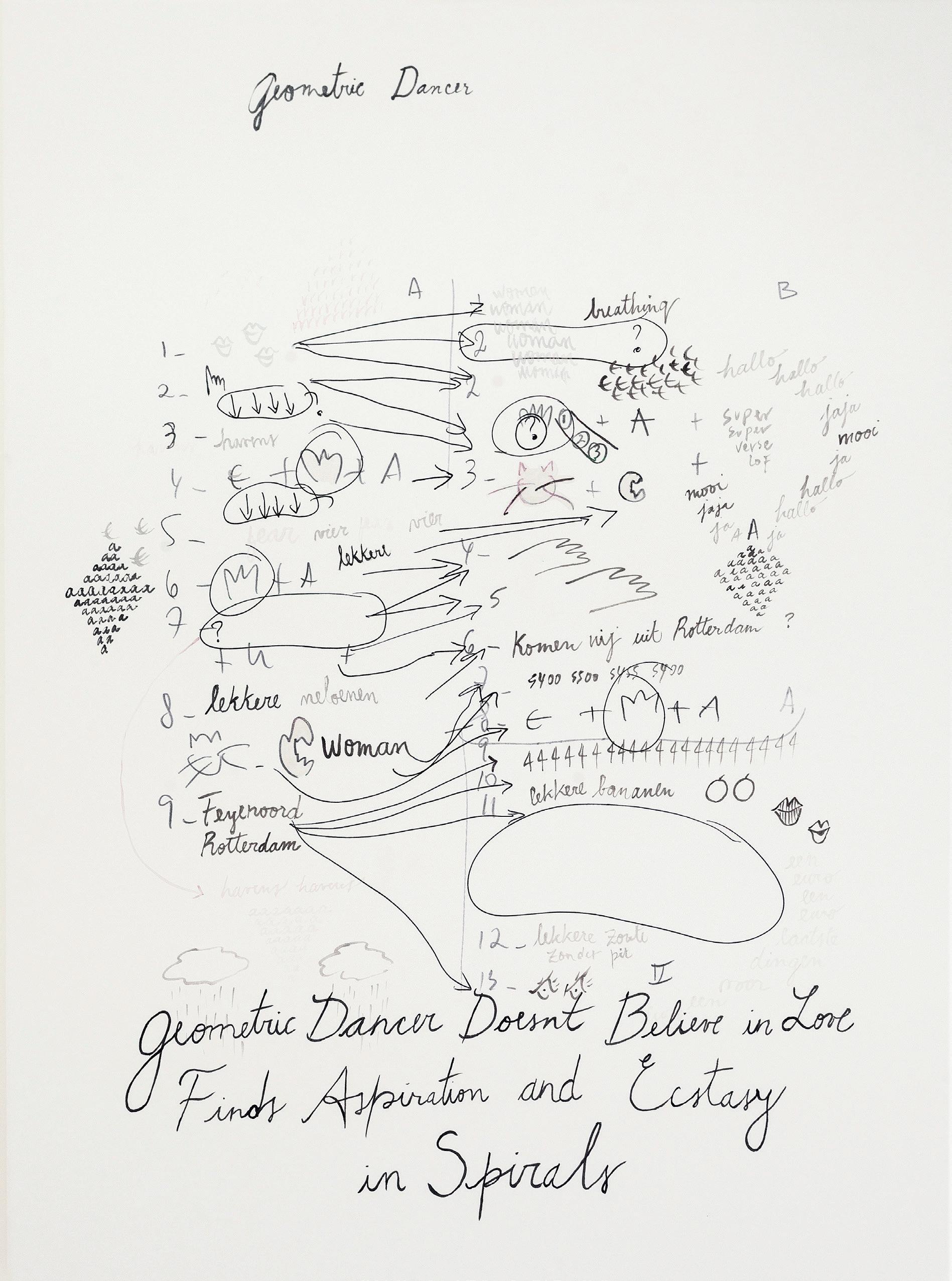
pp. 58-61: Mercedes Azpilicueta con el libro de Jennifer Montagu, The Expression of the Passions: The Origin and Influence of Charles Le Brun’s “Conférence sur l’expression générale et particulière”, Yale University Press, Primera edición, 1994
[Mercedes Azpilicueta with Jennifer Montagu’s book The Expression of the Passions: The Origin and Influence of Charles Le Brun’s “Conférence sur l’expression générale et particulière”, Yale University Press, first edition, 1994].

Un Mundo Raro / A Rare World / 2015

59

60
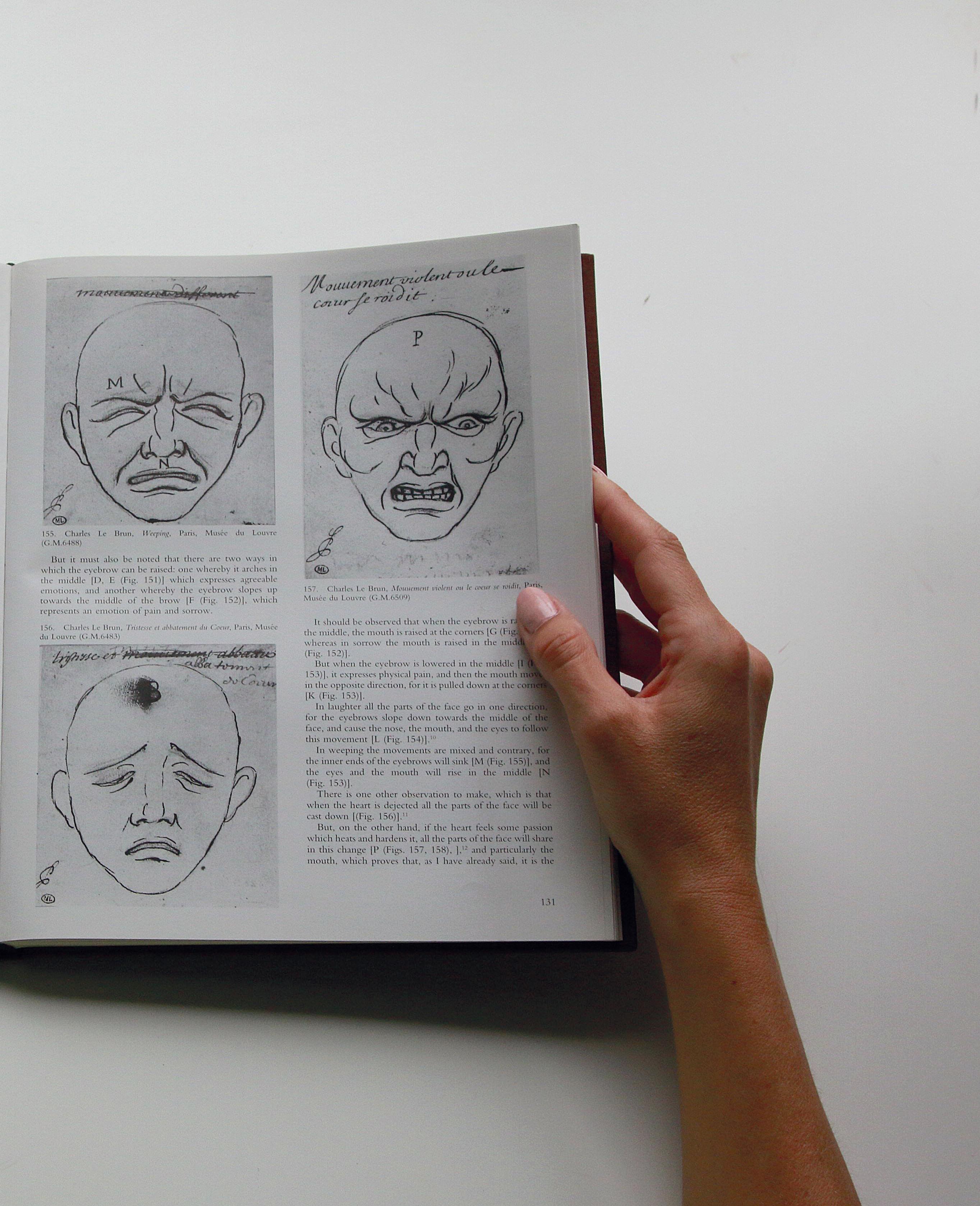
61
pp. 63-65: Un Mundo Raro [A Rare World], 2015 Registro fotográfico de la performance [Photographic record of the performance] Producido por [Produced by] RijksakademieOPEN 2015, Rijksakademie van Beeldende Kunsten, Amsterdam
62
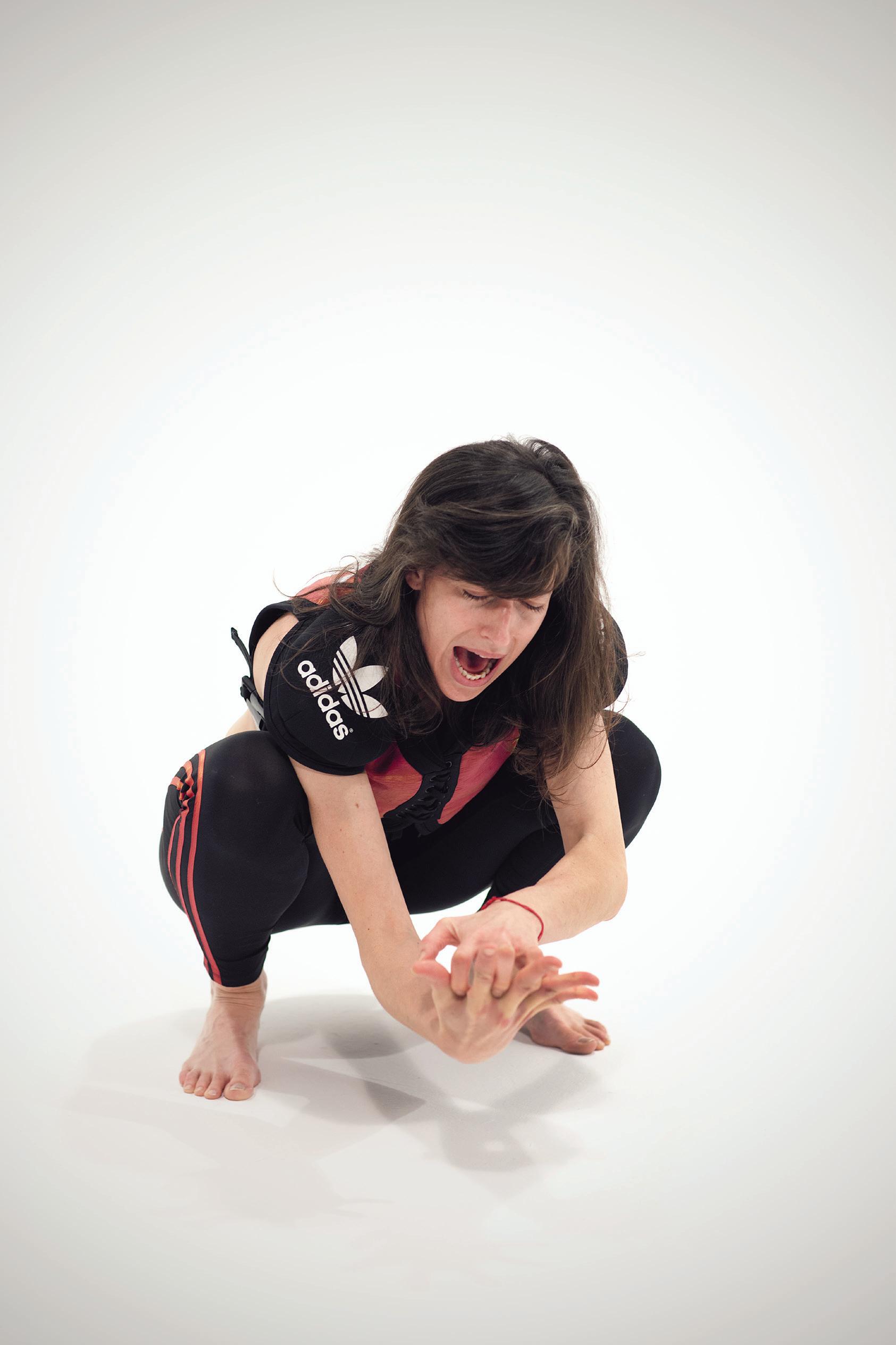


pp. 66-67: Proyección de video sincronizada en tres canales [Synchronized three-channel video projection]
Producida por [Produced by] RijksakademieOPEN 2015, Rijksakademie van Beeldende Kunsten, Amsterdam
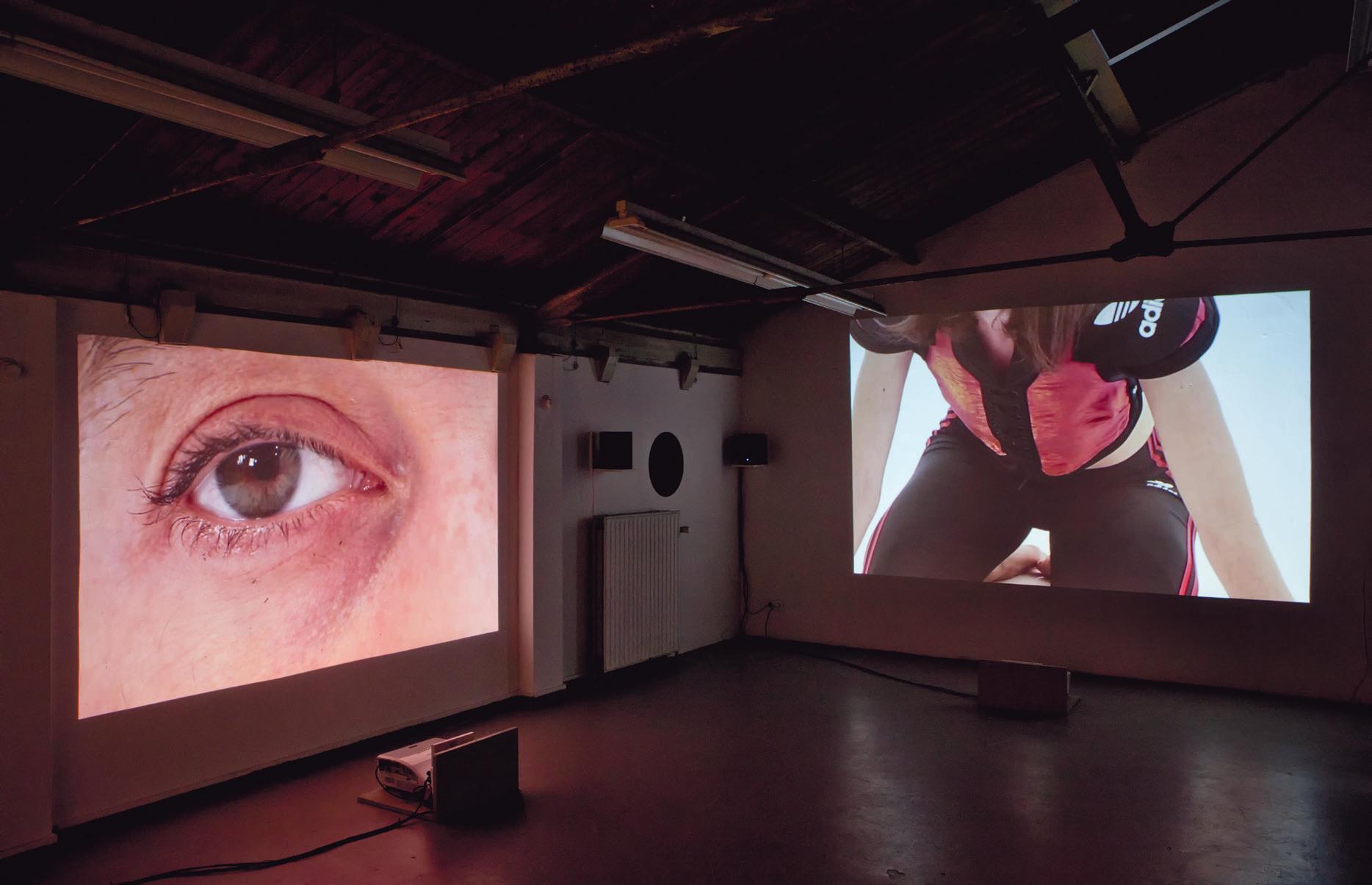
66

67
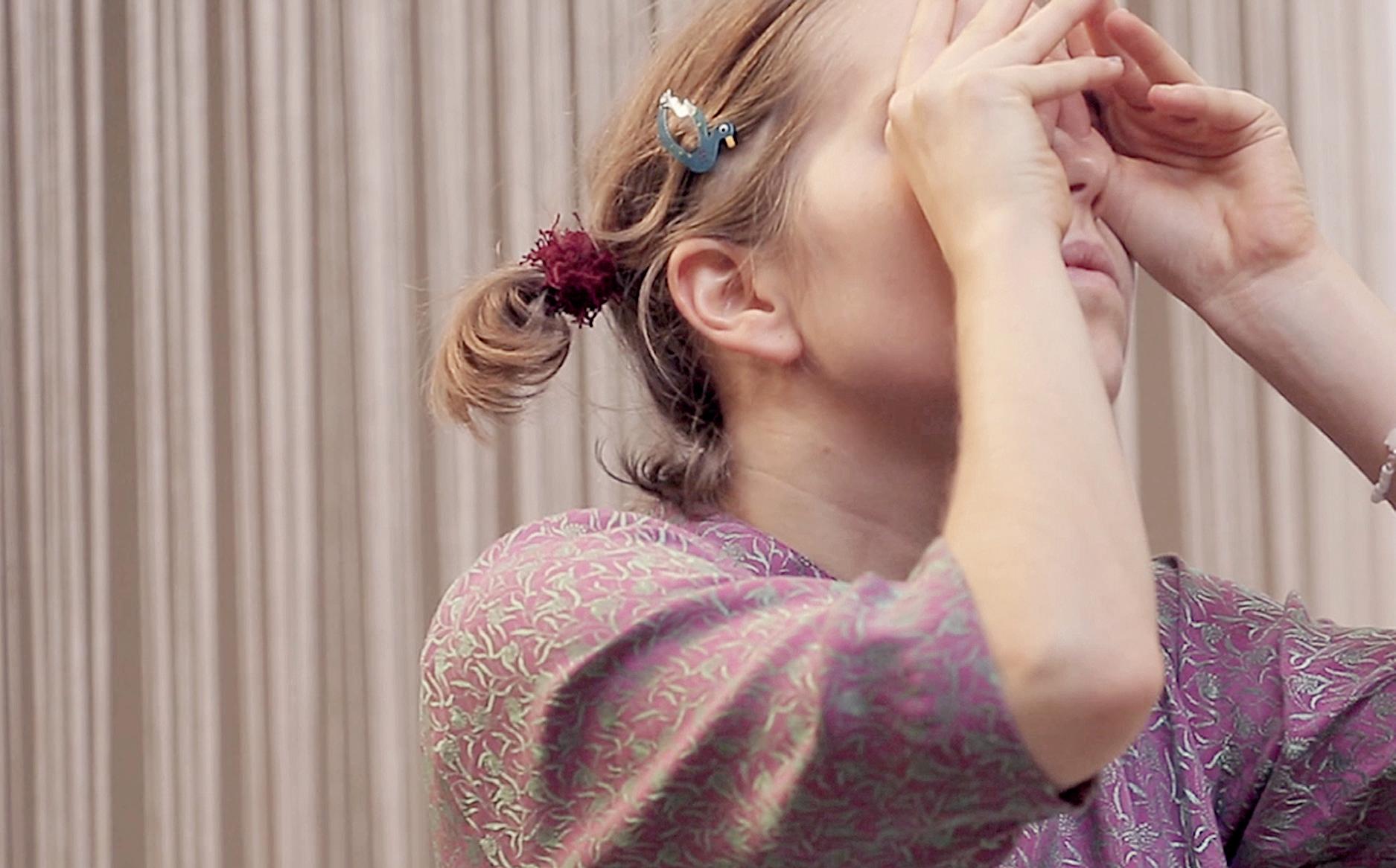
68 Molecular Love / Amor molecular / 2016
Stills de video [Video stills]
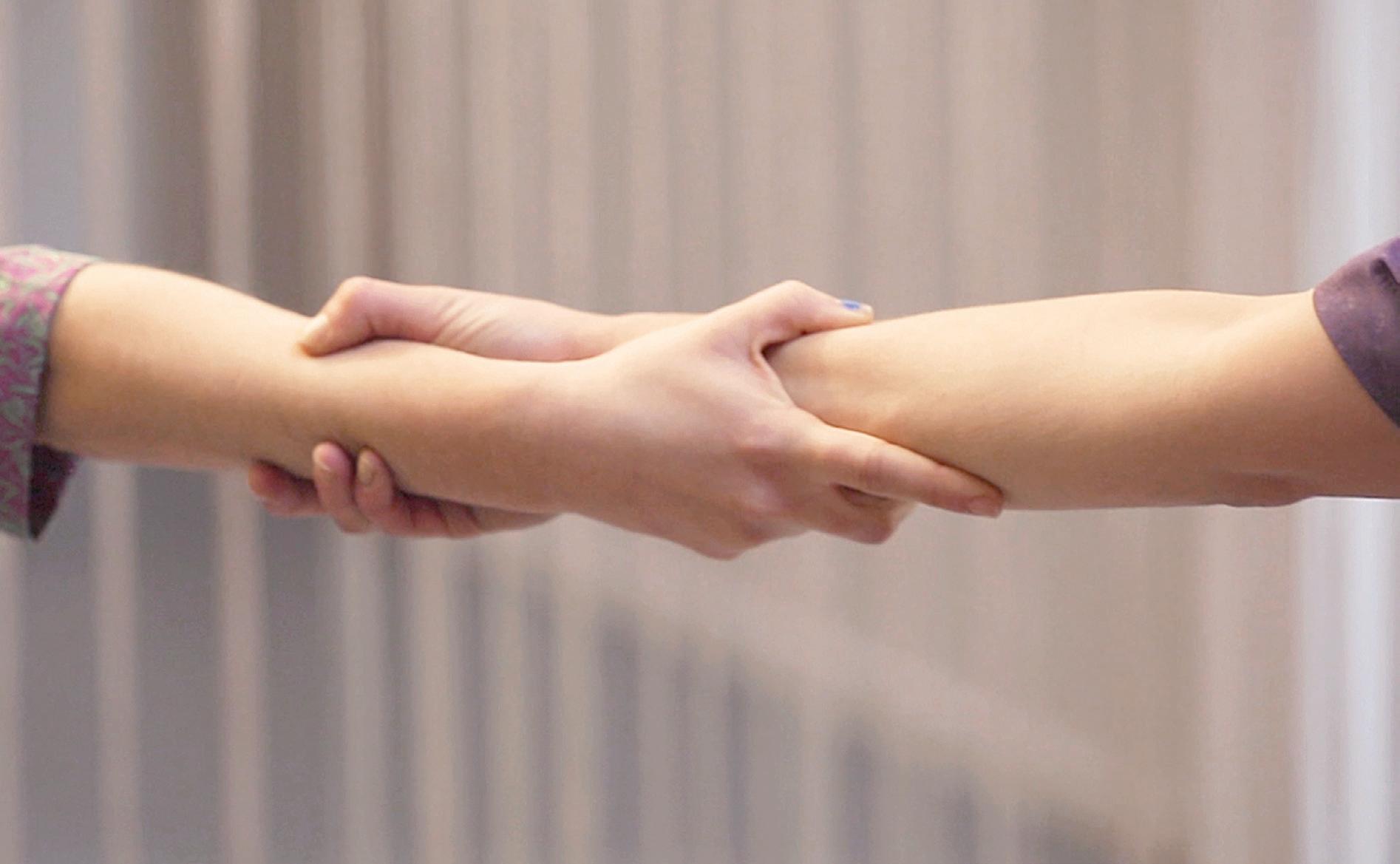
69
pp.72-81: Registro fotográfico de la performance [Photographic record of the performance]
Concepto y texto [Concept and text]: Mercedes Azpilicueta
Sonido [Sound]: Mercedes Azpilicueta, Anat Spiegel

Arreglos vocales [Vocal arrangements]: Anat Spiegel
Coreografía e interpretación por [Choreography and performance by] Mercedes Azpilicueta, Marion Bosetti, Madelyn Bullard, Alondra Castellanos Arreola, Setareh Fatehi Irani, Maria-Netti Nüganen, Eva Susova.
Producido por [Produced by] RijksakademieOPEN 2016, Rijksakademie van Beeldende Kunsten, Amsterdam
70
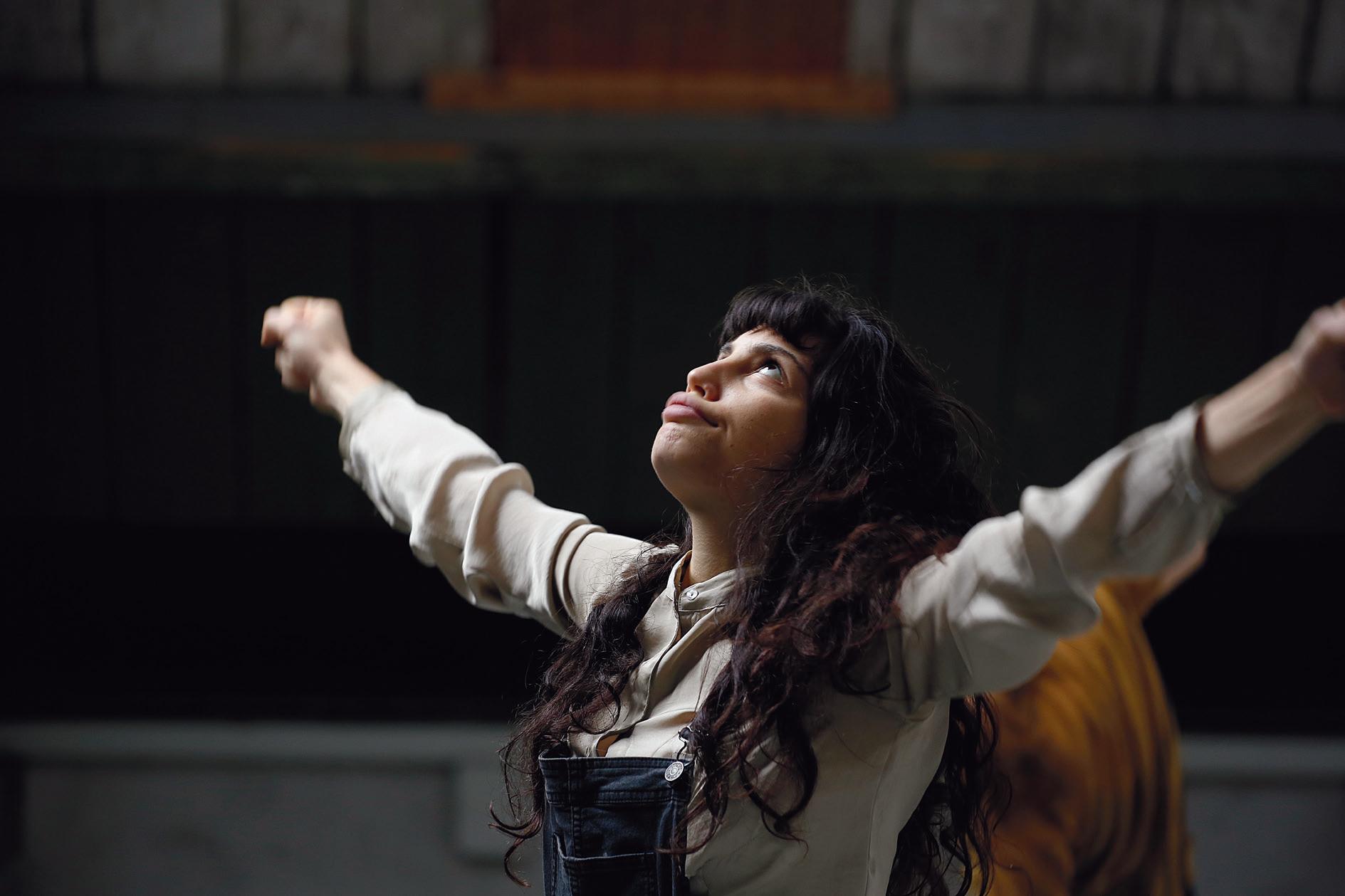
71

72

73


74

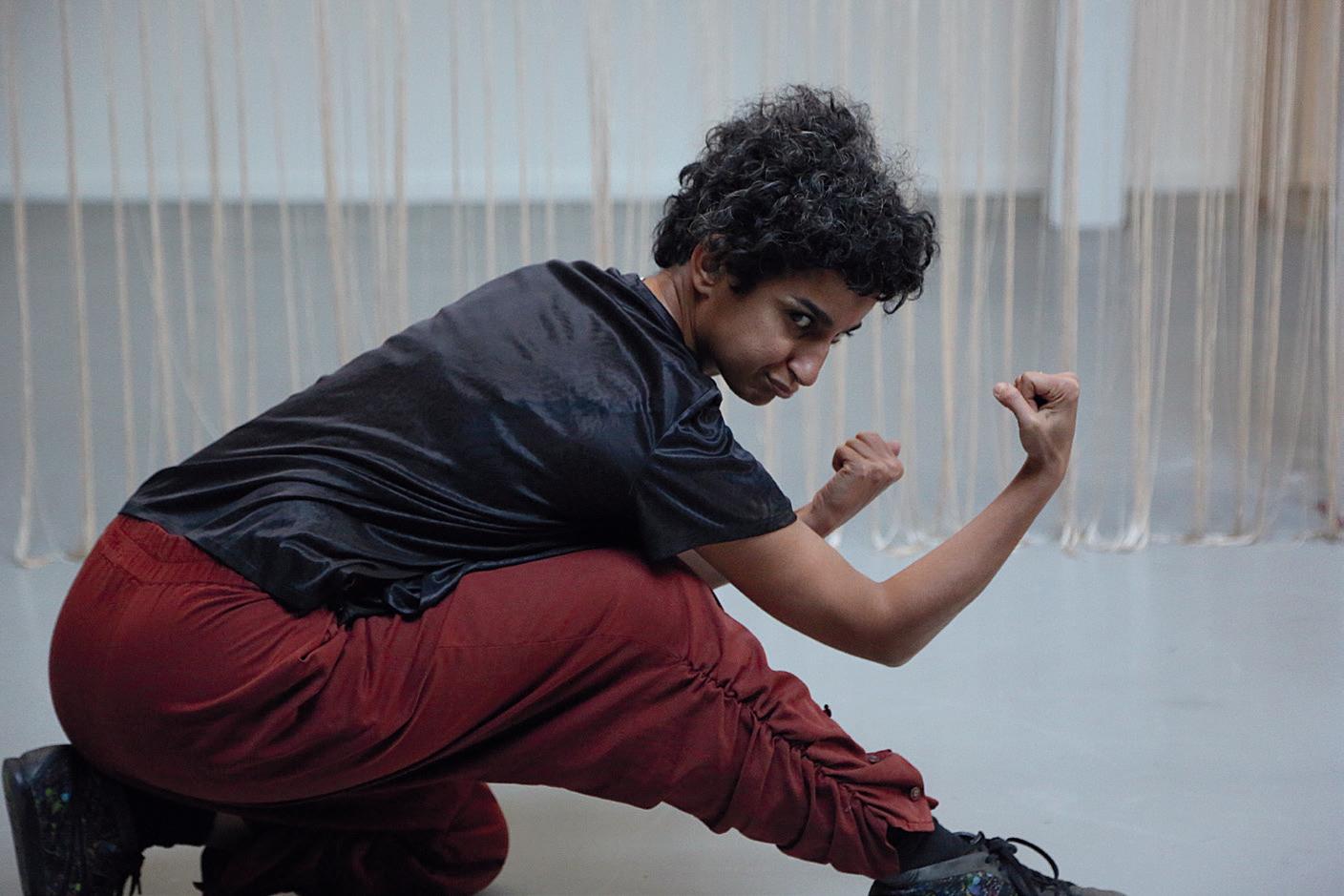
75
76

77

78

79
Bestiario de Lengüitas / Bestiaire of Tonguelets / 2017-en curso [ongoing]
Armadura suave I [Soft Armor I], 2018
Recortes de cuero reciclado y remaches [Recycled leather offcuts and rivet]
75 × 55 × 20 cm
Producido por [Produced by] Villa Vassilieff / Pernod Ricard Fellowship 2017, París
80
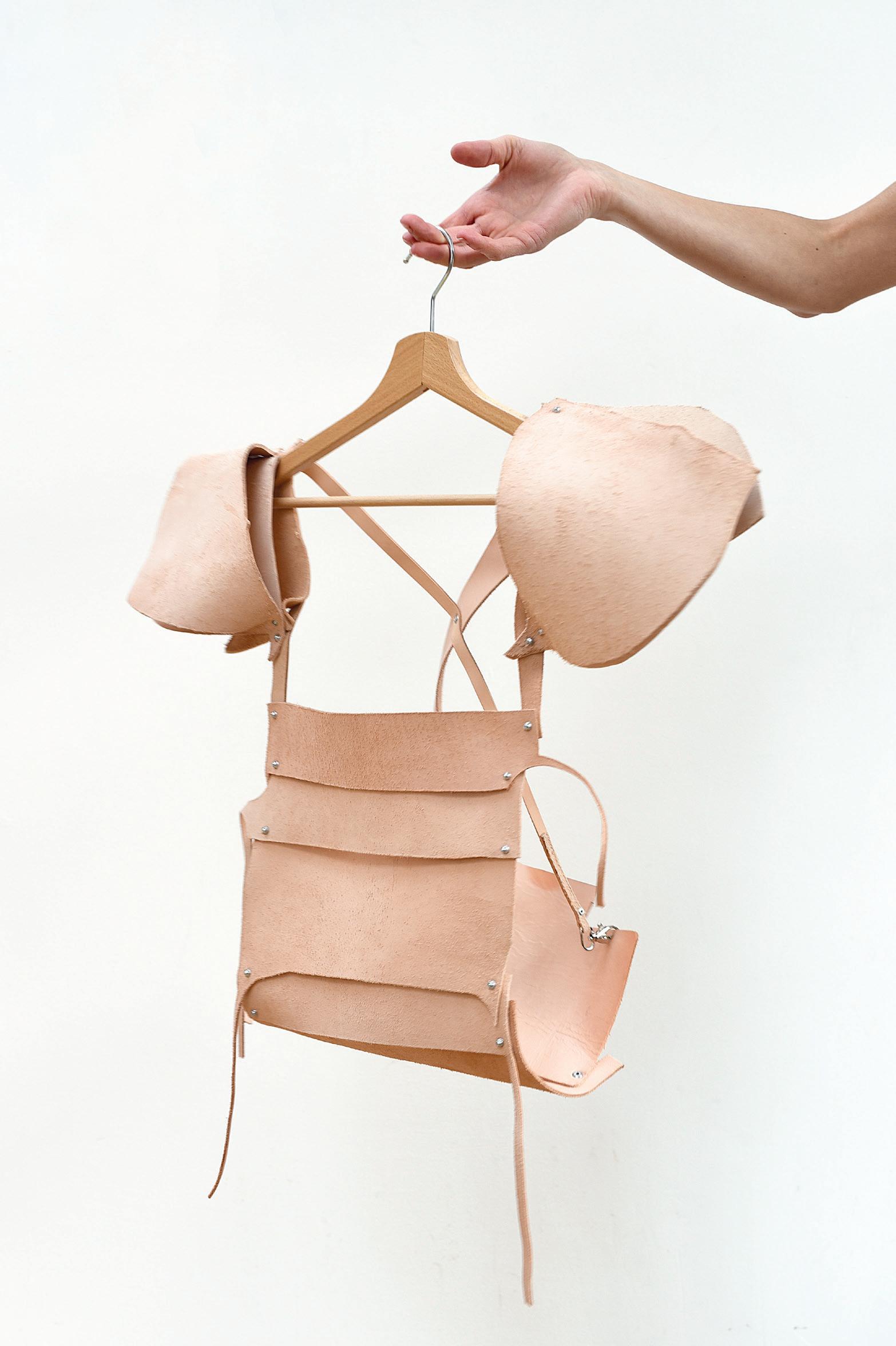
81
Instalación conformada por pelo, brazo, rodilleras, coderas, tumores y máscaras de látex y cuero [Installation made up of hair, arm, kneepads, elbow pads, tumors, and latex and leather masks] Medidas variables [Dimensions variable]
82

Bestiario de Lengüitas [Bestiaire of Tonguelets], 2017-en curso [ongoing]
Stills de video [Video stills]


Producido por [Produced by] Villa Vassilieff / Pernod Ricard Fellowship 2017, París
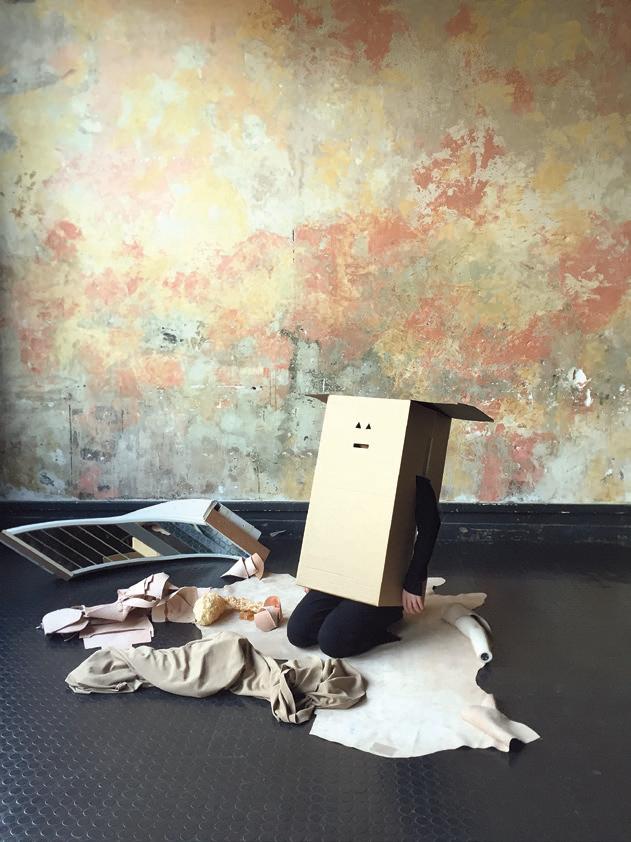
84

85
Still de video [Video still]
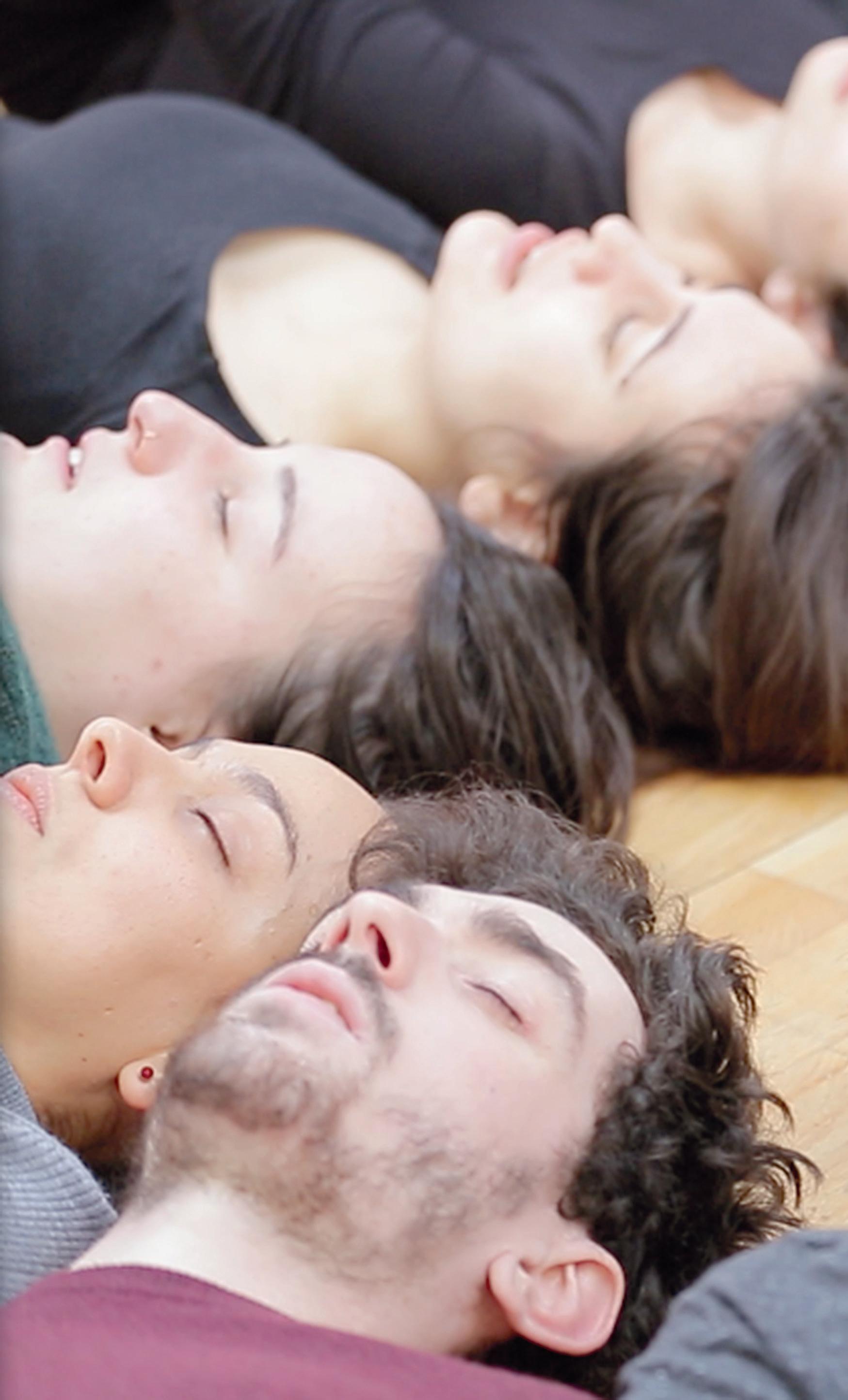
86
Producido por [Produced by] Villa Vassilieff / Pernod Ricard Fellowship 2017, Paris

87
pp. 88-91: Tinta sobre papel [Ink on paper]
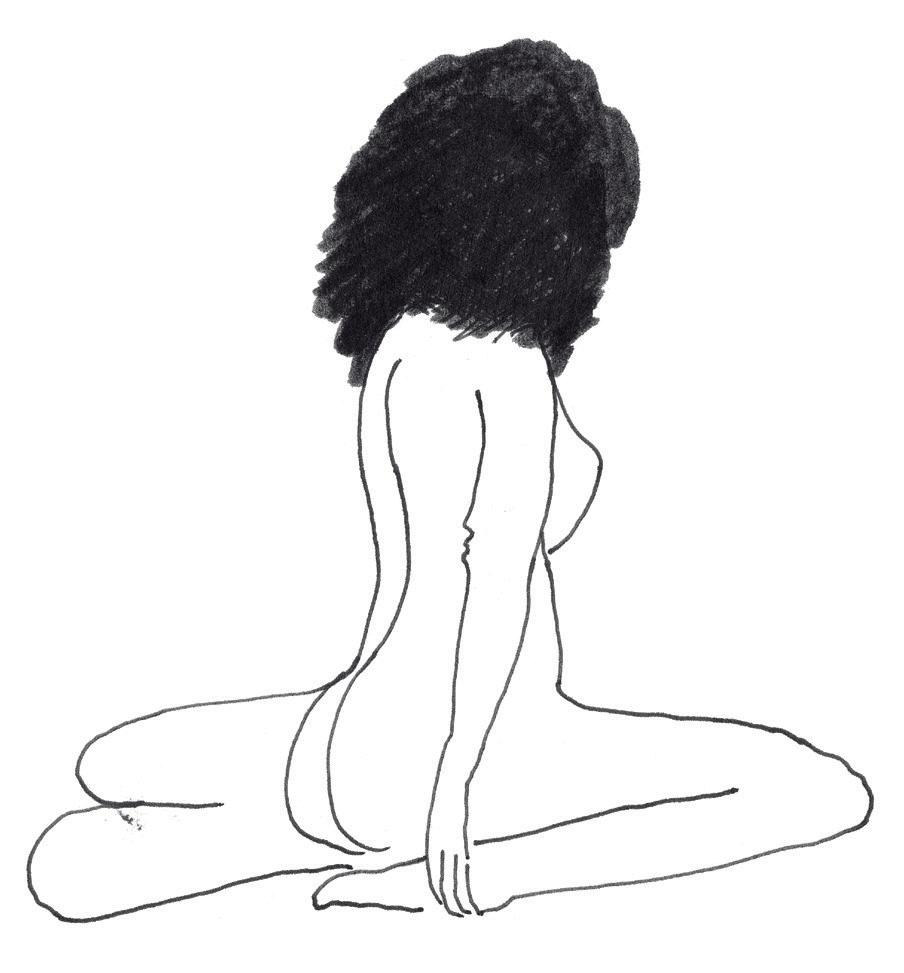

88


89


90

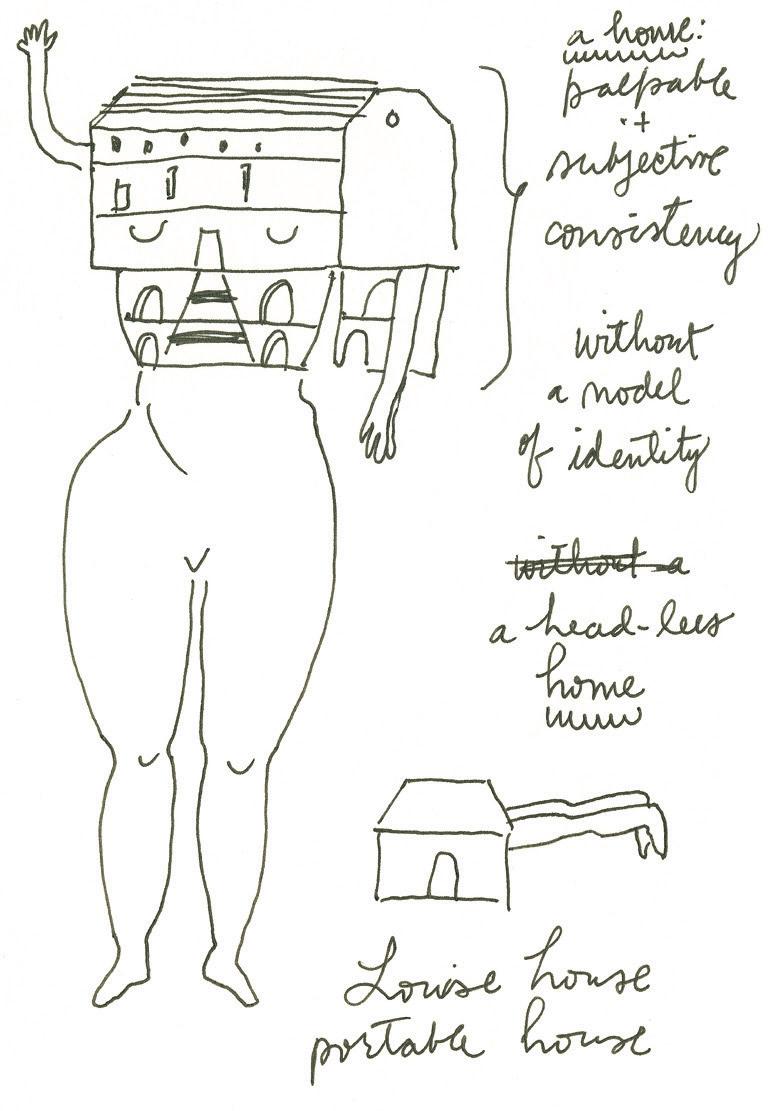
91
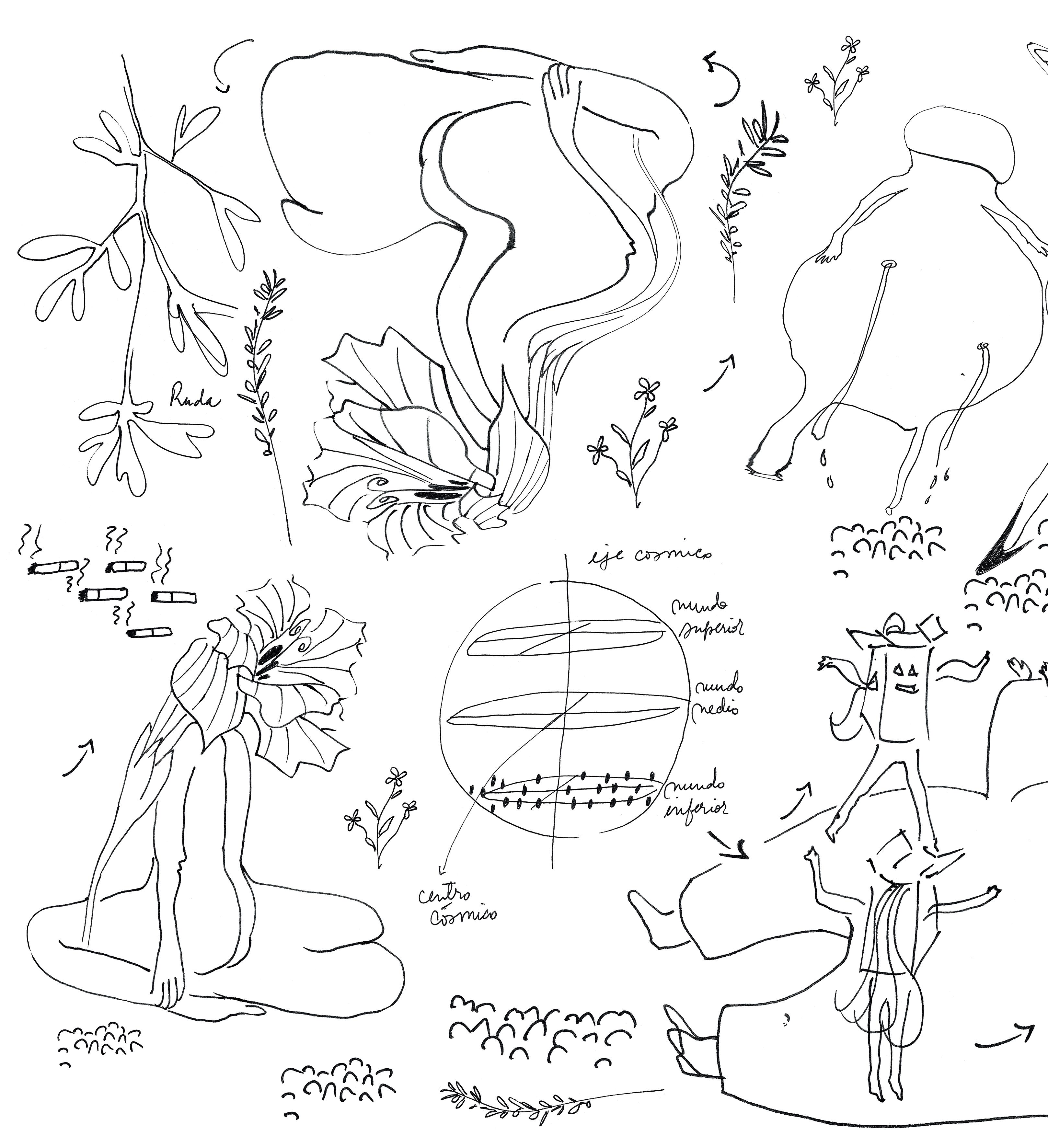
92

93 Wall paper Medidas variables [Dimensions variable]
Mercedes Azpilicueta con una postal del tapiz La Dama y el Unicornio (ca. 1500), que se encuentra en el Musée National du Moyen Âge, París
[Mercedes Azpilicueta with a postcard of the tapestry The Lady and the Unicorn (c. 1500), in the Musée National du Moyen Âge, Paris]
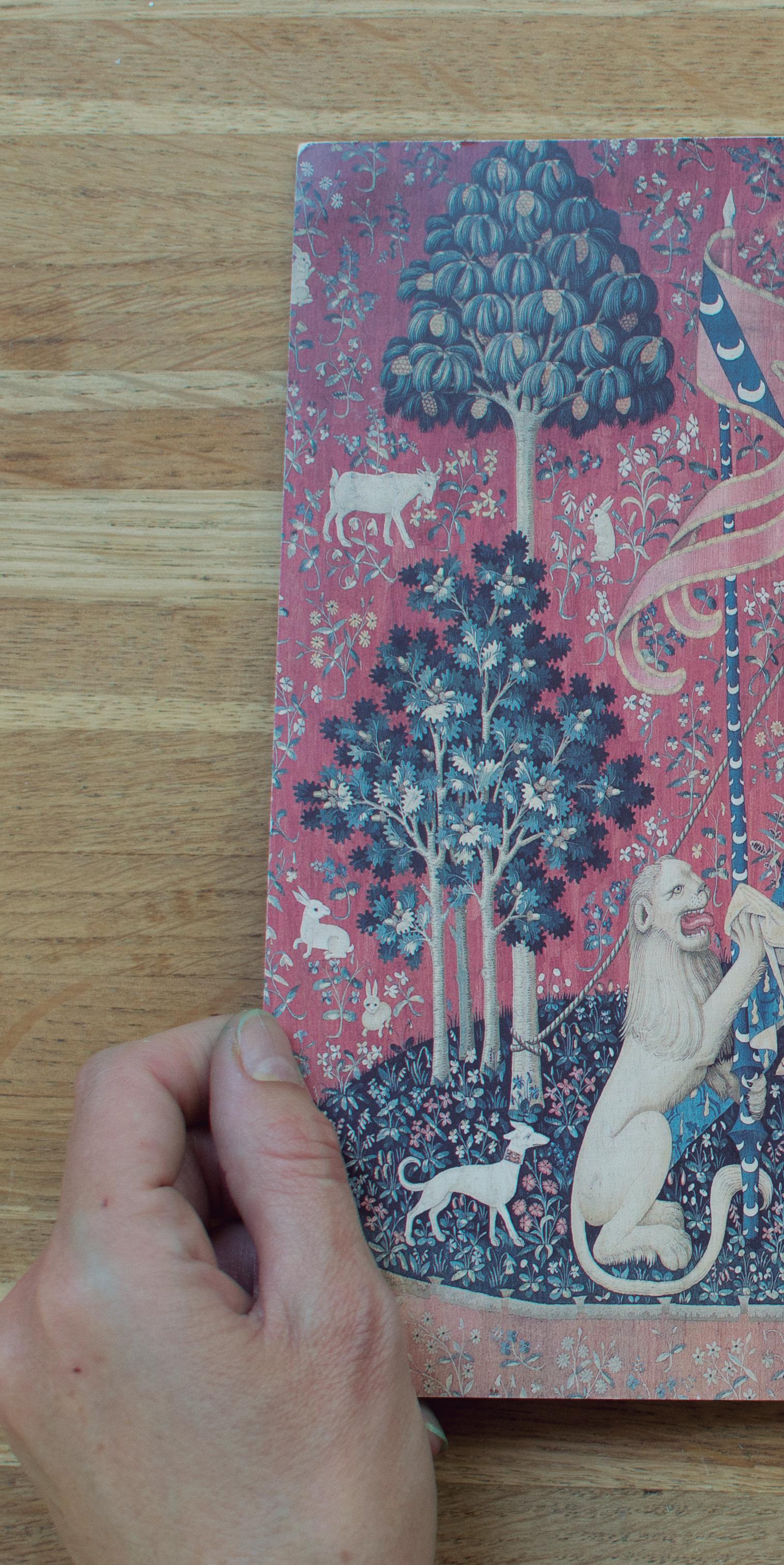

Cuerpos Pájaros / Body-Birds / 2018

96
Mercedes Azpilicueta con la revista Cahiers du cinema
[Mercedes Azpilicueta with the journal Cahiers du cinema]

97

98
Still de video de la instalación Cuerpos Pájaros [Video still of the installation Body-Birds]
Mercedes Azpilicueta con la imagen de la obra Judith decapitando a Holofernes, de Artemisia Gentileschi (ca. 1620), 2018 [Mercedes Azpilicueta with the image of the artwork Judith Beheading Holofernes, by Artemisia Gentileschi (c. 1620), 2018]

99
pp. 102-113: Stills de video de la instalación Cuerpos Pájaros
[Video stills from the installation Body-Birds]

Proyección de video sincronizado en tres canales [Synchronized three-channel video projection]
Producido por [Produced by] Museo de Arte Moderno de Buenos Aires
100


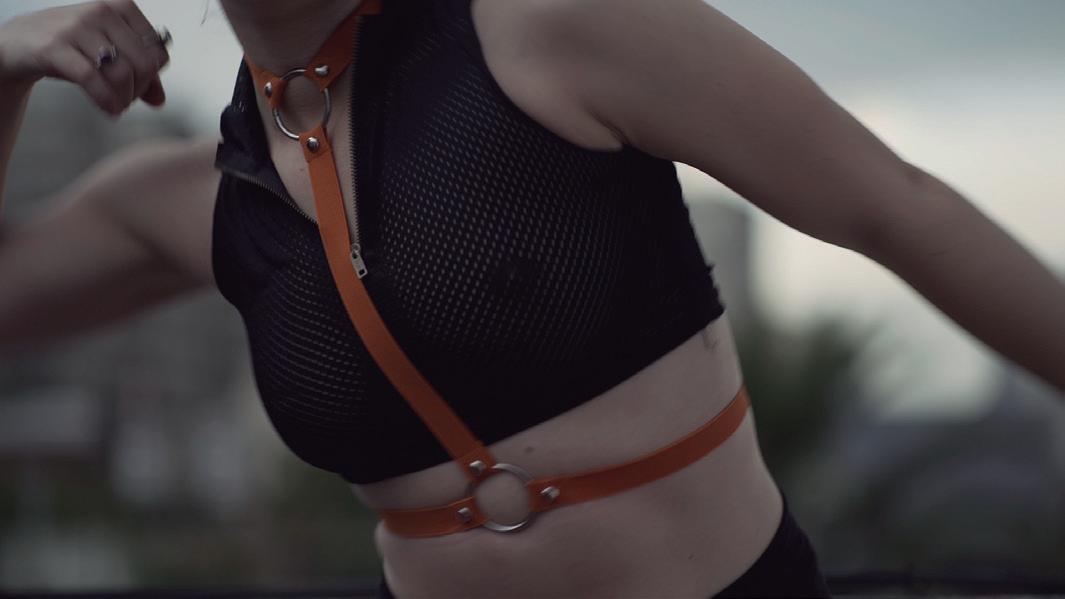
101
ella resiste resiste siempre con la palabra resiste con el cuerpo resiste siempre con el cuerpo
102
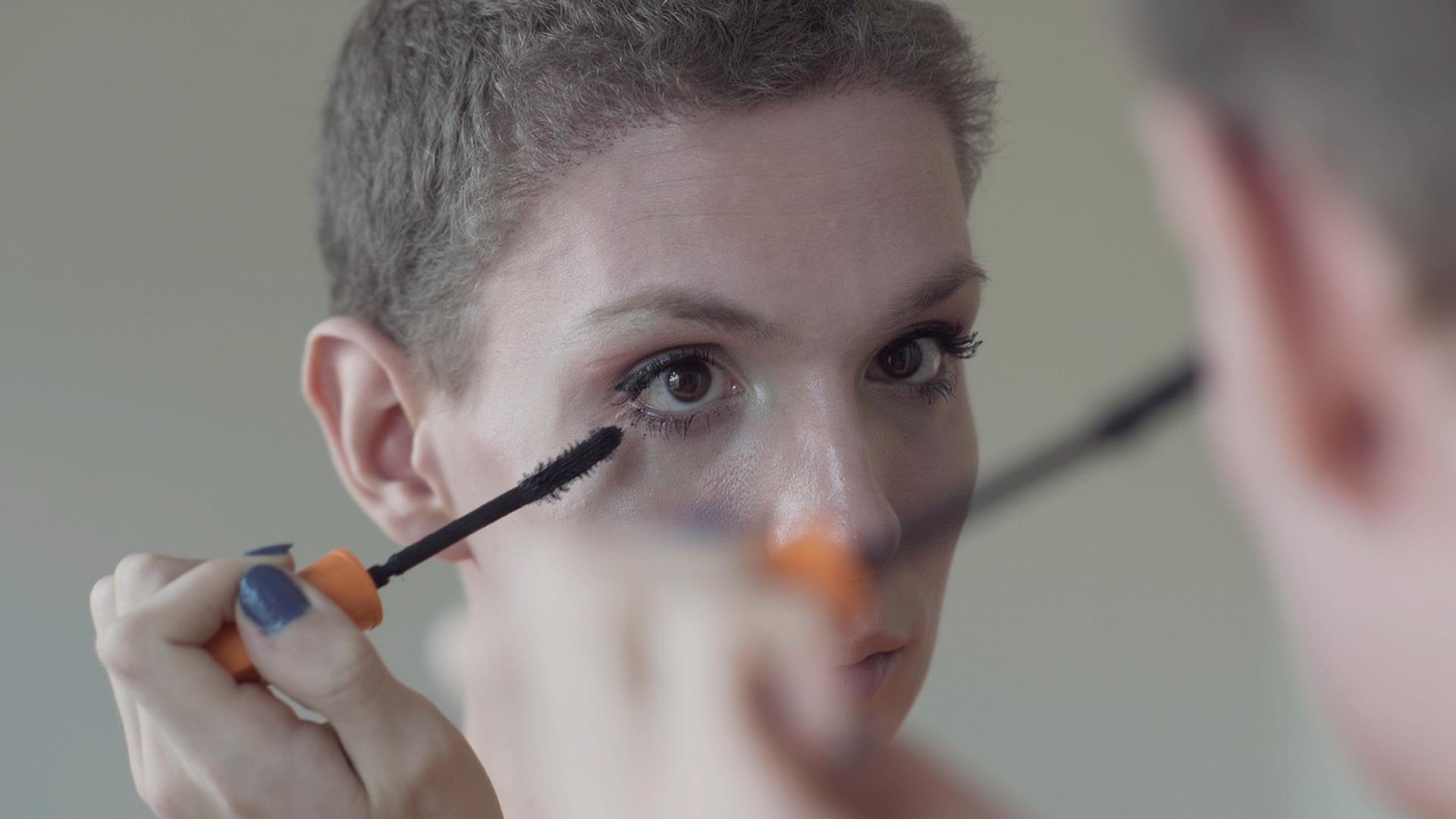
103
y aunque estas imágenes
no quieran mostrar nada en particular igual son efecto son afecto son otro lugar son tiempo
104


105

106

107
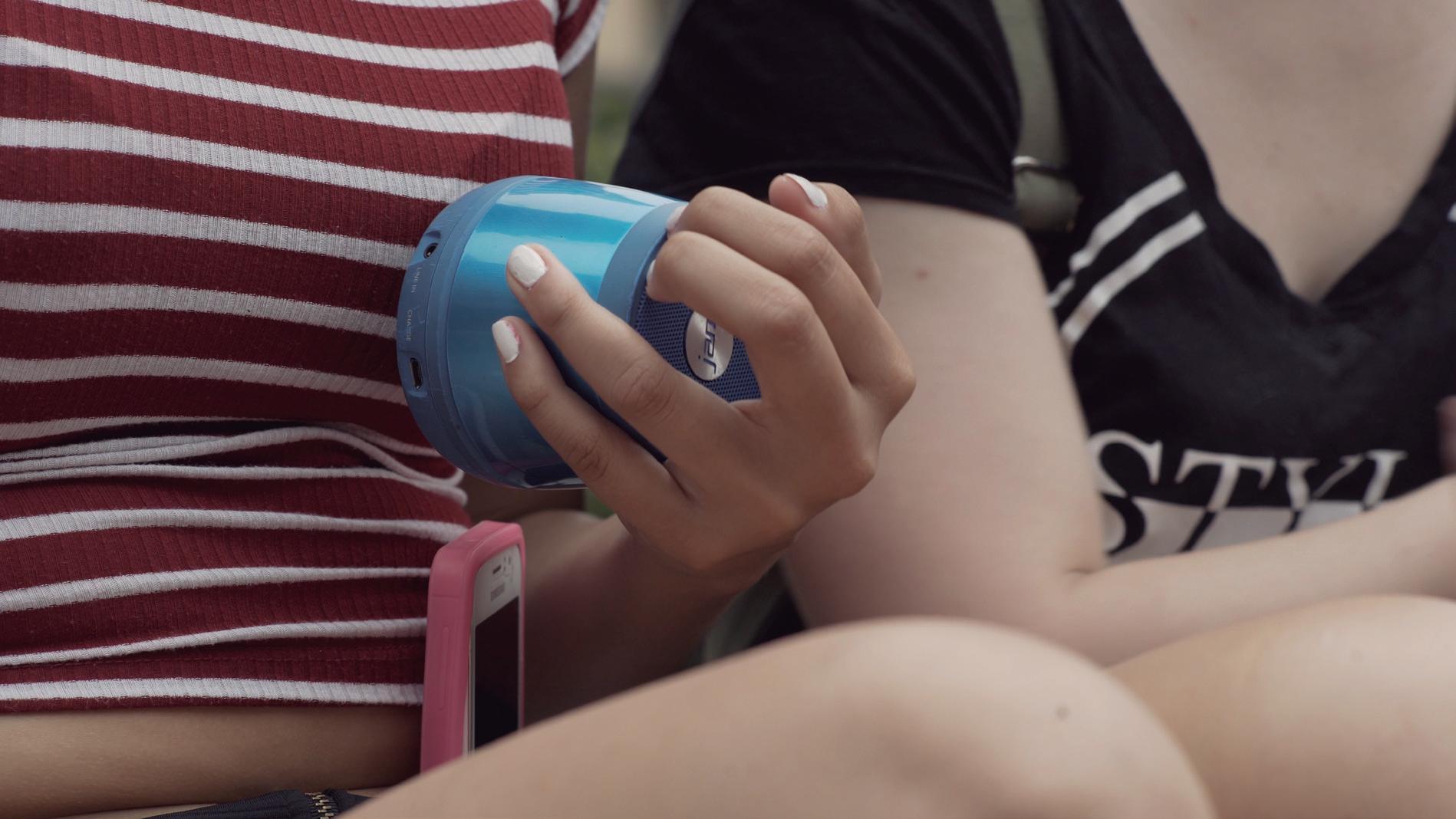
108

109

110
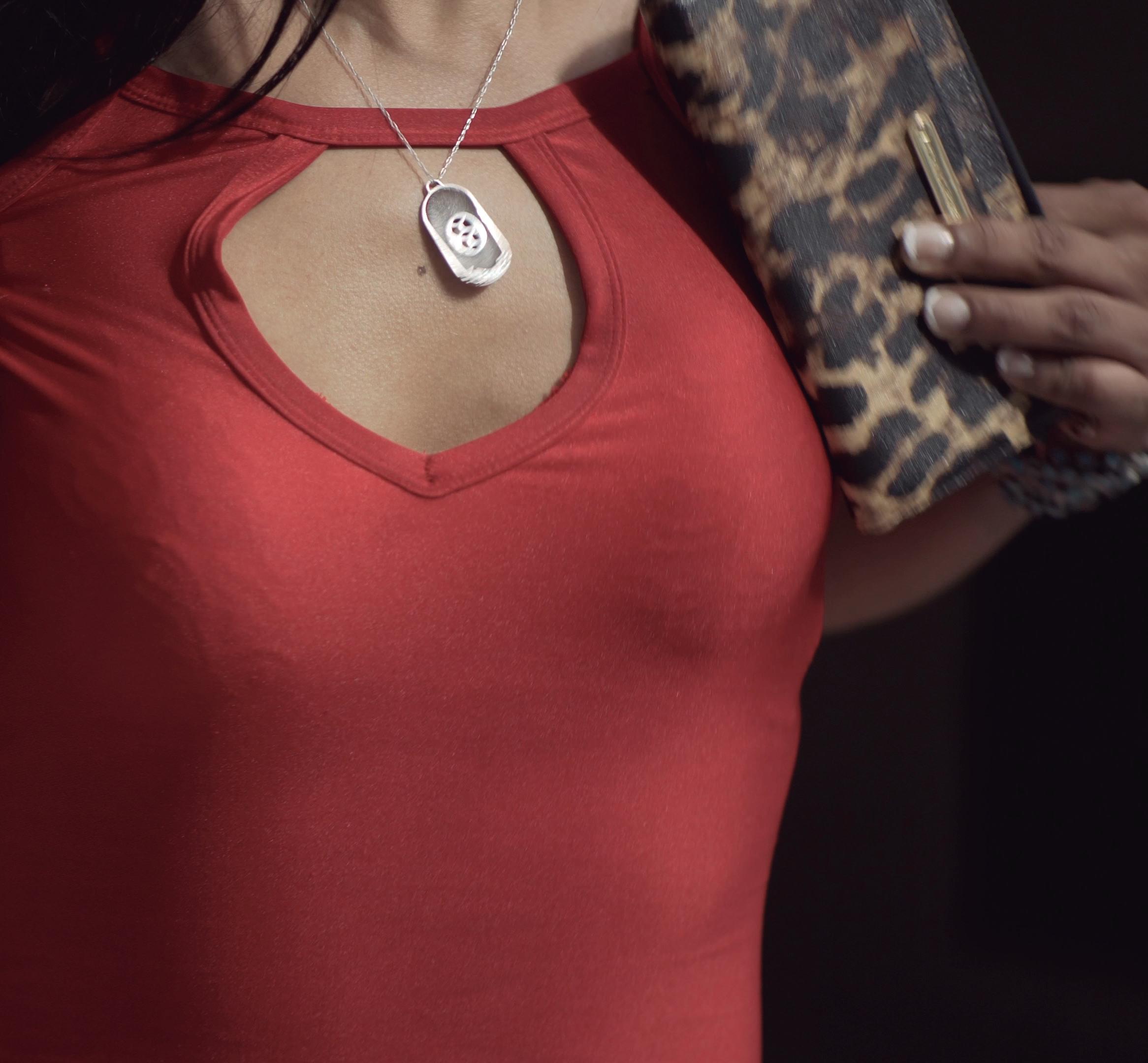
111
Las doscientas cosas que te dije
Por Mariano Blatt
¿Hole?… ¿Hole, me escuchás? Te tengo que contar lo que soñé, antes de que se me escape. Bueno, te cuento: leía un texto, en fotocopias, que decía algo así como… ay, se me escapa, era “la tarea del corrector es contracultural más que cultural”, bueno, una lástima que se me escape tan rápido porque decía eso pero de una manera más linda, mejor, como esos textos académicos bien escritos, fluidos, bonitos. Después seguía, y cada vez se me escapa más el sueño así que, obviamente, cada vez va a ser menos lindo mi recuerdo: “El corrector deberá mostrar, no que maneja con perfección la lengua, sino que puede más bien reconocer la cara de la voz del texto”. Ahí, no sé por qué o no sé cómo, pero hablaba de una tal Cristina, que estaba llegando un poquito tarde a tomar un tren en la Londres del siglo diecinueve, pero estaba tranquila porque sabía que los ferrocarriles ingleses no eran puntuales. “Pero lo que Cristina no sabe es que en la nueva Inglaterra”, decía el texto, y esa frase en el sueño era así tal cual como te la dije, aunque la que sigue ya no: “los trenes ya no son lo que eran”. Obviamente esta última parte de la frase era mucho más linda que esa vulgar “ya no son lo que eran”. A quién se le ocurriría escribir “ya no son lo que eran” en un texto académico sobre la historia de la corrección, ¿no? Solamente a mí, que se me escapa el sueño. Bueno, volviendo al texto, mientras leía esto el tren
iba saliendo de la estación, que era una estación fluvial, creo yo, porque enseguida la vía bordeaba la ciudad por arriba del río. ¿La tarea del corrector sabés cuál era? Despachar el tren. No sé por qué me aparece la palabra mandolín ahora, como que el corrector era el mandolín del tren y cerraba la última puerta y decía cuándo había que salir. Y Cristina no llegaba y el tren bordeaba Londres y el texto fotocopiado era en realidad imagen en movimiento. Bueno, no sé, qué lástima que no estés, me voy a buscar en el diccionario la palabra mandolín a ver si tiene alguna relación con los trenes. Llamame cuando escuches esto, voy a estar acá en casa, con los diccionarios. Qué lindo sueño, no sabés, qué lástima que no estés. Bueno, chau, un beso, ¿me llamás? Bai.
Hole, bueno, disculpá que te llame de nuevo tan rápido, pero te quería contar, antes de que me olvide, que al final no encontré el diccionario (¿vos sabés dónde puede haber quedado?) pero sí encontré los libros de historia inglesa en inglés que usábamos en el secundario, ¿te acordás? Los de la industrial revolution, the invencible armada, the first world war, con esos dibujos de los telares gigantes en galpones oscuros y húmedos con cientos de mujeres y niños trabajando en condiciones espantosas. ¿Te acordás de la historia que nos contaba Miss Sheridan sobre que
113
contrataban chicos chiquitos porque podían meterse por entre los resquicios de los telares y arreglarlos? ¿Y te acordás cómo nos corregía la pronunciación? Al final valió la pena, ¿no? Digo, porque vos estás allá en Londres, hablando perfecto inglés y dirigiendo esa institución de… de… ay, nunca me acuerdo bien, ¿qué es lo que hacés en Londres exactamente? Bueno, llamame si escuchás esto y sabés dónde pueden estar los diccionarios. Te mando un bese, chau. Sabés que me quedé pensando en lo que te conté el otro día, ¿te acordás? El sueño ese de Cristina y el corrector, que en un momento creo que dije algo como que el tren salía de una estación fluvial. Cuánta imperfección, ¿no? ¿Cómo podría un tren salir de una estación fluvial? ¿Estación fluvial no son las de los barcos?
¿O esos son los puertos? Ay, siempre se me olvida todo, cada vez más. Te digo que ya ni los trenes me acuerdo bien qué eran. Bueno, lo que sí encontré son los diccionarios, estaban abajo de la cama. Bah, de tu cama, de la que usabas cuando vivías acá. No sé quién los habrá guardado ahí. No parece un buen lugar para guardar un diccionario, ¿no? Ah, se me ocurrió algo, ahora que ya los encontré, puedo ir a buscar qué significa fluvial, y de paso veo qué dice de los trenes. Porque, no me vas a creer, pero me olvidé lo que eran. ¿Qué eran los trenes?
Ay, odio que se me olvide todo tanto. Los sueños es normal que se te olviden, ¿no? Pero las palabras, las cosas de todos los días, quísiyo. Bueno, te dejo, voy a ver qué hago. ¿Qué te dije que iba a hacer? ¿Hole? ¿Hole, me escuchás? Bueno, cuando escuches esto llamame, aunque sea a cobro revertido, yo pago, no tengo problema y tengo plata. Beso, te extraño.
¡No sabés lo que me pasó hoy! Hole, antes, ¿no? Bueno, hole. Me compré dos libros, hermosos, uno más lindo que el otro. Uno, el menos lindo que el otro, es sobre historia del lenguaje hablado en todo el mundo y todas las civilizaciones habidas y por haber habido. Una obra monumental de más de dos
mil páginas. El otro, más lindo que el uno, es sobre lingüística inventada, es decir, sobre la ciencia del lenguaje pero sin fundamentos. Un libro de poesía, dirás, exclamarás, te conozco, te imagino, te visua-li-zo, poniéndome esos ojitos de investigador de la lengua escrita, pero no, no es sobre poesía. Es sobre cómo inventar tu propia teoría del lenguaje sin tener que haber leído nada ni saber las reglas de la academia. No, pará, no es sobre eso exactamente, o sea, no te lo estaría sabiendo explicar bien. Es que lo que pasa es que, ¿sabés qué? ¡Me los olvidé! Arriba del mostrador de la librería. Me di cuenta cuando llegué a casa. Y lo peor es que no me acuerdo en qué librería me los compré. Así que estuve hasta recién pegadito al teléfono a ver si me llamaban de alguna librería para avisarme que me los había olvidado, pero hasta ahora nada. Sí, ya sé, debería cortar, por si me están llamando ahora y les da ocupado. Es que me dio tanta risa que me acordé de vos y nada, te quise llamar para contarte. Bueno, si escuchás esto llamame. ¿Cómo está Londres? ¿Hace frío o calor? ¿Qué día es allá? ¿El mismo que acá? Nunca entendí eso. Hole, te dejo este mensajito corto y rápido porque me tengo que ir porque estoy llegando tarde a la reunión pero te quería contar que ayer apenas corté sonó el timbre y era el cadete de la librería que me traía los libros que había comprado y me había olvidado arriba del mostrador, ¿te acordás? Yo no me acordaba, así que le pregunté al chico que quién me mandaba esos libros, que si eran un regalo y que si él sabía quién era el admirador secreto que me mandaba libros en vez de flores, quién podía conocerme tanto, en un momento hasta pensé que habías sido vos entonces le pregunté al cadete si él sabía quién me los mandaba y me dijo que me los había olvidado yo arriba del mostrador pero ¿te digo la verdad? yo no me acuerdo de haber comprado estos libros. Te digo estos porque ahora los tengo acá y los estoy mirando y digo ¿cuándo compré esto? Uno es una novela de espías de saldo que no conozco y cuya traducción gallega es horrible, pero
114
horrible-horrible, tipo nah, así no, mierda carajo, ¿o era carajo mierda? Te acordás de esa frase, ¿quién la decía? Ay, qué gracioso, nosotros la decíamos siempre, ¿no? Mierda carajo, ja, ja, qué risa. Bueno, y el otro libro no sé de qué es porque está en otro idioma que no identifico cuál es. En fin, no sé para qué me compro cosas que después no leo, ¿no? “¡Porque puedo!”, dirías vos. Ay, no sabés cómo te extraño, cómo extraño hablar con vos. ¿Te acordás cuando jugábamos a hacer diálogos larguísimos todo de frases hechas o del acervo popular? Qué lástima que ya no tenga a nadie para jugar a eso. ¿Sabés quién me llamó el otro día? Cristina, ¿te acordás? La que perdía el tren en la Londres del siglo diecinueve. Un plato, tenía una pronunciación hermosa. Me imagino que vos ya debés hablar así, ¿no? Como un inglesito hecho y derecho. ¿Por qué no me llamás? ¿Estás muy ocupado? Bueno, te dejo, que llego tarde a… a… ¿a dónde tenía que ir? Bueno, llamame cuando escuches esto, es urgente.
Hole, disculpá que no te haya llamado antes, me pasaron cosas. Igual estoy bien. Te llamo más tarde, si escuchás esto no me llames porque no voy a estar en casa y creo que el contestador no anda bien, porque nunca tengo ningún mensaje de nadie y creo que no se graban los mensajes. Chau, no me llames, eh. Chau. No me vas a llamar, ¿no?… ¿Te diste cuenta? Estoy jugando a la inversa psicológica, una técnica que leí en el diccionario de psicología aplicada. Bueno, chau, no voy a estar esperando tu llamado porque no me anda la contestadora y porque no tengo tiempo de esperar tu llamado, aparte un poco ya me olvidé de vos, que te fuiste hace tanto tiempo a vivir a no sé dónde para hacer no sé qué porque te creés la muy importante con tu título de no sé qué cosa especializada en no sé cuál otra. ¿Sabés qué? No me importa, porque yo estoy aplicando inversidad psicológica para toda la gilada y bien cabida se la tienen. Basta de libros, ahora
me dedico al situacionismo gestáltico y a todo lo que tenga que ver con neurociencia aplicada al lenguaje distributivo. Los factores del producto no alteran el orden, mi amor. Chau, llamame. “Hole, habla Cristina, la que perdió el tren. Quería saber si había pasajes para mañana, porque tengo que ir a Leeds y después a Liverpool a comprar maquinaria para mi taller de la industrial revolution. Llamame cuando escuches esto, por favor, que lo de los pasajes es urgente. Perdí el tren porque llegué tarde a la estación fluvial. Mi reloj ya no marca las horas desde que te fuiste”. ¿Te gustó? Es un poema que estoy escribiendo. Bueno, llamame y contame qué te parece, si sigo o si te parece mejor que vaya por otro lado. Si vos me das ánimo, lo sigo. Editor creo que ya tengo. Beso, llamame y decime cosas lindas. Hace mucho no escucho tu voz, ¿vos?, ¿escuchás mi voz?
“Recuerdos, ¿qué son los recuerdos? Olvidos, ¿qué son los olvidos? El tiempo, ¿siempre es puntual?”. Otra parte del poema. Lo de editarlo está bien encaminado. Besos, sigo escribiendo, chau, llamame. Bueno, estoy enojado. Hace mucho que no sé nada de vos ni de mí. Sólo sé que estoy acá sentado mirando una pared que no entiendo qué es. Mi casa está llena de libros pero me olvidé cómo se usan y para qué sirven. Encontré papeles en otro idioma abajo de tu cama y, arriba de la mía, encontré unas hojas manuscritas con mi letra, muchas, más de cien, con un poema épico larguísimo, sobre una tal Cristina y un tren. El poema es hermoso, y por la letra te diría que lo escribí yo en algún momento, pero no me acuerdo cuándo ni por qué. Así están las cosas país, mierda carajo, y se las hemos contado. En la parrilla no pueden faltar, los chorizos extra Cativelli. Eso no sé por qué lo dije, pero lo tenía que decir. Al vino blanco, en el tuco o al pan, chorizos extra hay que saborear. ¿Eso lo dije yo? ¿Hole? ¿Vos estás escuchando esto? Llamame, por favor, necesito que alguien me llame. Bueno, no me acuerdo cuándo fue la última vez que te llamé, pero han pasado cosas. Para empezar, me
115
publicaron el poema épico sobre trenes y fue un éxito. Ay, si vieras toda la gente que vino a la presentación. Nadie. Parece que voy a ganar un premio y hasta es posible que una beca de una institución extranjera. Sí, así como lo escuchaste: ex-tran-je-ra. ¿Vos sabés qué significa eso? Porque yo no, y hace días que no encuentro el diccionario. Bueno, mi editor está contentísimo, parece que el libro se está vendiendo muchísimo. Ninguno. Yo plata todavía no vi, pero bueno, vos y yo sabemos que es así. Acá el que no corre vuela y dios le dio pan a la que no tenía dientes. Pero no quiero sacar los trapitos al sol y además, a caballo regalado no se le peinan las crines. Lo que voy a necesitar es que me pases tu dirección, así te hago llegar un ejemplar del libro. Sí, ya sé lo que estás pensando, que si me das tu dirección voy a ir a visitarte personalmente y todos sabemos que ni vos ni yo queremos vernos las caras. Porque lo que vos me hiciste no tiene perdón. No te preocupes, yo a vos no te voy a ver más. No me interesa. Estuve hablando con Cristina, las cosas se van a arreglar solas. Ha mejorado mucho el servicio ferroviario londinense y al parecer, es probable aunque no seguro, así que no te emociones, pero, podría ser, aparentemente, dada la posibilidad, estaría ocurriendo en breve una situación que si todo sale bien y los astros se alinean es altamente factible que en el mes entrante me tengas nada más y nada
menos que a mí in situ, in personae, de facto, habeas corpus y habeas data, ergo, op cit, dirigiendo una importante, por no decir importantísima, por no decir mega súper prestigiosa, institución inglesa dedicada específicamente al tema de los vínculos entre lengua y ferrobaires anuncia la partida de su servicio de la hora veinticinco con destino a la ciudad de Chivilcoy, por plataforma duuuce. Bueno, llamame y te cuento más. Beso, te quiero, te extraño, te oigo, te sueño, te escucho, te acaricio suavemente las orejas hasta que te quedes dormido en mi regazo volviendo en un taxi tarde en la noche mientras las luces de neón se reflejan en la ventanilla y pongo cara de nostalgia por lo que se va y no me acuerdo, y por lo que vendrá y aún no sabemos: ¿el amor?, ¿la salvación?, ¿un poema?, ¿los amigos?, ¿la luz anaranjada de la mañana colándose por las rendijas de la persiana? Cuántas cosas, cuántas ideas, y todas milenarias. Llamame, llamame si querés que te haga sentir bien.
116
The two hundred things I told you
By Mariano Blatt
Hullo…? Hullo, can you hear me? I have to tell you this dream I had, before it slips away. All right, here goes: I was reading a text, a photocopy, that said something like… ah, it’s slipping away, it was “the work of the proofreader is countercultural rather than cultural,” and well, it’s a shame I’ve forgotten it so quickly because it said that but in a much nicer way, much better, like those well-written academic texts, flowing all pretty. Then it went on, and I’m forgetting more and more by the minute so, obviously, my memory of it isn’t going to be so nice: “The proofreader should show not that they have a perfect mastery of the language, but rather that they can recognize the face of the voice of the text.” And then, I don’t know why and I don’t know how, but it talked about a certain Cristina, who was running late for a train in London in the nineteenth century, but she was relaxed because she knew English trains didn’t run on time. “But what Cristina doesn’t know is that in the new England,” the text said, and that line in the dream was exactly as I just said it, although the one that follows isn’t: “the trains aren’t what they used to be.” Obviously that last part of the line was much nicer than that coarse “aren’t what they used to be.” Who would ever write “aren’t what they used to be” in an academic text on the history of proofreading, right? Only me, because I’m forgetting the dream. So, going back to the text, as I was reading this the train was leaving the station, which was a river station, I think, because straight away the railway went round the city, above the river. Do you know what the proofreader’s job was? To dispatch the train. I don’t know why the word mandolin comes up now, as if the proofreader was the train’s mandolin and closed the last door and said when it had to leave. And Cristina wasn’t going to make it and the train was going round London and the photocopied text was actually a moving image. Well, I don’t know, what a pity you’re not here, I’m going to look up the word mandolin in the dictionary and see if
it has anything to do with trains. Call me when you get this, I’ll be here all day, with the dictionaries. What a nice dream, really, what a pity you’re not here. Anyway, bye bye, kisses, call me, won’t you? Ciao.
Hullo, so, sorry to call you again so soon, but I wanted to tell you before I forget that in the end I couldn’t find the dictionary (any idea where it might have got to?) but I did find the English history books in English that we read at high school, remember? The ones about the industrial revolution, the invincible armada, the first world war, with those drawings of the giant looms in dark, damp warehouses with hundreds of women and children working in shocking conditions. Remember the story that Miss Sheridan told us about how they employed very small children because they could squeeze through the gaps in the looms and fix them? And do you remember how she used to correct our pronunciation. It was all worth it in the end, wasn’t it? I mean, you’re there in London, speaking perfect English and running that institution for the… the… ah, I can never remember, what is it you do in London, exactly? Anyway, call me if you hear this and you know where those dictionaries might be. Big kiss, bye.
You know, I was thinking about what I told you the other day, do you remember? That dream about Cristina and the proofreader, and I think at some stage I said something like how the train left a river station. So inaccurate, right? How could a train leave a river station? Aren’t river stations for boats? Or are those ports? Oh, I always forget everything, more and more each day. I’m telling you, I don’t even remember exactly what trains were. Anyway, I did at least find the dictionaries, they were under the bed. Well, your bed, the one you slept in when you lived here. I don’t know who could have left them there. It doesn’t seem like a good place to leave a dictionary, does it? Ah, I had a thought, now that I’ve found them, I can go and look up what river station
117
means and while I’m there I’ll see what it says about trains. Because, you’re not going to believe this, but I’ve forgotten what they were. What were trains? Oh, I hate forgetting so much. It’s normal for you to forget your dreams, isn’t it? But words, everyday things, whatchagonnado. All right, that’s all, I’ll see what I’ll do about this. What did I say I was going to do? Hullo? Hullo, can you hear me? Anyway, when you get this, call me back, even if it’s reverse charges, I’ll pay, it’s no trouble and I have the money. Kisses, miss you. Guess what happened today! Hullo first, right? I bought two books, beautiful they are, one nicer than the other. The one that’s less nice than the other one is about the history of language spoken all over the world and all the civilizations that have ever existed or ever will. A monumental work of over two thousand pages. The other, nicer than the other one, is about invented linguistics, that is, the science of language but without any foundation. A book of poetry, you might say, or exclaim, I know you, I imagine you, I vi-su-al-ize you, looking at me with those written language researcher eyes, but no, it isn’t about poetry. It’s about how to invent your own theory of language, without having to have read anything or know the academic rules. No, wait, it’s not about that exactly, I mean, I’m not explaining this properly. The thing is, what it is, you know what? I left them behind! On the counter in the bookshop. I realized when I got home. And the worst thing is that I don’t remember which bookshop I bought them in. So I’ve been sitting by the phone until just now, waiting to see whether the bookshop called me to tell me I’d left them there, but so far no luck. Yes, I know, I should hang up, in case they’re calling me now and it’s engaged. It’s just that I found it so funny that I remembered you and, well, I wanted to call you and tell you. Anyway, if you hear this, call me. How’s London? Is it cold or hot? What day is it there? The same one as here? I never got that.
Hullo, this is just to leave you this short and sweet message because I’ve got to dash because I’m late for the meeting but I wanted to tell you that yesterday as soon as I hung up the doorbell rang and it was the delivery boy from the bookshop bringing me the books I’d bought and left on the counter, do you remember? Well I didn’t, so I asked the lad who was sending me books, whether it was a gift and whether he knew who this secret admirer was who
was sending me books instead of flowers, who could possibly know me so well, and for a moment I even thought it might have been you, so I asked the lad whether he knew who was sending them and he said I’d left them on the counter but—honestly?—I don’t remember buying these books. I say these because I’ve got them here now and I’m looking at them and I wonder, when did I buy this? One is a spy novel from the bargain bin that I’ve never heard of and whose Spanish translation is awful, I mean awful-awful, like no way, don’t do it, buggery bollocks, or was it bollocks to buggery? Do you remember that saying, who used to say it? Oh, how funny, we always used to say it, didn’t we? Buggery bollocks, ha ha, how funny. Anyway, I don’t know what the other book is about because it’s in another language and I can’t make it out. Besides, I don’t know why I buy these things if I don’t read them, right? “Because I can!” you’ll say. Oh, you have no idea how much I miss you, how much I miss talking to you. Do you remember when we used to play at doing terribly long dialogues all with commonplaces and well-known sayings? What a pity I don’t have anyone to play that with now. Do you know who called me the other day? Cristina, remember her? The one who was missing her train in London in the nineteenth century. She’s so funny, she has beautiful pronunciation. I imagine you must speak like that by now, no? Like a fully-fledged little Englishman. Why don’t you call me? Are you very busy? Oh well, that’s all from me, I’m going to be late for… for… where did I have to be? Anyway, call me when you get this, it’s urgent.
Hullo, sorry I didn’t call you earlier, some things have happened. I’m fine, all the same. I’ll call you later, if you hear this first don’t call me because I’m not going to be at home and I don’t think the answer machine’s working properly, because I never have any messages from anyone and I don’t think the messages are being recorded. Bye, don’t call me, OK? Bye. You’re not going to call me, are you?... Do you get it? I’m playing reverse psychology, a technique I read about in the dictionary of applied psychology. Anyway, bye, I’m not going to sit around waiting for you to call because my answer machine doesn’t work and because I don’t have time to sit round waiting for you to call, besides, I’ve kind of forgotten you, you went away so long ago to live I don’t know where to do I don’t know what because you think you’re such a big shot with your degree in I don’t
118
know what specialization in I don’t know what. You know what? I don’t care, because I’m applying psychological reverseness for all the stupid sheep and well deserved it is too. No more books, I’m dedicated to gestalt situationism now and everything to do with applied neuroscience applied to distributive language. The factors of the product don’t alter the order, honey. Bye, call me.
“Hullo, this is Cristina, the one who missed the train. I wanted to know if there were any tickets available for tomorrow because I have to go to Leeds and then Liverpool to buy machinery for my industrial revolution workshop. Call me when you get this, please, it’s urgent that I buy the tickets. I missed my train because I got to the river station later. My watch hasn’t told the time ever since you left.” Do you like it? It’s a poem I’m writing. Anyway, call me and tell me what you think, whether I should carry on with it or whether you think it’d be better if it went somewhere else. If you encourage me, I’ll carry on. I think I’ve already found a publisher. Kisses, call me and tell me nice things. It’s been a long time since I heard your voice. How about you? Can you hear my voice?
“Memories, what are memories? Forgetting, what is forgetting? Is time always punctual?” Another part of the poem. The publishing thing is coming along nicely. Kisses, I’ll keep on writing, bye, call me.
All right, I’m angry. It’s been a long time since I heard anything from you or me. All I know is that I’m sitting here staring at a wall and I don’t understand what it is. My house is full of books but I’ve forgotten how to use them or what’s the point of them. I found some papers in another language under your bed, and on mine I found some handwritten pages in my own handwriting, loads, over a hundred, with this really long epic poem, about some woman called Cristina and a train. The poem is beautiful, and judging by the handwriting I’d have to say I wrote it myself at some stage, but I don’t remember when or why. That’s all the news we have time for, Argentina, buggery bollocks, and we have told you it. No barbecue is complete without Cativelli extra chorizos. I don’t know why I said that, but I had to say it. With a glass of white wine, in a pasta sauce or in a sandwich, extra chorizos have to be tasted. Did I say that? Hullo? Are you listening to this? Call me, please, I need someone to call me.
All right, I don’t remember when the last time I called you was, but some things have happened. To begin with, my epic poem about trains was published and it was a hit. Oh, if only you could have seen all the people who came to the launch. No one. It looks like I’m going to win a prize and I might even win a scholarship for a school abroad. Yes, you heard that right, a-broad. Do you know what that means? Because I don’t, and I haven’t been able to find the dictionary for days. Anyway, my publisher is chuffed, it looks like the book is really selling well. None. I haven’t seen any money yet, but hey, you and I know how these things are. Here if you don’t run you fly and god gave bread to those with no teeth. But I don’t want to air my dirty laundry, don’t comb a gift horse’s mane. I’m going to need you to give me your address, so I can send you a copy of the book. Yes, I know what you’re thinking, if you give me your address I’m going to go and visit you personally and we all know that neither you nor I want to see each other. Because what you did to me is unforgivable. Don’t worry, I’m not going to see you anymore. I’m not interested. I was talking to Cristina, things will sort themselves out. The railway service in London has improved greatly and apparently, it’s likely but not certain yet, so don’t get excited, but there may be, apparently, given the possibility, a situation occurring shortly in which if everything works out and the stars are aligned it’s highly feasible that next month you’ll have me no more no less in situ, in personae, de facto, habeas corpus and habeas data, ergo, op cit, running an important, one might say an extremely important, one might say mega super prestigious English school dedicated specifically to the subject of the connection between language and ferrobaires announces the departure of its 25 o’clock service to Chivilcoy, from platform twuuulve. Anyway, call me and I’ll tell you more. Kisses, I love you, I miss you, I hear you, I dream of you, I listen to you, I softly caress your ears until you fall asleep in my lap coming home in a taxi late at night while the neon lights reflect off the window and I make a nostalgic face for what’s ending and I don’t remember, and for what is to come, we still don’t know: love? salvation? a poem? friends? the orange light of morning seeping through the cracks in the blind? So many things, so many ideas, and all age-old ones. Call me, call me if you want me to make you feel good.
119

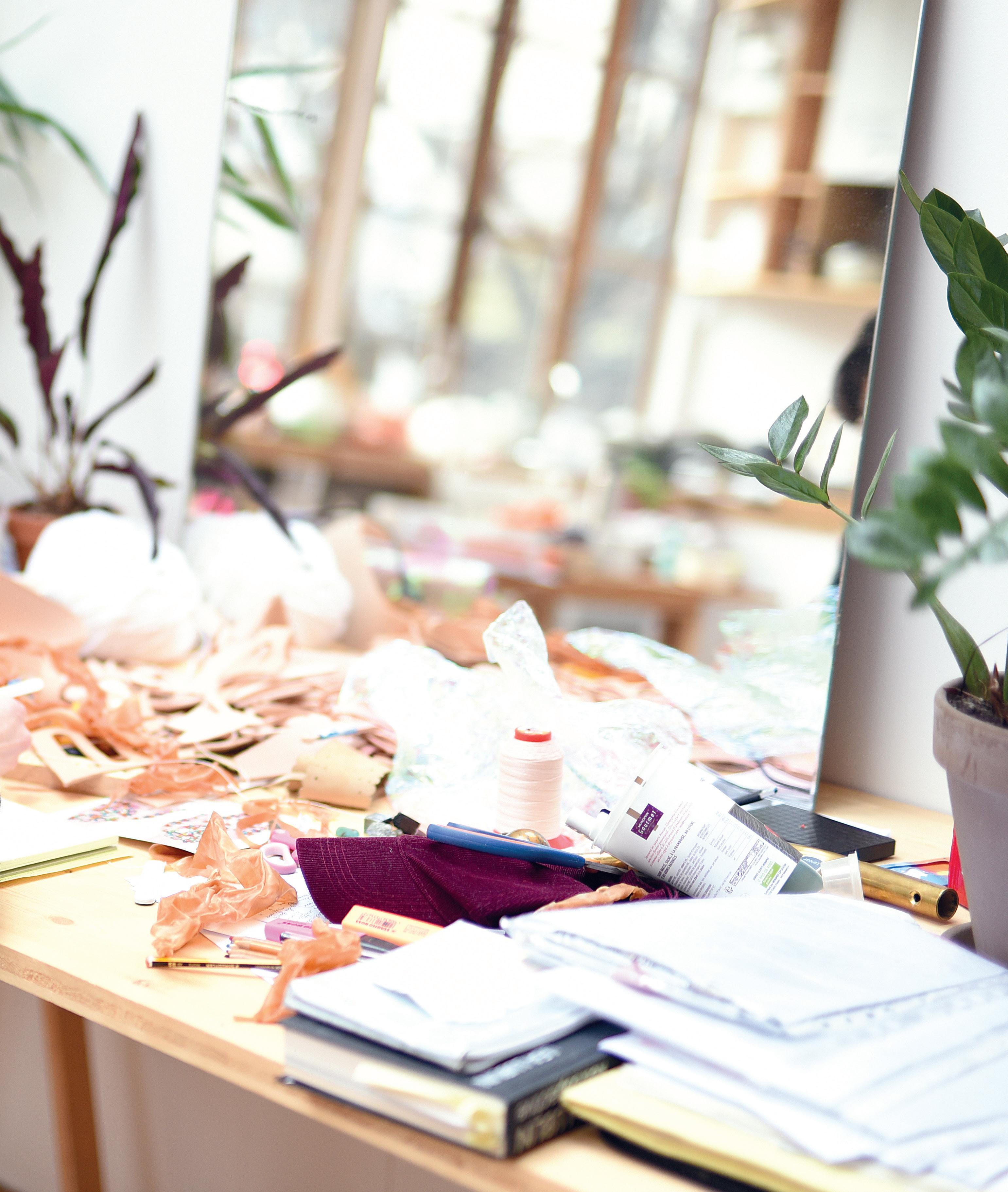
pp. 120-121: Mercedes Azpilicueta en el estudio de Villa Vassillief, París, 2018 [Mercedes Azpilicueta in the studio at Villa Vassillief, Paris, 2018]
BIOGRAFÍAS / BIOGRAPHIES
MERCEDES AZPILICUETA
Mercedes Azpilicueta nació en La Plata en 1981 y creció en Coronel Suárez, Provincia de Buenos Aires. Antes de comenzar su formación como artista realizó dos años de estudios en la carrera de Abogacía e inició la carrera de Antropología, ambas en la Universidad de Buenos Aires. Entre el año 2002 y 2007 completó la Licenciatura en Artes Visuales en el Instituto Universitario Nacional de Artes de Buenos Aires. Luego, en 2009, participó en el Programa de Artistas de la Universidad Torcuato Di Tella, donde realizó clínicas con Jorge Macchi, Mónica Girón y Alejandro Cesarco, entre otros. En esos años también realizó talleres de poesía y escritura con Mariano Blatt y Alfredo Jaramillo.
En 2011 viajó a Holanda para realizar una maestría en el Dutch Art Institute/ArtEZ Hogeschool voor de Kunsten, de Arnhem, y se radicó en ese país. Entre 2015 y 2016 fue seleccionada como artista residente en la Rijksakademie van Beeldende Kunsten, en Ámsterdam, donde vive y trabaja en la actualidad. En 2017 recibió la beca Pernod Ricard Fellowship, gracias a la cual realizó una residencia en Villa Vassilieff/ Bétonsalon, Centre d’art et de recherche, de París. Su trabajo explora las cualidades afectivas del lenguaje y la voz, la dimensión política del deseo femenino y las conexiones entre el cuerpo, la glocalidad y la resistencia a través de abordajes transdisciplinarios. Investiga la performatividad como fuente productora de conocimiento para desarrollar obras procesuales, experimentales y lúdicas con las que
promueve asociaciones conceptuales transhistóricas y la deconstrucción de las estructuras patriarcales de poder que modelan nuestro comportamiento.
En los últimos años presentó sus obras y performances en Het Veem Theatre (Ámsterdam, 2014), Irish Museum of Modern Art (Dublín, 2014), TENT (Rotterdam, 2015), Onomatopee (Eindhoven, 2016), Chinese European Art Center (Xiamen, 2017), Centro de Arte 2 de Mayo (Móstoles, 2017), D21 Kunstraum (Leipzig, 2018), Museion (Bozen, 2018), MACBA (Barcelona, 2018), Museo Jumex (México DF, 2018), Villa Vassilieff (París, 2018) y Pacific Standard Time LA/LA, Getty Foundation, REDCAT / CalArts Gallery (Los Ángeles, 2018).
Entre sus exposiciones individuales se encuentran Todo afuera adentro en Móvil (Buenos Aires, 2015), Geometric Dancer Doesn’t Believe in Love, Finds Aspiration and Ecstasy in Spirals en Slyzmud (Buenos Aires, 2016) y On Affection, en NoguerasBlanchard (Barcelona, 2017)
Cuerpos Pájaros, en el Museo de Arte Moderno de Buenos Aires (2018), es la primera gran exposición individual de su trabajo.
123
MERCEDES AZPILICUETA
Mercedes Azpilicueta was born in La Plata in 1981 and grew up in Coronel Suárez, Province of Buenos Aires. Before starting her artistic education she spent two years studying Law at the Universidad de Buenos Aires, where she also began a degree in Anthropology. From 2002 to 2007 she completed her degree in Visual Arts at the Instituto Universitario Nacional de Artes de Buenos Aires. Then in 2009 she participated in the Artists’ Program at the Universidad Torcuato Di Tella, where she attended workshops with Jorge Macchi, Mónica Girón and Alejandro Cesarco. In this period she also took part in poetry and writing workshops with Mariano Blatt and Alfredo Jaramillo.
In 2011 she moved to the Netherlands to pursue a master’s at the Dutch Art Institute/ArtEZ Hogeschool voor de Kunsten in Arnhem, and decided to settle there. In 2015 and 2016 she was selected as a resident artist at the Rijksakademie van Beeldende Kunsten, in Amsterdam, where she currently lives and works. In 2017 she was chosen as a Pernod Ricard Fellow, allowing her to do a residency at Villa Vassilieff, part of the Bétonsalon art and research center in Paris. Her work explores the affective qualities of language and the voice, the political dimension of female desire, and the connections between the body, glocality, and resistance through transdisciplinary approaches. She investigates performativity as a source that produces knowledge to develop process-based, experimental, ludic works to promote conceptual
transhistorical associations and the deconstruction of patriarchal power structures that model our behavior.
In recent years she has presented her works and performances at Het Veem House for Performance (Amsterdam, 2014), Irish Museum of Modern Art (Dublin, 2014), TENT (Rotterdam, 2015), Onomatopee (Eindhoven, 2016), Chinese European Art Center (Xiamen, 2017), Centro de Arte 2 de Mayo (Móstoles, 2017), D21 Kunstraum (Leipzig, 2018), Museion (Bozen, 2018), MACBA (Barcelona, 2018), Museo Jumex (Mexico City, 2018), Villa Vassilieff (Paris, 2018) and Pacific Standard Time LA/LA, Getty Foundation, REDCAT/CalArts Gallery (Los Angeles, 2018).
Her solo exhibitions include Todo afuera adentro [Everything outside inside] at Móvil (Buenos Aires, 2015), Geometric Dancer Doesn’t Believe in Love, Finds Aspiration and Ecstasy in Spirals at Slyzmud (Buenos Aires, 2016) and On Affection, at NoguerasBlanchard (Barcelona, 2017). Cuerpos Pájaros [Body-Birds], at the Museo de Arte Moderno de Buenos Aires (2018), is the first major solo exhibition of her work.
124
AUTORES INVITADOS / GUEST AUTHORS
Virginie Bobin desarrolla proyectos curatoriales colaborativos que toman la forma de exposiciones, publicaciones, seminarios y escritos. Trabajó como curadora en instituciones internacionales como Villa Vassilieff, Bétonsalon - Center for Art and Research y Witte de With Center for Contemporary Art, entre otras. Escribió este texto originalmente en francés.
Virginie Bobin develops collaborative curatorial projects that take the form of exhibitions, publications, seminars and writing. She has curated in international institutions including Villa Vassilieff, Bétonsalon art and research centre and Witte de With Center for Contemporary Art. She wrote the original text in French.
Mariano Blatt es poeta, editor y escritor. Publicó, entre otros títulos, 200 ideas de libros (Iván Rosado, 2017) y Mi juventud unida (Mansalva, 2015). Dirige la editorial Blatt & Ríos junto con Damián Ríos.
Mariano Blatt is a poet, editor, and writer. His books include 200 ideas de libros (Iván Rosado, 2017) and Mi juventud unida (Mansalva, 2015) He directs the publishing house Blatt & Ríos with Damián Ríos.
AGRADECIMIENTOS DE LA ARTISTA
Gracias a Ohad Ben Shimon y Victoria Azpilicueta por ser mi sostén emocional. A Virginie Bobin, Mariano Blatt, Marina Lazo, Alan Segal, Azul Demonte, Rodrigo Sobarzo de Larraechea, Lucile Sauzet, Agustina Muñoz, Tiago Worm Tirone y Laura Fernández Antolín, por haber contribuido de forma extraordinaria a la producción de esta muestra. A Victoria Noorthoorn, por su generosa invitación y por confiar en mi trabajo; a Laura Hakel por su trabajo excepcional y su diálogo sincero sostenido a lo largo de este año y medio, y a todo el equipo maravilloso del Museo de Arte Moderno de Buenos Aires, quienes con tanto esfuerzo hicieron esta muestra posible. A Villa Vassilieff / Bétonsalon - Centre d'art et de recherche y a la Rijksakademie van Beeldende Kunsten, por su constante apoyo A mis padres, hermanas y hermanos, y a toda mi familia extendida, por su amor incondicional y por siempre estar a mi lado más allá de toda distancia cósmica o transatlántica.
ARTIST’S ACKNOWLEDGEMENTS
My thanks go to Ohad Ben Shimon and Victoria Azpilicueta for their emotional support. To Virginie Bobin, Mariano Blatt, Marina Lazo, Alan Segal, Azul Demonte, Rodrigo Sobarzo de Larraechea, Lucile Sauzet, Agustina Muñoz, Tiago Worm Tirone and Laura Fernández Antolín for their extraordinary contributions to this exhibition. To Victoria Noorthoorn for her generous invitation and for trusting in my work; to Laura Hakel for her exceptional work and the sincere conversations we’ve shared over the past year and a half; and the wonderful team at the Museo de Arte Moderno de Buenos Aires whose efforts made this exhibition possible. To Villa Vassilieff / Bétonsalon - Centre d’art et de recherche and the Rijksakademie van Beeldende Kunsten for their constant support. To my parents, siblings and the rest of my family for their unconditional love and for always being with me, however far away I am cosmically or geographically.
126
LISTA DE OBRAS DE LA EXPOSICIÓN EXHIBITION CHECKLIST
Dear Sister [Querida hermana], 2011 Video-instalación [Video installation]
8 min, 23 s
Volver a casa expandiendo la voz [Back Home Expanding the Voice], 2012-2018
Mnemónica visual y video-animación
[Visual mnemonic and video animation]
8 min, 37 s, loop
Animación: Azul del Monte
Sonido: Tiago Worm Tirone
La Calculadora Bien Templada [The WellTempered Calculator], 2013-2018
Mnemónica visual y video-animación
[Visual mnemonic and video animation]
8 min, 26 s
Animación: Azul del Monte
Sonido: Tiago Worm Tirone
Carne [Flesh], 2013-2018
Mnemónica visual y video-animación
[Visual mnemonic and video animation]
6 min, 45 s, loop
Animación: Azul De Monte
Sonido: Tiago Worm Tirone
Pow!, 2014 - 2018
Mnemónica visual y video-animación
[Visual mnemonic and video animation]
8 min, loop
Animación: Azul De Monte
Sonido: Tiago Worm Tirone
Bailarina Geométrica No Cree en el Amor, Encuentra Aspiración y Éxtasis en Espirales [Geometric Dancer Doesn’t Believe in Love, Finds Aspiration and Ecstasy in Spirals], 2015
Instalación [Installation]
Proyecciones en video HD sincronizados sobre hojas de aluminio [Synchronized HD video-projections on aluminum sheets]
12 min, loop
Un Mundo Raro [A Rare World], 2015 Instalación [Installation]
Proyección de video sincronizada en tres canales [Synchronized three-channel video projection]
10 min, loop
yegua-yeta-yuta [mare-jinx-pig], 2015-en curso [2015-ongoing]
Instalación de sonido y mnemónicas visuales [Sound installation and visual mnemonics]
20 min
Molecular Love [Amor molecular], 2016
Video
5 min, 46 s, loop
Concepto y texto [Concept and text]: Mercedes Azpilicueta
Intérpretes [Performers]: Madelyn
Bullard, Eva Susova, Marion Bosetti, Netti Negunen, Alondra Castellanos Arreola, Setareh Fatehi Irani
Voces [Voices]: Anat Spiegel, Mercedes Azpilicueta
Bestiario de Lengüitas [Bestiaire of Tonguelets], 2018
Instalación con wallpaper, piezas textiles y dibujo [Installation with wallpaper, textile pieces and drawing]
Medidas variables [Dimensions variable]
Asistente de diseño [Design assistant]: Lucile Sauzet
Cuerpos Pájaros [Body-Birds], 2018 Proyección de video sincronizada en tres canales [Synchronized three-channel video projection]
20 min, loop
Concepto, texto y voz [Concept, text and voice]: Mercedes Azpilicueta
Cámara [Camera]: Alan Segal
Edición [Editing]: Mercedes Azpilicueta, Alan Segal
Diseño de sonido [Sound design]: Rodrigo Sobarzo de Larraechea
Grabación y edición de voz [Voice recording and edition]: Tiago Worm Tirone
127
CREDITOS
EXPOSICIÓN
Curadora
Laura Hakel
Jefa de exposiciones
Micaela Bendersky
Coordinadora de exposiciones
Miriam Carbia Nagashima
Jefe de diseño y producción de exposiciones
Ivan Rösler
Productores
Marina Gurman
Edgar Lacombe
Asistente de producción
Celina Eceiza
Técnica e iluminación
Soledad Manrique Goldsack
Enrique Martinez
PUBLICACIÓN
Edición general
Gabriela Comte
Edición gráfica y diseño
Eduardo Rey
Autores
Mariano Blatt
Virginie Bobin
Laura Hakel
Edición
Martín Lojo
Corrección de textos
Julia Benseñor
Traducción al inglés
Daniel Tunnard
Kit Maude
Traducción al español
Marcos Maier
Retoque fotográfico
Guillermo Miguens
Producción grafica
Daniel Maldonado
129
MUSEO DE ARTE MODERNO DE BUENOS AIRES
EQUIPO DIRECCIÓN
Directora
Victoria Noorthoorn
Gerente de Operaciones y Desarrollo Institucional
Marina von der Heyde
CURADURÍA
Curador Senior
Javier Villa
Curadora y Coordinadora del Departamento Curatorial
Carla Barbero
Curadora
Laura Hakel
Asistente Curatorial
Marcos Kramer
Curadora Asociada
María Amalia García
Curadores El cine es otra cosa
Andrés Denegri
Gabriela Golder
Curadores Escuchar: sonidos visuales
Leandro Frías
Jorge Haro
Curador de Teatro
Alejandro Tantanian
PATRIMONIO
Asesor de Patrimonio
Marcelo E. Pacheco
Jefa de Patrimonio
Valeria Semilla
Gestión de Colecciones
Helena Raspo
Gestión de Colección de Videoarte y de los Ciclos de Música y Cine
Valeria Orsi
Administración y Registro del Patrimonio
Adrián Flores
Beatriz Montenegro de Antico
Celestino Pacheco
Investigadora
Cristina Godoy
Fotografía
Viviana Gil
CONSERVACIÓN
Jefe de Conservación
Pino Monkes
Conservadoras
Silvia Borja
Diamela Canosa
Asistente de Conservación
Darío Aguilar
EXPOSICIONES
Jefa de Exposiciones Temporarias
Micaela Bendersky
Coordinadora de Exposiciones
Temporarias
Miriam Carbia
Registro de Obra de Exposiciones
Temporarias
Victoria Olivari
DISEÑO Y PRODUCCIÓN DE EXPOSICIONES
Jefe de Diseño y Producción de Exposiciones
Iván Rösler
Coordinadora de Producción
Almendra Vilela
Productores
Agustina Vizcarra
Edgar Lacombe
Marina Gurman
Asistentes de Producción
Daniel Leber
Celina Eceiza
Gonzalo Silva
Iluminación, Sonido y Tecnologías
Jorge López
Asistentes de Iluminación, Sonido y Tecnologías
Claudio Bajersky
Soledad Manrique Goldsack
Enrique Martínez
Asesor Artístico
Jorge Ponzone
COMUNICACIÓN Y MARKETING
Jefe de Comunicación y Marketing
Tomás Peper
Coordinadora de Comunicación
Agustina González Carman
Coordinadora de Prensa
Victoria Onassis
Comunicación Digital
Mariel Breuer
Diseñadora Senior
Lucía Ladreche
Diseñadora Gráfica
Mailén Leita
Coordinador de Eventos
Fernando Rojas Aguiló
Asistente de Producción de Eventos
Milagros Villamil
EDITORIAL
Editora General
Gabriela Comte
Editor Gráfico
Eduardo Rey
Editor
Martín Lojo
Correctora
Julia Benseñor
Traductores
Ian Barnett
Kit Maude
Productor Gráfico
Daniel Maldonado
EDUCACIÓN
Jefa de Educación
Patricia Rigueira
Coordinadora de Educación
Luciana Marino
Coordinadora de Escuelas e Instituciones
Educativas
Agustina Meola
Coordinadora de Programas Públicos
Lucrecia Palacios
Coordinadora de Investigación y Recursos Pedagógicos
Gabriela Gugliottella
Coordinador de Comunidades
Germán Paley
Asistente de Comunidades
Ayelén Rodríguez
Asistente del Programa Universidades
Nicolás Crespo
Asistente del Departamento de Educación
Laila Calantzopoulos
Educadores
Silvina Amighini
Solena Ceccotti
Emmanuel Franco
Flavia Okner
Belén Sanchez
Julián Sorter
BIBLIOTECA
Jefes de Biblioteca
Alejandro Atias
Mónica Lerner
DESARROLLO DE FONDOS
Jefa de Desarrollo de Fondos
Betina Pucciariello
Responsable de Desarrollo de Fondos
Silvia Braun
Coordinadora de Desarrollo de Fondos
Julieta Dal Verme
Coordinadora de Cooperación
Internacional
Verena Schobinger
Coordinadora de Mecenazgo
Isabel Palandjoglou
ADMINISTRACIÓN
Jefe de Administración
Vicente Sposaro
Jefa de Contabilidad y Finanzas
Verónica Velázquez
Asistente de Finanzas
Romina Ortoleva
Asistentes de Administración
Vanesa Bérgamo
Liliana Gómez
Carla Sposaro
SERVICIOS GENERALES
Jefe de Servicios Generales
Gabriel Durán
Soporte de Tecnologías de la Información
Derlis Arrua
Coordinador de Mantenimiento
Hugo Arrúa
Mantenimiento
Rodolfo Amaya
Patricia Ceci
Lino Espínola
Esther González
Rosana Ojeda
Patricia Peletti
Laura Andrea Pretti
Celia Rochi
Juan Cruz Silva
Coordinadores de Seguridad
Fabián Oscar Bracca
Gladis de la Cruz
Rolando Gabriel Ramos
Mesa de Entrada
Agustina Ferrer
Ángeles Foglia
Laura Nuñez
Stella Monteros
Operador de Luminotecnia
César Tula
Guardias de Sala
Susana Arroyo
Hernán Barreto
Patricia Becerra
Silvia Liliana Benítez
Mirta Graciela Castel
Catalina Fleitas
Marcelo Kovacs
Alejandro Meg
German Eloy Moreno
Ramiro López Núñez
Boris Nizamiev
Andrea Peirano
Soledad Rodríguez
Magalí Santoro
COMISIÓN DIRECTIVA ASOCIACIÓN AMIGOS DEL MODERNO
Presidente
Larisa Andreani
Vicepresidentes
Roberto Álvarez
Chantal Ferrari de Erdozain
Secretario
Gonzalo Hernández
Prosecretario
Abelardo Guaglianone
Tesorero
Andrés Arfuch
Protesorero
Gabriel Vázquez
Vocales
Pablo Blanco
Eliana Castaño Herrera
Belén García Pinto
Alixandre Gutiérrez
Miguel Ángel Gutiérrez
Asunción Laiseca
José Luis Lorenzo
Mario Rodríguez Traverso
David Tonconogy
Andrés Zenarruza
Vocales Suplentes
Francesca Amelotti de Duhau
Helena Estrada
Daniela Marcuzzi de Saguier
Revisor de Cuentas
Ignacio Marseillán
Revisora de Cuentas Suplente
Carolina Del Corral
Comisión de Honor
Emilio Ambasz
Fernanda Brunelli de Galli
Mercedes Cornejo de Espinosa Paz
Mariana Juliana Eppinger
Eduardo García Mansilla
Franco Livini
Marcelo Podestá
Cristiano Santiago A. Rattazzi
Santiago Sanchez Elía
Miguel Santarelli
Juan Augusto Vergez
ALIADO ESTRATÉGICO ANUAL
MEDIO ASOCIADO:



AUSPICIA COLABORAN
Para este libro se utilizó la tipografía Corbel para los textos y títulos; se terminó de imprimir en Akian Gráfica Editora, Clay 2972, Buenos Aires, Argentina
8




























































































